Microsoft RM-100 GSM E900/1800/1900 WCDMA2100 Cellular Phone User Manual P2638 en
Microsoft Mobile Oy GSM E900/1800/1900 WCDMA2100 Cellular Phone P2638 en
Contents
- 1. User Guide
- 2. Manual
Manual

Nokia N92-1
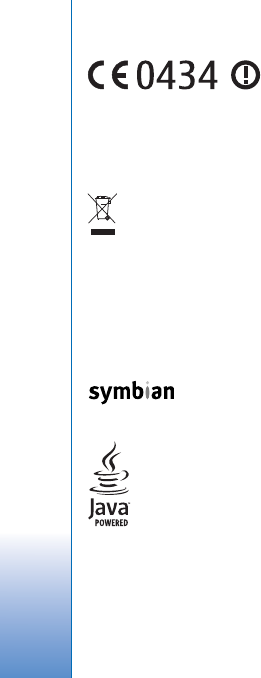
Copyright © 2006 Nokia. All rights reserved.
DECLARATION OF CONFORMITY
Hereby, NOKIA CORPORATION declares
that this RM-100 product is in
compliance with the essential
requirements and other relevant
provisions of Directive 1999/5/EC. A copy
of the Declaration of Conformity can be
found at http://www.nokia.com/phones/
declaration_of_conformity/
The crossed-out wheeled bin means that within the European Union the
product must be taken to separate collection at the product end-of-life.
This applies to your device but also to any enhancements marked with
this symbol. Do not dispose of these products as unsorted municipal
waste.
Copyright © 2006 Nokia. All rights reserved.
Reproduction, transfer, distribution or storage of part or all of the contents in this
document in any form without the prior written permission of Nokia is prohibited.
Nokia, Nokia Connecting People, Pop-Port, and Visual Radio are trademarks or
registered trademarks of Nokia Corporation. Other product and company names
mentioned herein may be trademarks or tradenames of their respective owners.
Nokia tune is a sound mark of Nokia Corporation.
This product includes software licensed from Symbian Software Ltd (c) 1998-
200(6). Symbian and Symbian OS are trademarks of Symbian Ltd.
Java™ and all Java-based marks are trademarks or registered trademarks of Sun
Microsystems, Inc.
Stac ®, LZS ®, ©1996, Stac, Inc., ©1994-1996 Microsoft Corporation. Includes one
or more U.S. Patents: No. 4701745, 5016009, 5126739, 5146221, and 5414425.
Other patents pending.
Hi/fn ®, LZS ®,©1988-98, Hi/fn. Includes one or more U.S. Patents: No. 4701745,
5016009, 5126739, 5146221, and 5414425. Other patents pending.
Part of the software in this product is © Copyright ANT Ltd. 1998. All rights reserved.
US Patent No 5818437 and other pending patents. T9 text input software Copyright
(C) 1997-2005. Tegic Communications, Inc. All rights reserved.
This product is licensed under the MPEG-4 Visual Patent Portfolio License (i) for
personal and noncommercial use in connection with information which has been
encoded in compliance with the MPEG-4 Visual Standard by a consumer engaged
in a personal and noncommercial activity and (ii) for use in connection with
MPEG-4 video provided by a licensed video provider. No license is granted or shall
be implied for any other use. Additional information, including that related to
promotional, internal, and commercial uses, may be obtained from MPEG LA, LLC.
See <http://www.mpegla.com>.
Nokia operates a policy of ongoing development. Nokia reserves the right to make
changes and improvements to any of the products described in this document
without prior notice.
Under no circumstances shall Nokia be responsible for any loss of data or income
or any special, incidental, consequential or indirect damages howsoever caused.
The contents of this document are provided ‘as is’. Except as required by applicable
law, no warranties of any kind, either express or implied, including, but not limited
to, the implied warranties of merchantability and fitness for a particular purpose,
are made in relation to the accuracy, reliability or contents of this document. Nokia
reserves the right to revise this document or withdraw it at any time without prior
notice.
The availability of particular products may vary by region. Please check with the
Nokia dealer nearest to you.
This device may contain commodities, technology, or software subject to export
laws and regulations from the US and other countries. Diversion contrary to law is
prohibited.
FCC / INDUSTRY CANADA NOTICE
Your device may cause TV or radio interference (for example, when using a
telephone in close proximity to receiving equipment). The FCC or Industry Canada
can require you to stop using your telephone if such interference cannot be
eliminated. If you require assistance, contact your local service facility. This device
complies with part 15 of the FCC rules. Operation is subject to the condition that
this device does not cause harmful interference.
Issue 1 EN, 9246540

Copyright © 2006 Nokia. All rights reserved.
Contents
For your safety...........................................6
Your Nokia N92.........................................9
Modes ....................................................................................... 9
Mobile TV...............................................................................11
Media keys.............................................................................11
Multimedia key ....................................................................11
Useful shortcuts...................................................................11
Settings ..................................................................................12
Nokia support and contact information .......................12
Transfer content from another device...........................12
Essential indicators.............................................................13
Keypad lock (keyguard)......................................................14
Volume and loudspeaker control ....................................15
Clock........................................................................................15
Headset...................................................................................16
Memory card.........................................................................16
Help .........................................................................................17
Tutorial ...................................................................................17
Mobile TV ................................................ 18
First start-up.........................................................................18
View programs......................................................................18
Services ..................................................................................19
Program guide......................................................................19
Record programs .................................................................20
Watch recorded programs................................................21
Search.....................................................................................21
Subscribe to channel packages, channels, and
programs................................................................................21
Settings..................................................................................22
Indicators...............................................................................23
Camera......................................................24
Take pictures.........................................................................24
Tips on taking good photographs...................................27
Record videos .......................................................................28
Gallery.......................................................30
View images and video clips............................................30
Edit images ...........................................................................31
Image print ...........................................................................32
Presentations........................................................................32
Albums ...................................................................................33
Media applications ..................................34

Copyright © 2006 Nokia. All rights reserved.
Music player......................................................................... 34
RealPlayer.............................................................................. 36
Flash Player...........................................................................37
Visual Radio.......................................................................... 38
Web......................................................................................... 40
Recorder................................................................................. 41
Messaging.................................................42
Write text.............................................................................. 43
Write and send messages................................................. 44
Inbox—receive messages................................................... 46
Mailbox.................................................................................. 48
View messages on a SIM card.........................................50
Messaging settings............................................................. 50
Contacts (phonebook).............................55
Save names and numbers................................................. 55
Copy contacts ...................................................................... 56
Add ringing tones for contacts ....................................... 57
Create contact groups....................................................... 57
Make calls ................................................58
Voice calls .............................................................................58
Video calls............................................................................. 60
Answer or decline a call....................................................61
Log........................................................................................... 63
Services.....................................................65
Access point.......................................................................... 65
Bookmarks view...................................................................65
Connection security............................................................66
Browse.................................................................................... 66
Download and purchase items........................................67
End a connection ................................................................ 67
Settings.................................................................................. 67
Calendar ...................................................69
Create calendar entries .....................................................69
Calendar views.....................................................................69
Manage your calendar entries.........................................70
Calendar settings ................................................................ 70
My own.....................................................71
Go to—add shortcuts..........................................................71
IM—instant messaging ......................................................71
Positioning ............................................................................ 74
Landmarks ............................................................................. 75
Navigator............................................................................... 75
3-D tones...............................................................................77
Nokia Lifeblog .....................................................................77
Games..................................................................................... 80
Connectivity .............................................81

Copyright © 2006 Nokia. All rights reserved.
Bluetooth connectivity ......................................................81
Infrared connection ............................................................84
Data cable..............................................................................85
Synchronization...................................................................85
Wireless LAN.........................................................................87
Connection manager ..........................................................88
Device manager ...................................................................89
Home network......................................................................90
PC connections.....................................................................93
Office ....................................................... 94
Calculator ..............................................................................94
Converter ...............................................................................94
Notes.......................................................................................94
Quickoffice ...........................................................................95
Adobe Reader........................................................................96
Personalize your device .......................... 98
Profiles—set tones...............................................................98
Change the look of your device.......................................99
Active standby mode........................................................100
Tools....................................................... 101
File manager.......................................................................101
Application manager........................................................102
Settings wizard..................................................................104
Settings................................................................................105
Voice commands ...............................................................116
Digital Rights Management...........................................117
Memory card tool..............................................................117
Troubleshooting: Q&A.......................... 119
Battery information ............................. 123
Charging and discharging...............................................123
Nokia battery authentication guidelines....................123
Care and maintenance ......................... 126
Additional safety information............. 127

6Copyright © 2006 Nokia. All rights reserved.
For your safety
Read these simple guidelines. Not following them may be
dangerous or illegal. Read the complete user guide for
further information.
SWITCH ON SAFELY Do not switch the
device on when wireless phone use is
prohibited or when it may cause interference
or danger.
ROAD SAFETY COMES FIRST Obey all local
laws. Always keep your hands free to operate
the vehicle while driving. Your first
consideration while driving should be road
safety.
INTERFERENCE All wireless devices may be
susceptible to interference, which could affect
performance.
SWITCH OFF IN HOSPITALS Follow any
restrictions. Switch the device off near
medical equipment.
SWITCH OFF IN AIRCRAFT Follow any
restrictions. Wireless devices can cause
interference in aircraft.
SWITCH OFF WHEN REFUELING Do not use
the device at a refueling point. Do not use near
fuel or chemicals.
SWITCH OFF NEAR BLASTING Follow any
restrictions. Do not use the device where
blasting is in progress.
USE SENSIBLY Use only in the normal position
as explained in the product documentation. Do
not touch the antenna unnecessarily.
QUALIFIED SERVICE Only qualified personnel
may install or repair this product.
ENHANCEMENTS AND BATTERIES Use only
approved enhancements and batteries. Do not
connect incompatible products.
WATER-RESISTANCE Your device is not
water-resistant. Keep it dry.
BACK-UP COPIES Remember to make back-up
copies or keep a written record of all important
information.
CONNECTING TO OTHER DEVICES When
connecting to any other device, read its user

7
Copyright © 2006 Nokia. All rights reserved.
guide for detailed safety instructions. Do not
connect incompatible products.
EMERGENCY CALLS Ensure the phone
function of the device is switched on and in
service. Press the end key as many times as
needed to clear the display and return to the
start screen. Enter the emergency number,
then press the call key. Give your location. Do
not end the call until given permission to do so.
About your device
The wireless device described in this guide is approved for
use on the EGSM 850/900/1800/1900 and UMTS 2100
networks. Contact your service provider for more
information about networks.
When using the features in this device, obey all laws, and
respect privacy and legitimate rights of others.
When taking and using images or video clips, obey all laws,
and respect local customs as well as privacy and legitimate
rights of others.
The Quickoffice applications in your device support
common features of Microsoft Word, PowerPoint, and
Excel (Microsoft Office 97, 2000, XP, and 2003). Not all
file formats can be viewed or modified.
Warning: To use any features in this device, other
than the alarm clock, the device must be switched on.
Do not switch the device on when wireless device use
may cause interference or danger.
Network services
To use the phone you must have service from a wireless
service provider. Many of the features in this device
depend on features in the wireless network to function.
These network services may not be available on all
networks or you may have to make specific arrangements
with your service provider before you can utilize network
services. Your service provider may need to give you
additional instructions for their use and explain what
charges will apply. Some networks may have limitations
that affect how you can use network services. For
instance, some networks may not support all
language-dependent characters and services.
Your service provider may have requested that certain
features be disabled or not activated in your device. If so,
they will not appear on your device menu. Your device may
also have been specially configured. This configuration
may include changes in menu names, menu order, and
icons. Contact your service provider for more information.
This device supports WAP 2.0 protocols (HTTP and SSL)
that run on TCP/IP protocols. Some features of this device,

8Copyright © 2006 Nokia. All rights reserved.
such as MMS, browsing, e-mail, and content downloading
using the browser or over MMS, require network support
for these technologies.
For availability and information on using SIM card
services, contact your SIM card vendor. This may be the
service provider, network operator, or other vendor.
Enhancements, batteries, and
chargers
Always switch the device off, and disconnect the charger
before removing the battery.
Check the model number of any charger before use with
this device. This device is intended for use when supplied
with power from an AC-3 or AC-4 charger and from an
AC-5 charger when used with the CA-44 charger adapter.
The battery intended for use with this device is BL-5B.
Warning: Use only batteries, chargers, and
enhancements approved by Nokia for use with this
particular model. The use of any other types may
invalidate any approval or warranty and may be
dangerous.
For availability of approved enhancements, please check
with your dealer. When you disconnect the power cord of
any enhancement, grasp and pull the plug, not the cord.
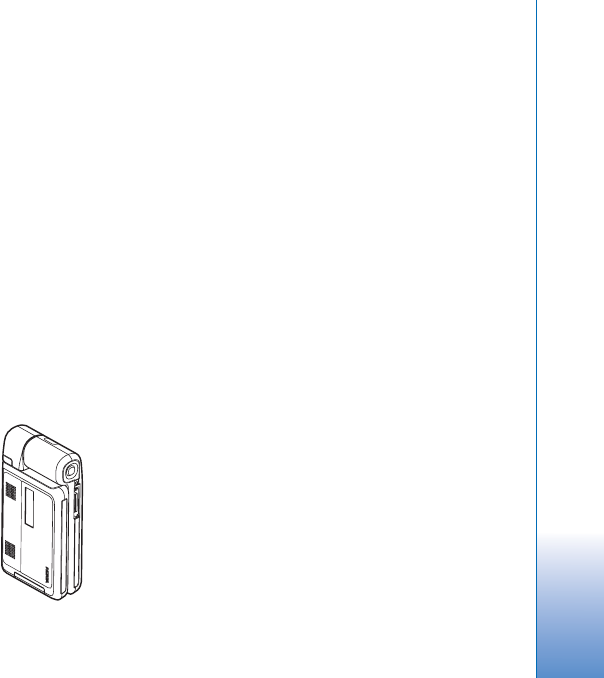
Your Nokia N92
9
Copyright © 2006 Nokia. All rights reserved.
Your Nokia N92
Model number: Nokia N92-1
Hereinafter referred to as Nokia N92.
Modes
Your device has four mechanical modes that are optimized
for different use situations: Fold closed for carrying; Fold
open for traditional mobile phone use; Imaging for
recording video and taking pictures; and View for viewing
Mobile TV, your images, and videos. To switch between the
modes, turn the fold and the swing axis display. There is a
short time-out before a mode is activated.
Fold closed mode
When the fold is closed, the
main display deactivates and the
cover display lights up. Ongoing
calls end, unless the loudspeaker
is in use or a compatible headset
is connected. To change the
settings, see ‘Standby mode’, p.
106. If you are using the radio,
TV, or music player, you can
continue listening to them.
In the Fold closed mode, the cover display provides clock
and status information. When the device is in standby
mode the signal strength and battery indicators, time
information, status indicators, and the name of the active
profile (if other than General) may be shown. If the TV is
switched on, you can view the Mobile TV program channel,
program information, program schedule, and recording
status on the cover display. If you are using the music
player to listen to a sound clip, volume bars and track
information are displayed. Use the side volume key to turn
the volume up or down.
If you are using Visual Radio in the Fold closed mode, the
visual content is not shown on the cover display. You can
store several preset stations with the station name,
frequency, and location information. This information is
shown on the cover display.
Calendar and clock alarms and notes for missed calls and
new received messages are also displayed. To view
received text messages and the text and image objects of
received multimedia messages, open the fold, and view
the message on the main display.
Incoming calls are indicated by their normal tone and a
note. In the cover display settings, select Answer if fold
opened > Yes to answer a call when you open the fold. If

Your Nokia N92
10 Copyright © 2006 Nokia. All rights reserved.
a compatible headset is connected to the device, press the
answer key on the headset. To change the settings, see
‘Standby mode’, p. 106.
To make calls or use the menu, open the fold.
Fold open mode
When you open the fold, the
Fold open mode is activated
automatically: the main
display lights up, the keypad is
available, and you can access
the menu. Scroll in the menu
with the scroll key.
The Fold open mode is
activated even if the fold is
not fully opened. The fold
opens about 160 degrees, as
shown in the picture. Do not force the fold to open more.
Imaging mode
When you open the fold up
to 90 degrees, hold the
device sideways, and turn
the fold up so that the main
display faces you, the
Imaging mode is activated.
The main camera is
activated, and you can see
the view to be captured.
In the Imaging mode, you
can record videos and take pictures. See ‘Camera’, p. 24.
In the Imaging mode, the number keypad is not active. You
can use the capture key, the volume key as a zoom key,
power key, and the selection keys of the keypad.
View mode
When the fold is closed and you lift the side of the swing
axis display, the View mode is activated. The number
keypad uses the white-on-black characters, and the
selection keys below the screen are in use.

Your Nokia N92
11
Copyright © 2006 Nokia. All rights reserved.
Besides using other
applications, you can
use the View mode to do
the following:
• Watch Mobile TV
broadcasts.
• View your images.
•Browse the Web.
• Make hands-free
calls.
Mobile TV
Your Nokia N92 has an integrated digital TV receiver. With
the Mobile TV application you can watch, listen to, and
record digital TV programs. You may have to subscribe to
channels or programs before you can watch them.
Media keys
Media keys are located on all
sides of the scroll key. Use them
to control Mobile TV, video
playback, music player, and radio.
Multimedia key
To open the Mobile TV application, press and hold
multimedia key . To open a multimedia application,
press , and scroll in corresponding direction. To exit
the view without selecting an application, press .
To change the shortcuts, press , and scroll down. To
change the applications that are shown when you press
, select Top, Left, Middle, and Right and the
application.
Some shortcuts may be fixed, and you are not able to
change them.
Useful shortcuts
Use shortcuts to quickly get the most from your device.
Refer to the relevant sections in this user guide for further
details of the functions.
Standby mode
• To open the Mobile TV application, press and hold .
See ‘Multimedia key’, p. 11.
• To switch between applications that are open, press
and hold , and select an application. If memory is
low, the device may close some applications. The
device saves any unsaved data before closing an
application.

Your Nokia N92
12 Copyright © 2006 Nokia. All rights reserved.
Leaving applications running in the background
increases the demand on battery power and reduces
the battery life.
• To call your voice mailbox (network service), press and
hold .
• To change the profile, press , and select a profile.
• To switch between General and Silent profiles, press
and hold . If you have two phone lines (network
service), this action switches between the two lines.
• To open the last dialed numbers list, press .
• To use voice commands, press and hold .
• To start browsing the Web (network service), press and
hold . See ‘Services’, p. 65.
• To adjust the brightness of the display, press the
bottom left corner selection key (in the Fold open
mode) and scroll left or right.
For further shortcuts available in the standby mode, see
‘Active standby mode’, p. 100.
Settings
Your Nokia N92 normally has MMS, GPRS, streaming, and
mobile Internet settings automatically configured in the
device, based upon your service provider or network
operator information. You may have settings from your
service providers already installed in your device, or you
may receive the settings from the service providers as a
special text message.
Nokia support and contact
information
Check www.nokia.com/support or your local Nokia Web
site for the latest version of this guide, additional
information, downloads, and services related to your Nokia
product.
On the Web site, you can get information on the use of
Nokia products and services. If you need to contact
customer service, check the list of local Nokia contact
centers at www.nokia.com/customerservice.
For maintenance services, check your nearest Nokia service
center at www.nokia.com/repair.
Transfer content from
another device
You can copy content such as contacts and calendar
entries from a compatible Nokia phone to your Nokia N92
using Bluetooth connectivity or infrared. The type of
content that can be copied depends on the phone model.

Your Nokia N92
13
Copyright © 2006 Nokia. All rights reserved.
Copyright protections may prevent some images, music
(including ringing tones), and other content from being
copied, modified, transferred or forwarded.
You can insert your SIM card in the other device. When
your Nokia N92 is switched on without a SIM card, the
offline profile is automatically activated.
Transfer content
1Press , and select Tools > Transfer on your Nokia
N92.
2In the information view, select Continue.
3Select whether you want to use Bluetooth connectivity
or infrared to transfer the data. Both devices must
support the selected connection type.
4If you select Bluetooth connectivity, to have your Nokia
N92 search for devices with Bluetooth connectivity,
select Continue. Select your other device from the list.
You are asked to enter a code on your Nokia N92. Enter
a code (1-16 digits), and select OK. Enter the same
code on the other device, and select OK. The devices are
now paired. See ‘Pair devices’, p. 83.
For some phone models, the Transfer application is
sent to the other device as a message. To install
Transfer on the other device, open the message, and
follow the instructions on the display.
If you select infrared, connect the two devices. See
‘Infrared connection’, p. 84.
5From your Nokia N92, select the content you want to
copy from the other device.
Content is copied from the memory and compatible
memory card (if inserted) of the other device to the
corresponding location in your Nokia N92 and memory
card (if inserted). The copying time depends on the
amount of data to be transferred. You can cancel copying
and continue later.
To view the log information of a previous transfer, in the
main view, select Transfer log.
To view the devices you have copied or transferred data
from, in the main view, select Phones.
Essential indicators
The device is being used in a GSM network.
The device is being used in a UMTS network (network
service).
You have one or more unread messages in the Inbox
folder in Messag..
You have received new e-mail in the remote mailbox.
There are messages waiting to be sent in the Outbox
folder.
You have missed calls.

Your Nokia N92
14 Copyright © 2006 Nokia. All rights reserved.
Shown if Ringing type is set to Silent and Message
alert tone, IM alert tone, and E-mail alert tone are set
to Off.
The device keypad is locked.
A clock alarm is active.
The second phone line is being used (network service).
All calls to the device are forwarded to another
number. If you have two phone lines (network service), the
indicator for the first line is and for the second
.
A compatible headset is connected to the device.
A loopset is connected to the device.
A data call is active.
A GPRS or EDGE packet data connection is available.
A GPRS or EDGE packet data connection is active.
A GPRS or EDGE packet data connection is on hold.
A UMTS packet data connection is available.
A UMTS packet data connection is active.
A UMTS packet data connection is on hold.
You have set the device to scan for wireless LANs, and
a wireless LAN is available. See ‘Wireless LAN’, p. 111.
A wireless LAN connection is active in a network that
has encryption.
A wireless LAN connection is active in a network that
does not have encryption.
Bluetooth connectivity is on.
Data is being transmitted using Bluetooth
connectivity.
A USB connection is active.
An infrared connection is active. If the indicator is
blinking, the device is trying to connect to the other device
or the connection has been lost.
Keypad lock (keyguard)
Use the keypad lock to prevent the keys from being
accidentally pressed.
To turn on the display light when the keypad lock is on,
press the power key.
• To lock: In the standby mode, press , then .
When the keys are locked, is shown on the
display.
• To unlock in the Fold open or View mode: Press ,
then .
When the keypad lock is on, calls may be possible to the
official emergency number programmed into your device.

Your Nokia N92
15
Copyright © 2006 Nokia. All rights reserved.
Volume and loudspeaker control
To increase or decrease the volume level when you have an
active call or are listening to a sound, press the side volume
key.
The built-in stereo loudspeaker allows you to speak and
listen from a short distance without having to hold the
device to your ear.
Warning: Do not hold the device near your ear when
the loudspeaker is in use, because the volume may be
extremely loud.
To turn on the loudspeaker during a call, select Options >
Activate loudsp..
To turn off the loudspeaker, select Options > Activate
handset.
To turn the loudspeaker on or off during a call, select
Loudsp. or Handset.
Tip! You can also activate the loudspeaker by using
the View mode.
Clock
Press , and select Clock. To set a new alarm, select
Options > Set alarm. When an alarm is active, is
shown.
To turn off the alarm, select Stop, or to stop the alarm for
5 minutes, select Snooze.
If the alarm time is reached while the device is switched
off, the device switches itself on and starts sounding the
alarm tone. If you select Stop, the device asks whether you
want to activate the device for calls. Select No to switch
off the device or Yes to make and receive calls. Do not
select Yes when wireless phone use may cause
interference or danger.
To cancel an alarm, select Clock > Options > Remove
alarm.
Clock settings
To change the clock settings, select Clock > Options >
Settings.
To change the time or date, select Time or Date.
To change the clock shown in the standby mode, select
Clock type > Analogue or Digital.
To allow the mobile phone network to update the time,
date, and time zone information to your device (network
service), select Network operator time > Auto-update.
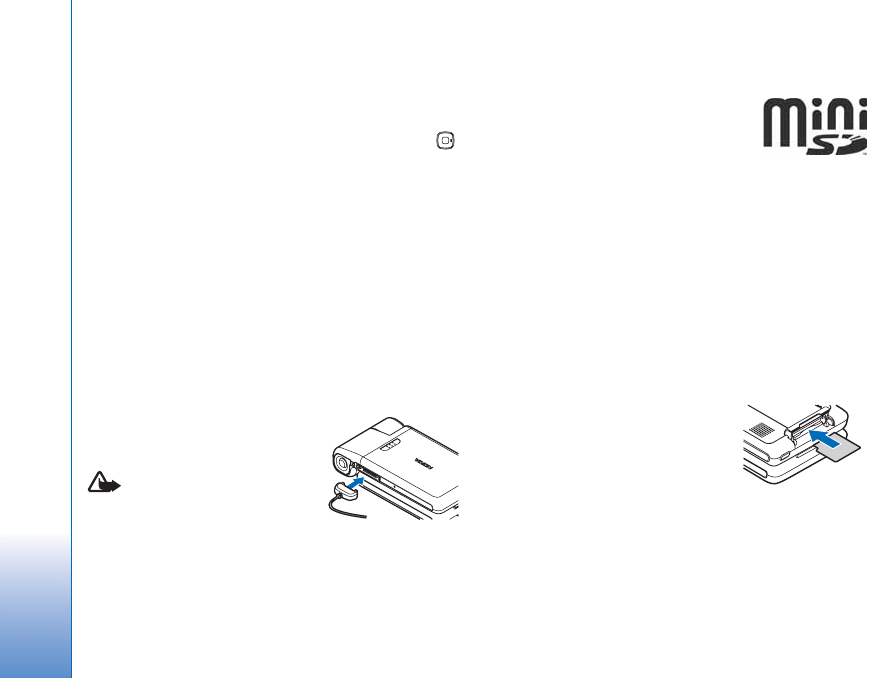
Your Nokia N92
16 Copyright © 2006 Nokia. All rights reserved.
To change the alarm tone, select Clock alarm tone.
World clock
To open the world clock view, open Clock, and press .
In the world clock view, you can view the time in different
cities.
To add cities to the list, select Options > Add city. You
can add a maximum of 15 cities to the list.
To set your current city, scroll to a city, and select
Options > My current city. The city is displayed in the
clock main view, and the time in your device is changed
according to the city selected. Check that the time is
correct and matches your time zone.
Headset
Connect a compatible headset to
the Pop-PortTM iterface system
connector of your device.
Warning: When you use
the headset, your ability to hear
outside sounds may be affected.
Do not use the headset where it
can endanger your safety.
Memory card
Use the miniSD card provided with your
device to save the memory on your
device. You can also back up
information from your device to the
memory card.
Use only compatible miniSD memory cards with this
device. Other memory cards, such as Reduced Size
MultiMediaCards, do not fit in the memory card slot and
are not compatible with this device. Using an incompatible
memory card may damage the memory card as well as the
device, and data stored on the incompatible card may be
corrupted.
Keep all memory cards out of the reach of small children.
Insert the memory card
1Insert the memory card in the
slot. Ensure that the contact
area on the card is facing down.
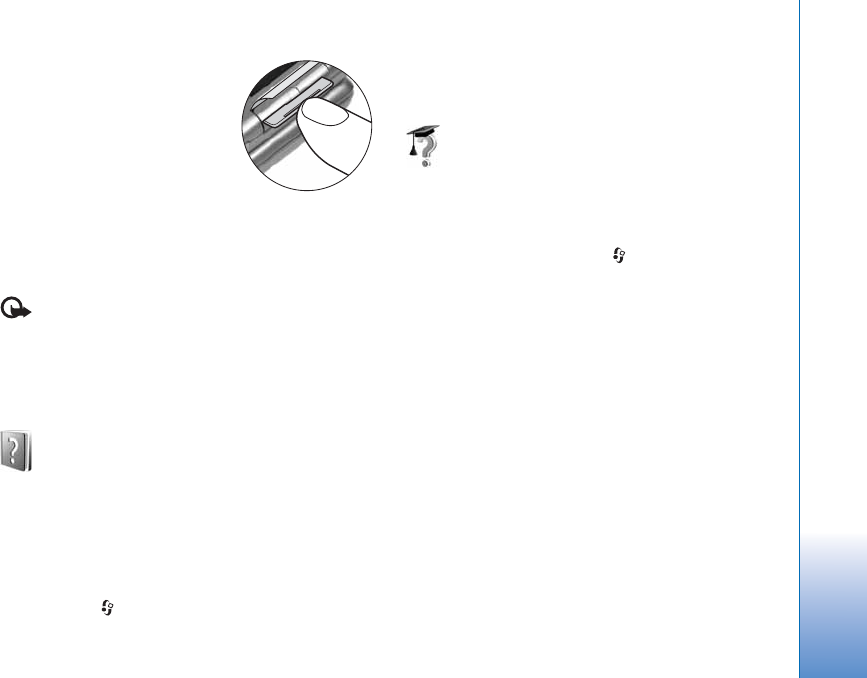
Your Nokia N92
17
Copyright © 2006 Nokia. All rights reserved.
2Push the card in. You hear a
click when the card locks into
place.
Eject the memory card
1Open the memory card slot
hatch. All applications are
closed.
2When Remove memory card
and press 'OK' is displayed, press the memory card to
release it from the slot.
3Remove the memory card. If the device is switched on,
select OK when prompted to confirm the removal.
Important: Do not remove the memory card in the
middle of an operation when the card is being accessed.
Removing the card in the middle of an operation may
damage the memory card as well as the device, and data
stored on the card may be corrupted.
Help
Your device has context-sensitive help. When an
application is open, select Options > Help to access help
for the current view.
When you are reading the instructions, to switch between
help and the application that is open in the background,
press and hold .
To open help from the main menu, select Tools > Help.
Select the desired application to view its help topics.
Tutorial
The tutorial gives you information about some of the
features of your device. The tutorial starts automatically
when you switch the device on for the first time. To access
the tutorial in the menu, press , and select My own >
Tutorial and the section you want to view.

Mobile TV
18 Copyright © 2006 Nokia. All rights reserved.
Mobile TV
With Mobile TV, you can access mobile radio and
television services (network service) or watch, listen, and
record digital TV programs. Your Nokia N92 has an
integrated DVB-H receiver that uses the Mobile TV
application to access the Mobile TV services.
Check the Mobile TV network coverage and the
availability of and instructions on accessing datacast
services and pricing with your service provider.
In some countries owners of a television receiver are
required to pay a television licence fee. Contact your local
authorities for more information.
If you need to change your device or your SIM card,
contact your service provider for the availability of the
service. You may have to resubscribe to this service.
If you do not have access to the mobile TV service, the
operators in your area may not support mobile TV services.
The Mobile TV service may not be available in all areas and
countries
You cannot use Mobile TV when a virtual private network
(VPN) connection is active.
First start-up
1To open the Mobile TV application, press and hold the
multimedia key. The system shows the program
guides that are available in your location.
2Scroll up or down, and press the scroll key to select the
program guide. The system arranges the available
channels according to the program guide. This may take
a some time. You can change the program guide later
in the settings.
The last selected program guide and the last watched TV
channel are shown the next time you open the Mobile TV
application
View programs
You may have to subscribe to a channel before you can
view it with the Mobile TV application. See ‘Subscribe to
channel packages, channels, and programs’, page 21. You
may be able to preview a program that you have not
subscribed to.
To watch a brief preview of the current program or
channel, select Options > Preview, if available.
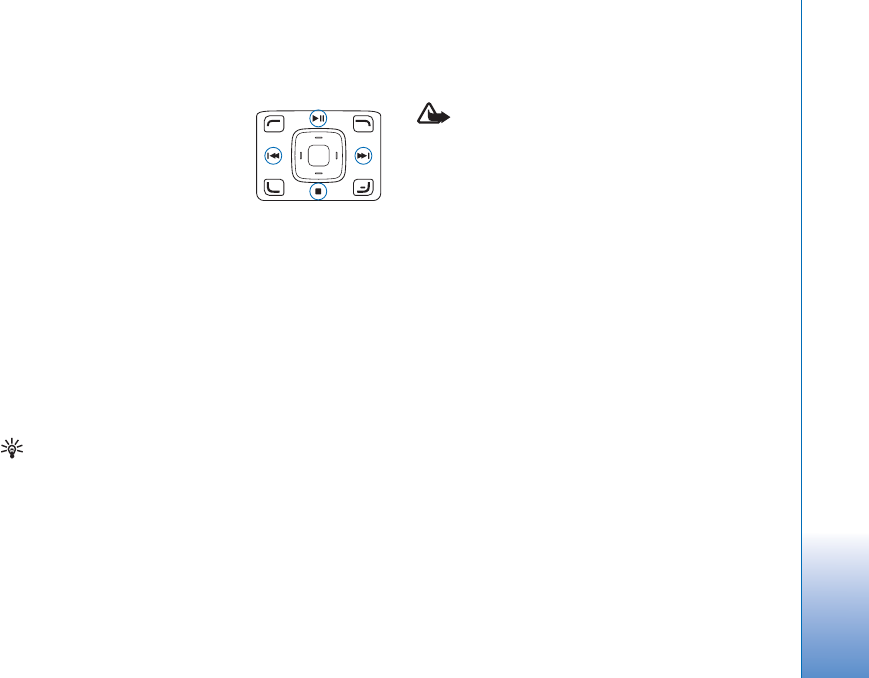
Mobile TV
19
Copyright © 2006 Nokia. All rights reserved.
To view a channel, scroll up or down and press the scroll
key.
You can also use the media keys to
browse the channels or stop
receiving the broadcast. You can
press the number keys to select a
channel. Press # to enter two-digit
channel numbers.
To change the viewing angle, select Options > View angle
and one of the options, if available.
To change the language for the current program, select
Options > Audio language and one of the options, if
available.
To change the order of the channels, select Options >
Settings. See ‘Settings’, p. 22.
To switch to full screen, select Options > Full screen. To
return to normal screen, select Options > Normal screen.
Tip: You can also press the * key to switch between full
screen and normal view.
To view the Web page of your service provider, select
Options > Provider page. The menu command may vary.
Access to the provider Web page may require a 2GSM or
3GSM network connection.
To adjust volume, use the side volume key or the scroll key.
To mute and unmute the sound, select Options > Mute or
Unmute.
Do not hold the device near to your ear when the
loudspeaker is in use, because the volume may be
extremely loud.
To replay the last 30 seconds, select Options > Replay, if
available.
Services
The channel that you are currently viewing may offer
additional interactive services, such as Web links or
possibilities to purchase or vote for something or install
and use Java™ applications.
To view services, select Options >Services, and the service
you want. Services vary, and many TV programs may not
include services.
Additional charges may apply for using the 2GSM or
3GSM network required to access the services.
Program guide
In a program guide, the available channels and programs
are listed according to their starting time.
To view the program guide, select Options > Programme
guide. To change the channel, scroll right or left, or use

Mobile TV
20 Copyright © 2006 Nokia. All rights reserved.
the media keys. To view upcoming programs, scroll up or
down.
To watch the currently running program, select Options >
Watch programme.
To set a reminder for an upcoming program, in a program
guide, select Options > Remind. indicates a program
with a reminder. To define the time before the start of the
program that the reminder goes off, see “Settings”, p. 22.
Timed or active recordings and active reminders may not
work if you change the program guide.
To remove a reminder in a program guide, select
Options > Remove reminder.
The reminder does not sound if the device is turned off.
To view details on a program, select a program from the
program guide, and select Options >Programme details.
The program guide schedule is based on the time zone you
selected in the device settings. If the time zone is not
correct, the scheduling in the program guide is also
wrong.
Record programs
To start recording a program that you are viewing, press
the capture key. The recording stops when the program
ends. To stop the recording before that, press the capture
key again.
To start recording the current or next program, select
Options >Record programme and one of the options in
the submenu.
If the program has an age limit that is higher than that
which you defined in the settings, you must enter the lock
code before you can start the recording.
To stop recording, select Options >Stop recording.
To pause recording, select Options >Pause recording. The
broadcast continues uninterrupted. To continue recording,
select Options >Resume recording.
If you record a program in the background while using the
device for something else and press the stop key, the
recording stops.
To start recording a program shown in the program guide,
select the program from the list, and select
Options >Record programme. To adjust the recording
time, see “Settings”, p. 22.
You may not be able to record some programs if you have
not subscribed to the program or the TV program content
provider does not allow the recording.
Using other applications during the recording may cause
interference to the recorded TV program.
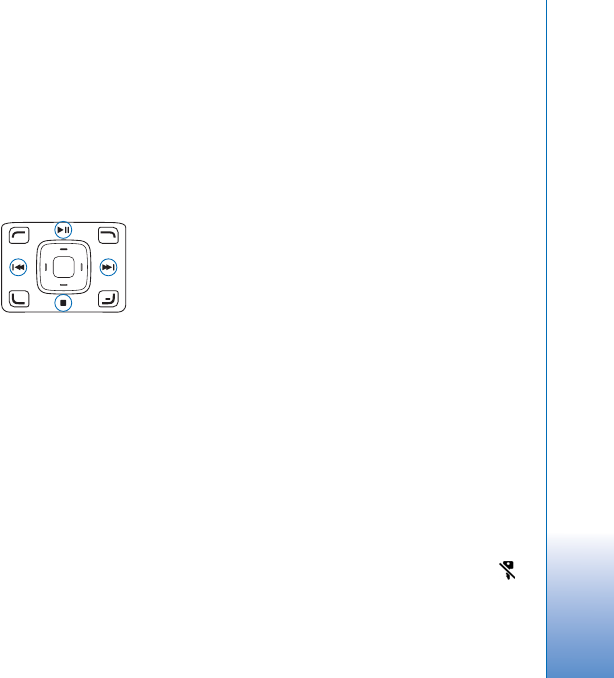
Mobile TV
21
Copyright © 2006 Nokia. All rights reserved.
Recording may fail if the (digital TV) DVB-H network is not
available or reception signal is too low.
Watch recorded programs
To go to the My videos folder, select Options > My videos.
To open folders and view recordings, use the scroll key.
To pause, resume, fast forward, or
rewind, use the media keys.
To play the clip in full screen, select
Options > Play in full screen, if
available.
To pause the playback select Options > Pause. To continue
playback, select Options > Resume or Resume in full
screen. You can also use the corresponding media key.
To turn the audio on or off, select Options > Mute or
Unmute
To rename a file, select Options > Rename.
To view file details such as File name, Duration or Size,
select Options > File details.
To ensure that the device does not run out of memory, the
files are automatically deleted starting from the older
ones. To protect a file against automatic deletion, select
Options > Protect file. To remove the protection, select
Options > Remove protection.
To move or copy videos to other folders in your device or
compatible memory card, select Options > Copy to folder
or Move to folder. To create a new folder, select Options
> New folder.
Search
To search any string of characters in the currently selected
program guide:
1Select Options > Search.
2Enter the search term. You can limit the search to a
specific channel, or specify a weekday or a genre for
the search.
3Select Search to start the search.
4Select a found program and Options to watch or listen
to the program, subscribe to it, view the details, set a
reminder or recording.
Subscribe to channel packages,
channels, and programs
A channel package is a set of channels that you can
subscribe to as one package.
Some TV channels and programs may require a
subscription. Unsubscribed items are indicated with .
To subscribe to an item, do the following:

Mobile TV
22 Copyright © 2006 Nokia. All rights reserved.
1Select Options >Subscriptions> New subscription.
2If you selected Options after selecting an already
subscribed program, select the category you want to
subscribe to: Channel pckgs., Channels, or
Programmes.
If you selected Options after selecting an
unsubscribed program, select from a list of
unsubscribed items.
3Select Options > Subscribe.
4Select the length of the subscription.
5To accept the subscription, select Verify in the Verify
subscription dialog.
A note is displayed when you can start watching the
channel or program.
You cannot subscribe offline or without a SIM card.
Continue and end subscriptions
1Select Options >Subscriptions > My subscriptions.
2Select the category: Channel pckgs., Channels, or
Programmes.
3To view the details of an item, select Options > Item
details.
To continue your current subscription, select
Options >Continue subscription.
To end your continuous subscription, select Options >
Unsubscribe.
Settings
To configure the Mobile TV settings, select Options >
Settings. Define the following:
System status—to view the general status of the Mobile
TV and the signal strength. To update the signal strength
indicator, close this dialog and open it again.
Channel order—to change the default channel order.
Select Options > Mark to mark the items you want to
move, select Options > Move, scroll to the new location,
and select OK.
Parental control —to set an age limit to programs. The
required password is the same as the device lock code.
After this, you must enter your lock code to view any TV
program with a higher age limit. For more information on
lock code, see “Security”, p. 112.
Memory in use—to define the default location for
recordings and saved replay clips
Recording time reserve—to define the extra recording
time reserved for program delays. With this setting you can
stop the recording later than what the given program
guide indicates.
Reminder alarm—to define how early you want to be
reminded of a program

Mobile TV
23
Copyright © 2006 Nokia. All rights reserved.
Programme guide—to view the available program guides
and change the current program guide
Indicators
- Channel package
- Channel
- Program
- Unsubscribed item
- Messaging service
- Phone service
- Web service
- Java service
- Recording
- Recording not allowed
- Age limit
- New clip in My videos
- Protected file

Camera
24 Copyright © 2006 Nokia. All rights reserved.
Camera
Your Nokia N92 has two cameras. The high resolution
main camera activates when you rotate the display to the
Imaging mode. The lower resolution secondary camera on
the front activates in the Fold open mode. Both cameras
can be used to take still pictures and record video.
The Nokia N92 device supports an image capture
resolution of 1600x1200 pixels. The image resolution in
these materials may appear different.
To activate the main camera,
switch to the Imaging mode.
See ‘Imaging mode’, p.10. In
the viewfinder, you can see
the view to be captured. To
switch between cameras,
select Options > Use
second. camera or Use
main camera.
You can send images and
video clips in a multimedia
message, as an e-mail attachment, with infrared or
wireless LAN, or by using Bluetooth connectivity.
Take pictures
To activate the main camera, rotate the display to the
Imaging mode. If the camera is in video mode, scroll left to
select image mode.
To take a picture, press the capture key or the scroll key. A
red indicator led flashes.
To make lighting and color adjustments before taking a
picture, see ‘Adjust color and lighting’, p. 26.
Saving the captured image may take longer if you change
the zoom, lighting, or color settings.
The camera indicators show the following:
• The device memory ( ) and memory card ( )
indicators (1) show where images are saved.
• The images indicator (2) estimates how many images,
depending on the selected image quality, fit in the
remaining memory of your device or the compatible
memory card (if inserted).
•
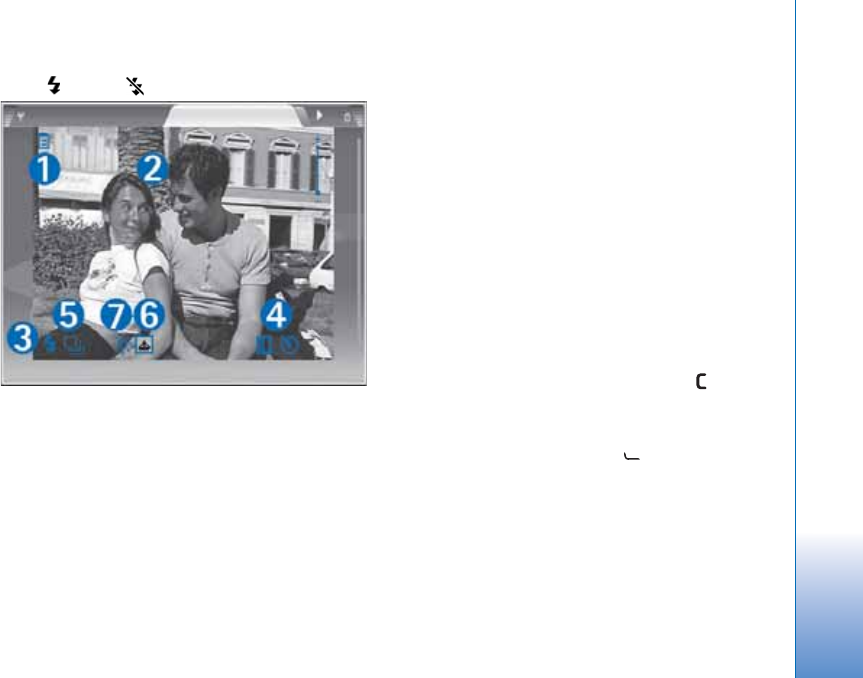
Camera
25
Copyright © 2006 Nokia. All rights reserved.
• The flash indicator (3) shows whether the flash is set to
On () or Off ().
• The self-timer indicator (4) shows that the self-timer is
activated. See ‘You in the picture—self-timer’, p. 26.
• The sequence mode indicator (5) shows that the
sequence mode is active. See ‘Exposure modes’, p. 26.
• The color tone indicator (6) shows the selected color
tone. See ‘Adjust color and lighting’, p. 26.
• The white balance indicator (7) shows the selected
white balance setting. See ‘Adjust color and lighting’,
p. 26.
• Scroll up and down or use the side volume key to zoom
in and zoom out. The zoom indicator, which appears on
the side pane, shows the zoom level.
When taking a picture, note the following:
• Use both hands to keep the camera still.
• The quality of a zoomed picture is lower than that of a
nonzoomed picture.
• The camera goes into the battery saving mode if there
are no keypresses for a moment. To continue taking
pictures, press the scroll key.
To select the secondary camera, for example, to include
yourself in the picture, rotate the display to the Fold open
or View mode, and select Options > Use second. camera.
After the image is taken, switch to Fold open mode.
If you do not want to keep the image, press , or select
Options > Delete.
To send the image Via multimedia, Via e-mail, Via
Bluetooth, or Via infrared, press , or select Options >
Send. For more information, see ‘Messaging’, p. 42 and
‘Bluetooth connectivity’, p. 81.
To send an image to the other party during an active call,
select Options > Send MMS.
To set the current image as background image, select
Options > Set as wallpaper

Camera
26 Copyright © 2006 Nokia. All rights reserved.
To add the current image to a contact card, select
Options > Add to contact
To rename the current image, select Options > Rename
image
Exposure modes
To set the camera to take six pictures in a sequence, select
Options > Sequence mode . You can also use the
sequence mode with the Self-timer. See ‘You in the
picture—self-timer’, p. 26. The pictures are automatically
saved in Gallery.
After you take the pictures, they are shown in a grid on
the main display. To view a picture, press the scroll key to
open it.
To set the camera to take pictures in low light conditions,
select Options > Night mode.
You in the picture—self-timer
The self-timer is available only in the main camera.
Use the self-timer to delay the capture so that you can
include yourself in the picture. To set the self-timer delay,
select Options > Self timer > 10 seconds, 20 seconds, or
30 seconds. To activate the self-timer, select Activate.
The self-timer indicator ( ) blinks and the device beeps
when the timer is running. The camera takes the picture
after the selected delay elapses.
You can also use the self-timer in the sequence mode.
Flash
The flash is available only in the main camera.
Keep a safe distance when using the flash. Do not use the
flash on people or animals at close range. Do not cover the
flash while taking a picture.
The camera has an LED flash for low light conditions. The
following flash modes are available: Automatic, On (),
and Off ().
To use the flash, select Options > Flash > On.
Adjust color and lighting
To enable the camera to reproduce colors and lighting
more accurately, select Options and from the following
options:
Flash (images only)—Set the flash according to the lighting
conditions. See ‘Flash’, p. 26.
Adjust > White balance—Select the current lighting
condition from the list. This allows the camera to
reproduce colors more accurately.
Adjust >Colour tone—Select a color effect from the list.

Camera
27
Copyright © 2006 Nokia. All rights reserved.
The screen display changes to match any settings you
make, so that you see how the change affects the pictures
or videos.
The available settings vary depending on the selected
camera.
The setup settings are camera specific; if you change the
settings in the secondary camera, the settings in the main
camera do not change. The setup settings do, however,
transfer between the image and video modes.
Adjust still image camera settings
To change the main settings, select Options > Settings>
Image, and select from the following options:
Image quality—High, Normal, or Basic. The better the
image quality, the more memory the image consumes.
Image resolution—High(resolution 1600x1200),
Normal(resolution 1152x864), or Basic (resolution
640x480). The higher the image resolution, the more
memory the image consumes. The quality of a zoomed
picture is lower than that of a nonzoomed picture.
Default image name—Set a name for the pictures you
take. For example, if you set Beach as the default name,
the camera names the pictures you take Beach,
Beach(001), Beach(002), and so on, until you change the
setting again.
Show captured img.—Select Yes if you want to see the
captured image after it is taken, or No if you want to
continue taking pictures immediately.
Memory in use—Select where to store your images.
Tips on taking good photographs
Picture quality
Use the appropriate picture quality. The camera has
three picture quality modes (High, Normal, and Basic).
Use the High setting to ensure that the camera produces
the best picture quality available. Note however, that
better picture quality requires more storage space. For
MMS and e-mail attachments it may be necessary to use
the Normal or Basic setting. To define the quality in the
imaging mode in the camera, select Options > Settings.
Background
Use a simple background. For portraits and other pictures
with people, avoid having your subject in front of a
cluttered, complex background that may distract
attention from the subject. Move the camera, or the
subject, when these conditions cannot be met. Move the
camera closer to the object to take clearer portraits.

Camera
28 Copyright © 2006 Nokia. All rights reserved.
Depth
When shooting landscapes and sceneries, to add depth to
your pictures, place objects into the foreground. If the
foreground object is too close to the camera, it may be
blurred.
Lighting conditions
Changing the source, amount, and direction of light can
change photographs dramatically. The following are some
typical lighting conditions:
•Light source behind the subject. Avoid placing your
subject in front of a strong light source. If the light
source is behind the subject or visible in the display,
the resulting picture may have weak contrast, may be
too dark, and may contain unwanted light effects. You
can also use the flashlight to add more lighting to
shadows. See ‘Flash’, p. 26.
•Sidelit subject. Strong side light gives a dramatic
effect but may be too harsh, resulting in too much
contrast.
•Light source in front of the subject. Harsh sunlight
may cause the subjects to squint their eyes. The
contrast may also be too high.
•Optimal lighting is found in situations where there is
plenty of diffused, soft light available, for example, on
a bright, partially cloudy day or on a sunny day in the
shadow of trees.
Record videos
To activate the main camera, rotate the display to the
Imaging mode. If the camera is in image mode, scroll right
to select video mode.
To select the secondary camera, for example, to include
yourself in the video, select Options > Use second.
camera, or rotate the display to the Fold open mode.
To adjust color before recording a video, select Options >
Adjust > White balance or Colour tone. See ‘Adjust color
and lighting’, p. 26.
1In the main camera, press the capture key, or in the
secondary camera, press to start recording. The red
record icon is shown. The red LED lightis lit, and a
tone sounds, indicating to the subject that video is
being recorded.
2To pause recording at any time, select Pause. The pause
icon ( ) blinks on the display. Video recording
automatically stops if recording is set to pause and
there are no keypresses within a minute.
3Select Continue to resume recording.
4Select Stop to stop recording. The video clip is
automatically saved to the Images & videofolder of
Gallery. See ‘Gallery’, p. 30.

Camera
29
Copyright © 2006 Nokia. All rights reserved.
Viewfinder indicators show the following:
• The device memory ( ) and memory card ( )
indicators (1) show where the video is saved.
• The microphone indicator shows that the
microphone is muted.
• The zoom indicator, which appears on the side pane,
shows the zoom level. Scroll up or down or use the side
volume key to zoom in or zoom out.
After a video clip is recorded:
• To immediately play the video clip you just recorded,
select Options > Play.
• If you do not want to keep the video, press , or
select Options > Delete.
• To send a video clip to the other party during an active
call, select Options > Send MMS.
Video settings
There are two kinds of settings for the video recorder:
temporary settings and default settings. To adjust contrast,
brightness, and color settings, see ‘Adjust color and
lighting’, p. 26. The temporary settings return to the
default settings after you close the camera, but the default
settings remain the same until you change them again. To
change the default settings, select Options > Settings >
Video and from the following:
Length: %U—To optimize video clips for MMS, select
Short.
Video resolution—Select High (CIF, 352x288), Normal
(QCIF 176x144), or Basic (SubQCIF 128x96). The higher
the resolution, the more memory the video consumes.
Default video name:—Set a name for the video taken.
Select Date or Text. If you select Text, the videos are
named in the format “Video” by default. For example, if
you set Beach as the default name, Camera names the
video clips you take Beach, Beach(001), Beach(002), and
so on, until you change the setting again.
Memory in use—Define the default memory store: device
memory or memory card (if inserted).

Gallery
30 Copyright © 2006 Nokia. All rights reserved.
Gallery
To store and organize your images, video clips, sound clips,
playlists, and streaming links, or share your files with
other compatible Universal Plug and Play (UPnP) devices
through wireless LAN, press , and select Gallery. To
open the gallery from the Camera application, select
Options > Go to Gallery. From Camera, only the Images
& video folder is available.
Select Images & video , Tracks , Sound clips ,
Streaming links , Presentations , or All files ,
, and press to open it.
You can browse and open folders, and mark, copy, and
move items to folders. Video clips, .ram files, and
streaming links are opened and played in the RealPlayer
application. See ‘RealPlayer’, p. 36. You can also create
albums and mark, copy, and add items to albums. See
‘Albums’, p. 33.
To open a file, press . Videos open in RealPlyr., and
music and sound clips in Music player. See ‘View images
and video clips’, p. 30.
To copy or move files to the compatible memory card (if
inserted) or to device memory, select a file and Options >
Move and copy> Copy to memory card/Move to
memory card or Copy to phone mem./Move to phone
mem..
To download files into Gallery in one of the main folders
using the browser, select Track downl., or Sound downl..
The browser opens, and you can select a bookmark from
which the site can download.
View images and video clips
Pictures taken and video clips recorded with the camera
are stored in the Images & video folder in Gallery. Images
and video clips can also be sent to you in a multimedia
message, as an e-mail attachment, through Bluetooth
connectivity, or by using infrared. To be able to view a
received image or video clip in the gallery or in the media
player, you must save it in the device memory or on a
compatible memory card (if inserted).
Open the Images & video folder in Gallery. The images and
video clip files are in a loop, and ordered by date. The
number of files is displayed. To browse the files one by one,
scroll left or right. To browse files in groups, scroll up or
down.

Gallery
31
Copyright © 2006 Nokia. All rights reserved.
To edit a photo, select Options > Edit. An image editor
opens. See ‘Edit images’, p. 31.
To add an image or a video clip to an album in the gallery,
select Options > Albums > Add to album. See ‘Albums’,
p. 33.
To print your images on a compatible printer, or to store
them on your compatible memory card (if inserted) for
printing, select Options > Print. See ‘Image print’, p. 32.
To zoom an image, select Options > Zoom in or Zoom out.
The zooming ratio is at the top of the display. The zooming
ratio is not stored permanently.
To use the picture as a background image, select the
picture and Options > Assign > Set as wallpaper.
To delete an image or video clip, press .
Edit images
To edit the pictures after taking them, or the ones already
saved in Gallery, select Options > Edit.
Select Apply effect to crop and rotate the image; adjust
the brightness, color, contrast, and resolution; and add
effects, text, clip art, or a frame to the picture.
To crop an image, select Options > Apply effect > Crop.
To crop the image size manually, select Manual, or select
a predefined aspect ratio from the list. If you select
Manual, a cross appears in the upper left corner of the
image. Move the scroll key to select the area to crop, and
select Set. Another cross appears in the lower right corner.
Again select the area to be cropped. To adjust the first
selected area, select Back. The selected areas form a
rectangle, which forms the cropped image.
If you selected a predefined aspect ratio, select the upper
left corner of the area to be cropped. To resize the
highlighted area, use the scroll key. To freeze the selected
area, press . To move the area within the picture, use
the scroll key. To select the area to be cropped, press .
To reduce redness of the eyes in an image, select
Options > Apply effect > Red eye reduction. Move the
cross onto the eye, and press . A loop appears on the
display. To resize the loop to fit the size of the eye, move
the scroll key. To reduce the redness, press .
Shortcuts in the image editor:
• To view an image in the full screen, press . To
return to the normal view, press again.
• To rotate an image clockwise or counterclockwise,
press or .
• To zoom in or out, press or .
• To move on a zoomed image, scroll up, down, left, or
right.

Gallery
32 Copyright © 2006 Nokia. All rights reserved.
Image print
Use Image print to print your images using the data cable
supplied with your device, wireless LAN (if available),
Bluetooth connectivity, or a compatible memory card (if
available).
To print images with Image print, select the image you
want to print, and the print option in the gallery.
To print to a printer compatible with PictBridge, connect
the data cable before you select the print option.
You can only print images that are in .jpeg format. The
pictures taken with the camera are automatically saved in
.jpeg format.
Printer selection
When you use Image print for the first time, a list of
available printers is displayed after you select the image.
Select a printer. The printer is set as the default printer.
If you have connected a printer compatible with
PictBridge using the CA-53 cable supplied with your
device, the printer is automatically displayed.
If the default printer is not available, a list of available
printing devices is displayed.
To change the default printer, select Options >
Settings > Default printer.
Print preview
The print preview view opens only when you start printing
an image in the gallery.
The selected images are displayed using predefined
layouts. To change the layout, scroll left and right through
the available layouts for the selected printer. If the images
do not fit on a single page, scroll up or down to display the
additional pages.
Print settings
The available options vary, depending on the capabilities of
the printing device you selected.
To set a default printer, select Options > Default printer.
To select the paper size, select Paper size, the size of paper
from the list, and OK. Select Cancel to return to the
previous view.
Presentations
With presentations, you can view SVG (scalable vector
graphics) files, such as cartoons and maps. SVG images
maintain their appearance when printed or viewed with
different screen sizes and resolutions. To view SVG files,
select the Presentations folder, scroll to an image, and
select Options > Play.

Gallery
33
Copyright © 2006 Nokia. All rights reserved.
To zoom in, press . To zoom out, press .
To switch between full screen and normal screen, press *.
Albums
With albums you can conveniently manage your images
and video clips. To view the albums list, in the Images &
video folder, select Options > Albums > View albums.
To add a picture or a video clip to an album in the gallery,
scroll to a picture or video clip, and select Options >
Albums > Add to album. A list of albums opens. Select the
album to which you want to add the picture or video clip,
and press .
To remove a file from an album, press . The file is not
deleted from the Images & video folder in Gallery.

Media applications
34 Copyright © 2006 Nokia. All rights reserved.
Media applications
Music player
Press , and select Media > Music player. With the
music player, you can play music files and create and
listen to playlists.
Warning: Listen to music at a moderate level.
Continuous exposure to high volume may damage your
hearing. Do not hold the device near your ear when the
loudspeaker is in use, because the volume may be
extremely loud.
Add music
When you open the music player for the first time, the
player searches the device memory for music files to
create a music library.
After you add or remove music files in the device, update
your music library. Select Options > Music library >
Options > Update Music library.
Tip! You can transfer music files from your device to
a compatible memory card (if inserted) with Nokia
Audio Manager available in Nokia PC Suite.
Play music
When you open the music
player, the previously played
track or playlist is displayed.
To view the music library,
select or Options >
Music library and the desired
song list. To start playing the
songs in the view, select
Options > Play.
When a song is playing, to
change between play and
pause, press or .
To stop a song, press . To fast forward or rewind, press
and hold or . To start playing the next or previous
song, press or .
Tip! To control playback, you
can also use the media keys on all
sides of the scroll key.
To view the currently played song
list, select or Options > Open
'Now playing'. To save the song list

Media applications
35
Copyright © 2006 Nokia. All rights reserved.
as a playlist, select Options > Add to track list, and create
a new playlist, or select a saved playlist.
To adjust the volume, use the volume key on the side of the
device.
To select between random play and normal play mode,
select Options > Random play. To select whether playing
stops at the end of the playlist or restarts from its
beginning, select Options > Loop.
Tip! To leave the application open and music playing
in the background, press twice to return to the
standby mode. To return to the application, press ,
and select Music player.
To open your Web bookmarks for downloading music,
select Options > Track downloads.
To return to the standby mode and leave the music playing
in the background, select Options > Play in background.
Music library
To view the music library, select Options > Music library.
All tracks lists all music. To view sorted songs, select
Albums, Artists, Genres, or Composers. The album, artist,
genre, and composer information is collected from the ID3
or M4A tags of the song files, if available. Some tag format
variations may not be supported.
To add songs, albums, artists, genres, or composers to a
playlist, select the items and Options > Add to track list.
You can create a new playlist or add to an existing one.
To view playlists, select Track lists. To create a new
playlist, select Options > New track list. When viewing a
playlist you have created, to add more songs, select
Options > Add tracks.
To delete a playlist, press . Deleting a playlist only
deletes the playlist, not the music files.
Equalizer
To modify the tone of the music playback, select Options
> Equaliser.
To use one of the preset equalizer settings, select it with
the scroll key, and select Activate.
Modify equalizer presets
1To create a new preset, select Options> New preset.
To modify an existing preset select Options > Edit.
2To adjust the frequency settings, scroll to the left or
right to select low, mid, or, high frequency and up or
down to increase or decrease the volume of the
selected frequency band.
3To reset the settings to their original values, select
Options > Reset to defaults.
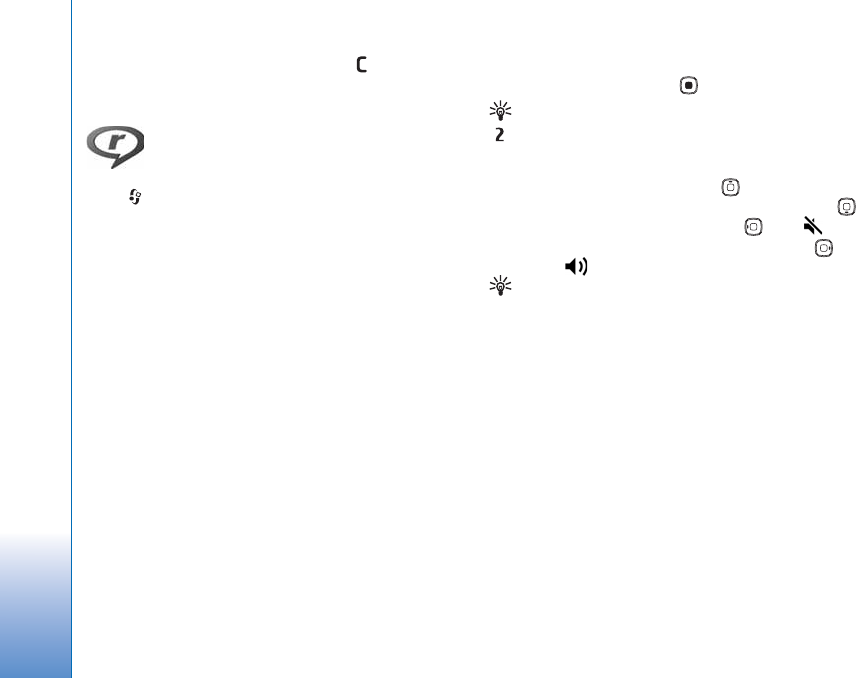
Media applications
36 Copyright © 2006 Nokia. All rights reserved.
To delete a preset, scroll to it, and press . The default
presets cannot be deleted.
RealPlayer
Press , and select Media > RealPlyr.. With RealPlyr.,
you can play video clips, or stream media files over the air.
You can activate a streaming link when you browse Web
pages, or store it in the device memory or a compatible
memory card (if inserted).
RealPlyr. supports files with extensions such as .3gp,
.mp4, or .rm. However, RealPlyr. does not necessarily
support all file formats or all the variations of file formats.
For example, RealPlyr. attempts to open all .mp4 files, but
some .mp4 files may include content that is not compliant
with 3GPP standards and, therefore, is not supported by
this device.
Play video or sound clips
1To play a media file stored in device memory or on the
compatible memory card (if inserted), select Options >
Open and from the following:
Most recent clips—to play one of the last six files
played in RealPlyr.
Saved clip—to play a file saved in Gallery.
See ‘Gallery’, p. 30.
2Scroll to a file, and press to play the file.
Tip! To view a video clip in full screen mode, press
. To change back to normal screen mode, press any key.
Shortcuts during play:
• To fast forward, press and hold .
• To rewind through the media file, press and hold .
• To mute the sound, press and hold until is
displayed. To turn on the sound, press and hold until
you see .
Tip! To control playback, you can also use the media
keys around the scroll key.
Stream content over the air
Many service providers require you to use an Internet
access point (IAP) for your default access point. Other
service providers allow you to use a WAP access point.
The access points may be configured when you first start
your device.
Contact your service provider for more information.
In RealPlyr., you can only open an rtsp:// URL address.
However, RealPlyr. recognizes an http link to a .ram file.
To stream content over the air, select a streaming link
saved in Gallery, on a Web page, or received in a text
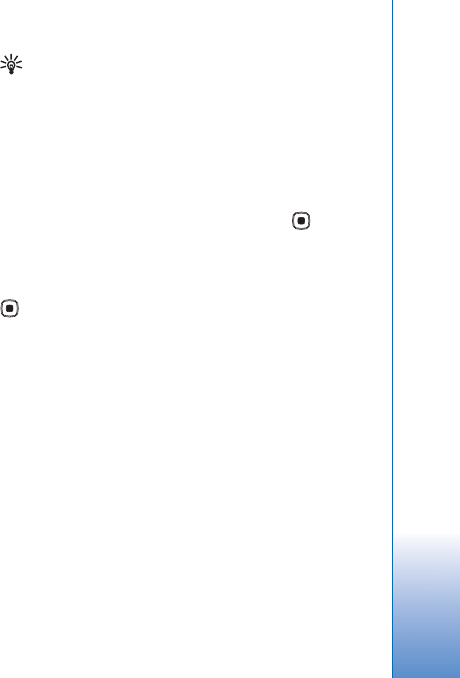
Media applications
37
Copyright © 2006 Nokia. All rights reserved.
message or multimedia message. Before live content
begins streaming, your device connects to the site and
starts loading the content. The content is not saved in your
device.
Receive RealPlayer settings
You may receive RealPlyr. settings in a special text
message from the network operator or service provider.
See ‘Data and settings’, p. 47. For more information,
contact your network operator or service provider.
Change the RealPlayer settings
Select Options > Settings and from the following:
Video—to have RealPlyr. automatically repeat video clips
after they finish playing
Connection—to select whether to use a proxy server,
change the default access point, and set the port range
used when connecting. Contact your service provider for
the correct settings.
Proxy sett.:
Use proxy—To use a proxy server, select Yes.
Proxy serv. address—Enter the IP address of the proxy
server.
Proxy port number—Enter the port number of the proxy
server.
Glossary: Proxy servers are intermediate servers
between media servers and their users. Some service
providers use them to provide additional security or
speed up access to browser pages that contain sound
or video clips.
Netw. sett.:
Default access point—Scroll to the access point you want
to use to connect to the Internet, and press .
Online time—Set the time for RealPlyr. to disconnect
from the network when you pause a media clip playing
through a network link. Select User defined, and press
. Enter the time, and select OK.
Lowest UDP port—Enter the lowest port number of the
server’s port range. The minimum value is 1024.
Highest UDP port—Enter the highest port number of the
server’s port range. The maximum value is 65535.
Select Options > Advanced settings to edit the
bandwidth values for different networks.
Flash Player
With Flash Player, you can view, play, and interact with
flash files made for mobile devices.

Media applications
38 Copyright © 2006 Nokia. All rights reserved.
Organise flash files
Press , and select Media > Flash Player. Scroll right.
To open a folder or play a flash file, scroll to it, and press
the scroll key.
To send a flash file to a compatible device, scroll to it, and
press the call key.
To copy a flash file to another folder, select Options >
Organise > Copy to folder.
To move a flash file to another folder, select Options >
Organise > Move to folder.
To create a folder to organize your flash files, select
Options >Organise > New folder.
The available options may vary.
To delete a flash file, scroll to it, and press .
Play flash files
Press , and select Media >Flash Player. Scroll to a
flash file, and press the scroll key.
If available, select Options and from the following:
Pause—to pause the playback
Stop—to stop the playback
Quality—to select the playback quality. If the playback
appears uneven and slow, select Normal or Low.
Full screen—to play the file using the entire display. To
return to the normal screen, select Normal screen.
Even though they are not visible in full screen, the key
functions may still be available when you press either key
below the display.
Fit to screen—to play the file in its original size after
zooming it
Pan mode on—to be able to move around the display with
the scroll key when you have zoomed in
Visual Radio
Press , and select Media > Radio. You can use the
application as a traditional FM radio with automatic
tuning and saved stations, or with parallel visual
information related to the radio program on the display, if
you tune to stations that offer Visual Radio service. The
Visual Radio service uses packet data (network service).
You can listen to the FM radio while using other
applications.
If you do not have access to the Visual Radio service, the
operators and radio stations in your area may not support

Media applications
39
Copyright © 2006 Nokia. All rights reserved.
Visual Radio. The Visual Radio service may not be available
in all areas and countries.
You can normally make a call or answer an incoming call
while listening to the radio. The radio is muted when there
is an active call.
The radio selects the used frequency band based on the
country information received from the network. If this
information is not available, you may be asked to select the
region you are located in, or you can select the region in
the Visual Radio settings. See ‘Settings’, p. 40.
Listen to the radio
The quality of the radio broadcast depends on the coverage
of the radio station in that particular area.
The FM radio depends on an antenna other than the
wireless device antenna. A compatible headset or
enhancement needs to be attached to the device for the
FM radio to function properly.
Press , and select Media > Radio. To start a station
search, select or . To change the frequency
manually, select Options > Manual tuning.
If you have previously saved radio stations, select or
to go to the next or previous saved station, or press
the corresponding number key to select the memory
location of a station.
To adjust the volume, use the side volume key. To listen to
the radio using the loudspeaker, select Options >
Activate loudspeaker.
Warning: Listen to music at a moderate level.
Continuous exposure to high volume may damage your
hearing. Do not hold the device near your ear when the
loudspeaker is in use, because the volume may be
extremely loud.
To view available stations based on location, select
Options > Station directory (network service).
To save the current tuned station to your station list,
select Options > Save station. To open the list of your
saved stations, select Options > Stations.
To return to the standby mode and leave the FM radio
playing in the background, select Options > Play in
background.
Tip! You can also use the media keys around the
scroll key to control the radio.
View visual content
To check availability and costs, and to subscribe to the
service, contact your network operator or service provider.
To view available visual content for a tuned station, select
or Options > Start visual service. If the visual
service ID has not been saved for the station, enter it, or

Media applications
40 Copyright © 2006 Nokia. All rights reserved.
select Retrieve to search for it in the station directory
(network service).
When the connection to the visual service is established,
the display shows the current visual content.
To adjust display settings for the visual content view,
select Options > Display settings.
Saved stations
You can save up to 20 radio stations in the radio. To open
your station list, select Options > Stations.
To listen to a saved station, select Options > Station >
Listen. To view available visual content for a station with
Visual Radio service, select Options > Station > Start
visual service.
To change station details, select Options > Station >
Edit.
Settings
Select Options > Settings and from the following:
Start-up tone—Select whether a tone is played when the
application is started.
Auto-start service—Select Yes to have the Visual Radio
service start automatically when you select a saved
station that offers visual service.
Access point—Select the access point used for the data
connection. You do not need an access point to use the
application as an ordinary FM radio.
Current region—Select the region you are currently
located in. This setting is displayed only if there was no
network coverage when the application was started.
Web
Press , and select Media > Web to open a
supplementary Web browser (network service) optimized
for browsing Web sites that are not originally formatted
for mobile browsing.
Web preserves the original page layout.
Scroll in any direction on a page. A smaller image of the
page is displayed with a red frame that indicates the
currently shown area.
To view the thumbnail image of the current page, you can
also select Options > Zooming options > Page overview.
Move the red frame with the scroll key and press the scroll
key to return to normal view.
To view recently visited pages as thumbnails, select
Options > Navigation options.

Media applications
41
Copyright © 2006 Nokia. All rights reserved.
To block pop-up windows, select Options > Settings >
Block pop-up windows.
To search for a text in real time, select Options >
Navigation options > Find and start entering the search
string. The matching string is displayed as you enter the
text.
You can subscribe to news and blog feeds hosted by many
Web sites. The Web feeds feature of the browser alerts you
when feed links are available for a Web site.
For information on other features and options in Web, see
‘Services’, p. 65.
Recorder
To record voice memos, press , and select Media >
Recorder. To record a telephone conversation, open
Recorder during a voice call. Both parties hear a tone every
5 seconds during recording.
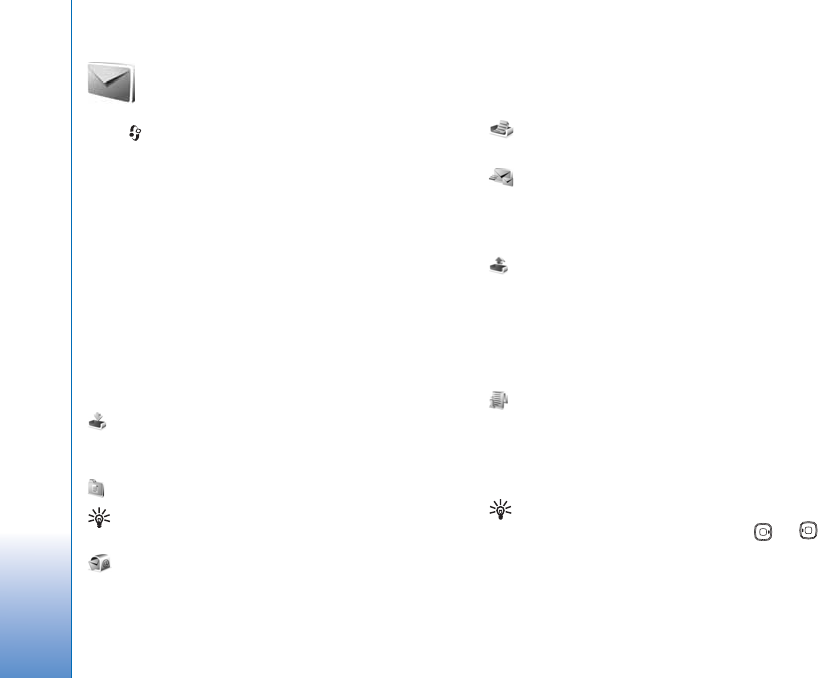
Messaging
42 Copyright © 2006 Nokia. All rights reserved.
Messaging
Press , and select Messag. (network service). In
Messag., you can create, send, receive, view, edit, and
organize text messages, multimedia messages, e-mail
messages, and special text messages containing data. You
can also receive Web service messages, cell broadcast
messages, and send service commands. Messages and
data received using Bluetooth connectivity or infrared are
received in the Inbox folder in Messag..
To create a new message, select New message.
Only devices that have compatible features can receive
and display multimedia messages. The appearance of a
message may vary depending on the receiving device.
Messag. contains the following folders:
Inbox—Received messages, except e-mail and cell
broadcast messages, are stored here. E-mail messages are
stored in the Mailbox.
My folders—Organize your messages into folders.
Tip! To avoid rewriting messages that you send often,
use texts in the templates folder.
Mailbox—Connect to your remote mailbox to
retrieve your new e-mail messages or view your previously
retrieved e-mail messages offline. See ‘E-mail’, p. 52.
Drafts—Draft messages that have not been sent are
stored here.
Sent—The last 20 messages that have been sent,
excluding messages sent using Bluetooth connectivity or
infrared, are stored here. To change the number of
messages to be saved, see ‘Other settings’, p. 54.
Outbox—Messages waiting to be sent are temporarily
stored here.
For example, messages are placed in the outbox when your
device is outside network coverage. You can also schedule
e-mail messages to be sent the next time you connect to
your remote mailbox.
Reports—You can request the network to send you a
delivery report of the text messages and multimedia
messages you have sent (network service). Receiving a
delivery report of a multimedia message that has been sent
to an e-mail address may not be possible.
Tip! When you have opened any of the default folders,
to switch between the folders, press or .
To enter and send service requests (also known as USSD
commands), such as activation commands for network
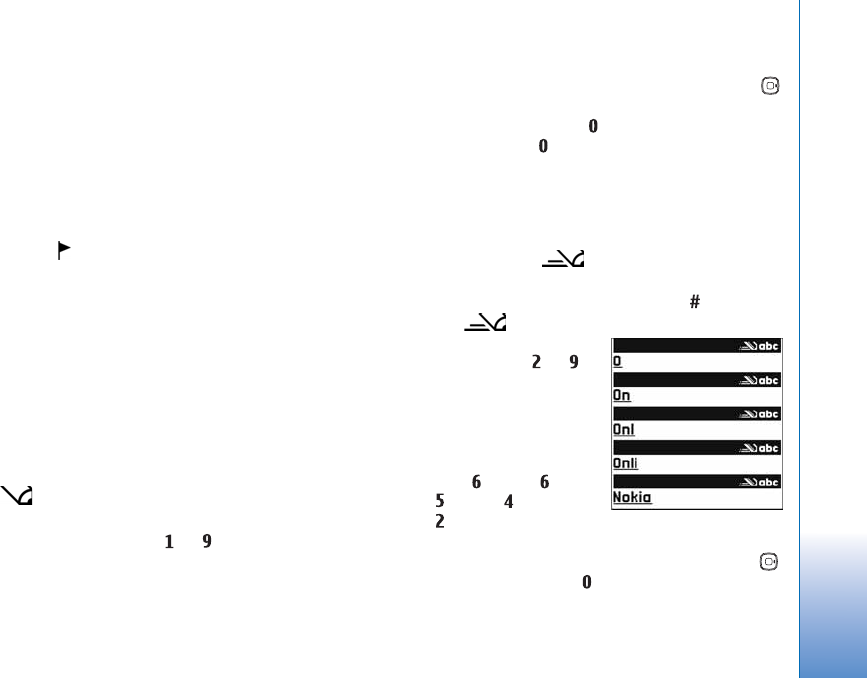
Messaging
43
Copyright © 2006 Nokia. All rights reserved.
services, to your service provider, select Options > Service
command in the main view of Messag..
Cell broadcast (network service) allows you to receive
messages on various topics, such as weather or traffic
conditions, from your service provider. For available topics
and relevant topic numbers, contact your service provider.
In the main view of Messaging, select Options > Cell
broadcast. In the main view, you can see the status of a
topic, a topic number, name, and whether it has been
flagged ( ) for follow-up.
Cell broadcast messages cannot be received in UMTS
networks. A packet data connection may prevent cell
broadcast reception.
Write text
ABC, abc, and Abc indicate the selected character mode.
123 indicates the number mode.
Traditional text input
is displayed when you are writing text using
traditional text input.
• Press a number key ( — ) repeatedly until the
desired character appears. There are more characters
available for a number key than are printed on the key.
• If the next letter is located on the same key as the
present one, wait until the cursor appears (or press
to end the time-out period), and enter the letter.
• To insert a space, press . To move the cursor to the
next line, press three times.
Predictive text input
You can enter any letter with a single keypress. Predictive
text input is based on a built-in dictionary to which you
can add new words. is displayed when you write
text using predictive text input.
1To activate predictive text input, press repeatedly
until is displayed.
2To write the desired word,
press the keys — .
Press each key only once
for one letter. For
example, to write "Nokia"
when the English
dictionary is selected,
press for N, for o,
for k, for i, and
for a.
The word suggestion changes after each keypress.
3When you finish writing the word correctly, press
to confirm it, or press to add a space.

Messaging
44 Copyright © 2006 Nokia. All rights reserved.
If the word is not correct, press repeatedly to view
the matching words the dictionary has found one by
one.
If the ? character is shown after the word, the word is
not in the dictionary. To add a word to the dictionary,
select Spell, enter the word using traditional text
input, and select OK. The word is added to the
dictionary. When the dictionary is full, a new word
replaces the oldest added word.
4Start writing the next word.
Write compound words
Write the first half of a compound word; to confirm it,
press . Write the last part of the compound word. To
complete the compound word, press to add a space.
Turn predictive text input off
To turn predictive text input off, press repeatedly
until is displayed.
Tip! To turn predictive text input on or off, quickly
press twice.
Tips on text input
To insert a number in the letter mode, press and hold the
desired number key.
To switch between the letter and number mode, press and
hold .
To switch between the different character modes, press
.
To delete a character, press . To delete more than one
character, press and hold .
The most common punctuation marks are available under
.
To open a list of special characters, press .
Tip! To insert several special characters at the same
time, press when you select each character.
Write and send messages
The appearance of a multimedia message may vary,
depending on the receiving device.
Copyright protections may prevent some images, music
(including ringing tones), and other content from being
copied, modified, transferred or forwarded.
Before you can create a multimedia message or write an
e-mail, you must have the correct connection settings in
place. See ‘Receive MMS and e-mail settings’, p. 46 and
‘E-mail’, p. 52.
The wireless network may limit the size of MMS messages.
If the inserted picture exceeds this limit, the device may
make it smaller so that it can be sent by MMS.
1Select New message and from the following:

Messaging
45
Copyright © 2006 Nokia. All rights reserved.
Text msg.—to send a text message
Multimedia message—to send a multimedia message
(MMS)
E-mail—to send an e-mail. If you have not set up your
e-mail account, you are prompted to do so. To start
creating the e-mail settings with the mailbox guide,
select Start.
2In the To field, press
to select recipients or
groups from contacts, or
enter the recipient’s
phone number or e-mail
address. To add a
semicolon (;) that
separates the recipients,
press . You can also
copy and paste the
number or address from
the clipboard.
3In the Subject field, enter
the subject of a
multimedia message or e-mail. To change the fields
that are visible, select Options > Address fields.
4In the message field, write the message. To insert a
template, select Options > Insert or Insert object >
Template.
5To add a media object to a multimedia message, select
Options > Insert object > Image, Sound clip, or Video
clip. When sound is added, is shown.
You may not be able to send video clips that are saved
in the .mp4 format in a multimedia message. To
change the format in which recorded videos are saved,
see ‘Video settings’, p. 29.
6To take a new picture or record sound or video for a
multimedia message, select Insert new > Image,
Sound clip, or Video clip. To insert a new slide to the
message, select Slide.
To see what the multimedia message looks like, select
Options > Preview.
7To add an attachment to an e-mail, select Options >
Insert > Image, Sound clip, Video clip, or Note.
E-mail attachments are indicated by .
Tip! To send other file types as attachments, open
the appropriate application, and select Send > Via
e-mail, if available.
8To send the message, select Options > Send, or press
.
Your device supports the sending of text messages beyond
the character limit for a single message. Longer messages
are sent as a series of two or more messages. Your service
provider may charge accordingly. Characters that use
accents or other marks, and characters from some
language options like Chinese, take up more space limiting

Messaging
46 Copyright © 2006 Nokia. All rights reserved.
the number of characters that can be sent in a single
message. In the navigation bar, you can see the message
length indicator counting backwards. For example, 10 (2)
means that you can still add 10 characters for the text to
be sent as two messages.
E-mail messages are automatically placed in Outbox
before sending. If sending does not succeed, the e-mail is
left in the Outbox first with the Queued status, and then,
if the sending has failed several times, with the Failed
status.
Tip! You can combine images, video, sound, and text
to a presentation and send it in a multimedia message.
Start to create a multimedia message, and select
Options > Create presentation. The option is shown
only if MMS creation mode is set to Guided or Free.
See ‘Multimedia messages’, p. 51.
Receive MMS and e-mail settings
You may receive the settings in a message from your
network operator or service provider. See ‘Data and
settings’, p. 47.
Enter the MMS settings manually
1Press , select Tools > Settings > Connection >
Access points, and define the settings for a
multimedia messaging access point. See ‘Connection’,
p. 108.
2Press , and select Messaging > Options >
Settings > Multim. msg. > Access point in use and
the access point you created as the preferred
connection. See also ‘Multimedia messages’, p. 51.
Before you can send, receive, retrieve, reply to, and forward
e-mail, you must do the following:
• Configure an Internet access point (IAP) correctly. See
‘Connection’, p. 108.
• Define your e-mail settings correctly. If you select
Mailbox in the Messag. main view and have not set up
your e-mail account, you are prompted to do so. To
start creating the e-mail settings with the mailbox
guide, select Start. See also ‘E-mail’, p. 52.
You must have a separate e-mail account. Follow the
instructions given by your remote mailbox and Internet
service provider (ISP).
Inbox—receive messages
In the Inbox folder, indicates an unread text message,
an unread multimedia message, data received
through infrared, and data received through Bluetooth
connectivity.
When you receive a message, and 1 new message
are shown in the standby mode. To open the message,

Messaging
47
Copyright © 2006 Nokia. All rights reserved.
select Show. To open a message in Inbox, scroll to it, and
press .
To reply to a received message, select Options > Reply.
To print a text or a multimedia message on a compatible
Basic Print Profile (BPP) equipped printer with Bluetooth
connectivity (such as HP Deskjet 450 Mobile Printer or HP
Photosmart 8150), select Options > Print.
Multimedia messages
Important: Exercise caution when opening
messages. Multimedia message objects may contain
malicious software or otherwise be harmful to your device
or PC.
You may receive a notification that a multimedia message
is waiting in the multimedia message center. To start a
packet data connection to retrieve the message to your
device, select Options > Retrieve.
When you open a multimedia message ( ), you may see
an image and a message. is shown if sound is
included, or if video is included. To play the sound or
the video, select the indicator.
To see the media objects that have been included in the
multimedia message, select Options > Objects.
If the message includes a multimedia presentation, is
displayed. To play the presentation, select the indicator.
Data and settings
Your device can receive many kinds of messages that
contain data ( ):
Configuration message—You may receive settings from
your network operator, service provider, or company
information management department in a configuration
message. To save the settings, select Options > Save all.
Business card—To save the information to Contacts,
select Options > Save business card. Certificates or
sound files attached to the business card are not saved.
Ringing tone—To save the ringing tone, select Options >
Save.
Operat. logo—To have the logo shown in the standby
mode instead of the network operator’s own
identification, select Options > Save.
Calen. entry—To save the invitation, select Options >
Save to Calendar.
Web message—To save the bookmark to the bookmarks
list in the Web browser, select Options > Add to
bookmarks. If the message contains both access point
settings and bookmarks, to save the data, select Options >
Save all.

Messaging
48 Copyright © 2006 Nokia. All rights reserved.
E-mail notif.—The note tells you how many new e-mail
messages you have in your remote mailbox. An extended
notification may list more detailed information.
Web service messages
Web service messages ( ) are notifications (for
example, news headlines) and may contain a text message
or a link. For availability and subscription, contact your
service provider.
Mailbox
If you select Mailbox and have not set up your e-mail
account, you are prompted to do so. To start creating the
e-mail settings with the mailbox guide, select Start. See
also ‘E-mail’, p. 52.
When you create a new mailbox, the name you give to the
mailbox replaces Mailbox in the Messaging main view.
You can have up to six mailboxes.
Open the mailbox
When you open the mailbox, the device asks if you want
to connect to the mailbox (Connect to mailbox?).
To connect to your mailbox and retrieve new e-mail
headings or messages, select Yes. When you view
messages online, you are continuously connected to a
remote mailbox using a data connection. See also
‘Connection’, p. 108.
To view previously retrieved e-mail messages offline, select
No. When you view e-mail messages offline, your device is
not connected to the remote mailbox.
Retrieve e-mail messages
If you are offline, select Options > Connect to start a
connection to the remote mailbox.
Important: Exercise caution when opening
messages. E-mail messages may contain malicious
software or otherwise be harmful to your device or PC.
1When you have an open connection to a remote
mailbox, select Options > Retrieve e-mail and one of
the following:
New—to retrieve all new e-mail messages
Selected—to retrieve only the e-mail messages that
have been marked
All—to retrieve all messages from the mailbox
To stop retrieving messages, select Cancel.
2After you retrieve the e-mail messages, you can
continue viewing them online, or select Options >

Messaging
49
Copyright © 2006 Nokia. All rights reserved.
Disconnect to close the connection and view the
e-mail messages offline.
E-mail status indicators:
The new e-mail (offline or online mode) has not
been retrieved to your device.
The new e-mail has been retrieved to your device.
The e-mail message has been read, and it has not
been retrieved to your device.
The e-mail message has been read.
The e-mail heading has been read and the message
content has been deleted both from the device and
from the server.
3To open an e-mail message, press . If the e-mail
message has not been retrieved and you are offline, you
are asked if you want to retrieve this message from the
mailbox.
To view e-mail attachments, open a message that has the
attachment indicator , and select Options >
Attachments. If the attachment has a dimmed indicator,
it has not been retrieved to the device; select Options >
Retrieve.
To print an e-mail message on a compatible Basic Print
Profile (BPP) equipped printer with Bluetooth connectivity
(such as HP Deskjet 450 Mobile Printer or HP Photosmart
8150), select Options > Print.
Retrieve e-mail messages automatically
To retrieve messages automatically, select Options > E-
mail settings > Automatic retrieval > Header
retrieval > Always enabled or Only in home net., and
define when and how often the messages are retrieved.
Retrieving e-mail messages automatically may increase
your call costs due to the data traffic.
Delete e-mail messages
To delete the contents of an e-mail message from the
device while still retaining it in the remote mailbox, select
Options > Delete. In Delete msg. from:, select Phone
only.
The device mirrors the e-mail headings in the remote
mailbox. Although you delete the message content, the
e-mail heading stays in your device. If you want to remove
the heading as well, you must first delete the e-mail
message from your remote mailbox, then make a
connection from your device to the remote mailbox again
to update the status.
To delete an e-mail from the device and the remote
mailbox, select Options > Delete. In Delete msg. from:,
select Phone and server.
If you are offline, the e-mail is deleted first from your
device. During the next connection to the remote mailbox,

Messaging
50 Copyright © 2006 Nokia. All rights reserved.
it is automatically deleted from the remote mailbox. If you
are using the POP3 protocol, messages marked to be
deleted are removed only after you have closed the
connection to the remote mailbox.
To cancel deleting an e-mail from the device and server,
scroll to an e-mail that has been marked to be deleted
during the next connection ( ), and select Options >
Undelete.
Disconnect from the mailbox
When you are online, to end the data connection to the
remote mailbox, select Options > Disconnect.
View messages on a SIM card
Before you can view SIM messages, you must copy them
to a folder in your device.
1In the Messag. main view, select Options > SIM
messages.
2Select Options > Mark/Unmark > Mark or Mark all
to mark messages.
3Select Options > Copy. A list of folders opens.
4To start copying, select a folder and OK. To view the
messages, open the folder.
Messaging settings
Fill in all fields marked with Must be defined or with a red
asterisk. Follow the instructions given by your service
provider. You may also obtain settings from your service
provider in a configuration message.
Some or all message centers or access points may be preset
for your device by your service provider or network
operator, and you may not be able to change, create, edit,
or remove them.
Text messages
Press , and select Messag. > Options > Settings >
Text msg. and from the following:
Message centres—View a list of all text message centers
that have been defined.
Character encoding— To use character conversion to
another encoding system when available, select Reduced
support.
Msg. centre in use—Select which message center is used
to deliver text messages.
Receive report—Select whether the network sends
delivery reports on your messages (network service).
Message validity—Select how long the message center
resends your message if the first attempt fails (network

Messaging
51
Copyright © 2006 Nokia. All rights reserved.
service). If the recipient cannot be reached within the
validity period, the message is deleted from the message
center.
Message sent as—Change this option only if you are sure
that your message center is able to convert text messages
into these other formats. Contact your network operator.
Preferred conn.—Select the connection used for sending
text messages: GSM network or packet data, if supported
by the network. See ‘Connection’, p. 108.
Reply via same ctr.—Select whether you want the reply
message to be sent using the same text message center
number (network service).
Multimedia messages
Press , and select Messag. > Options > Settings >
Multimedia message and from the following:
Image size—Define the size of the image in a multimedia
message: Small, Large, or Original (shown only when the
MMS creation mode is set to Guided or Free).
MMS creation mode —If you select Guided, the device
informs you if you try to send a message that may not be
supported by the recipient. Select Restricted; the device
prevents you from sending messages that may not be
supported.
Access point in use—Select which access point is used as
the preferred connection for the multimedia message
center.
Multimedia retrieval—Select how you want to receive
multimedia messages. To receive multimedia messages
automatically in your GSM or UMTS home network, select
Auto. in home network. Outside your GSM or UMTS home
network, you receive a notification that there is a
multimedia message that you can retrieve in the
multimedia message center.
When you are outside your GSM or UMTS home network,
sending and receiving multimedia messages may cost you
more.
If you select Multimedia retrieval > Always automatic,
your device automatically makes an active packet data
connection to retrieve the message both in and outside
your home network.
Allow anon. msgs.—Select whether you want to reject
messages from an anonymous sender.
Receive adverts—Define whether you want to receive
multimedia message advertisements.
Receive report—Select whether you want the status of
the sent message to be shown in the log (network service).
Receiving a delivery report of a multimedia message that
has been sent to an e-mail address may not be possible.

Messaging
52 Copyright © 2006 Nokia. All rights reserved.
Deny report sending—Select whether you want to
prevent your device from sending delivery reports of
received multimedia messages.
Message validity—Select how long the message center
resends your message if the first attempt fails (network
service). If the recipient cannot be reached within the
validity period, the message is deleted from the message
center.
E-mail
Press , and select Messag. > Options > Settings > E-
mail and from the following:
Mailboxes—Select a mailbox to change the following
settings: Connection settings, User settings, Retrieval
settings, and Automatic retrieval.
Mailbox in use— Select which mailbox you want to use
for sending e-mail.
To create a new mailbox, select Options > New mailbox
in the mailbox main view.
Connection settings
To edit the settings for the e-mail you receive, select
Incoming e-mail and from the following:
User name—Enter your user name, given to you by your
service provider.
Password—Enter your password. If you leave this field
blank, you are prompted for the password when you try to
connect to your remote mailbox.
Incoming mail serv.—Enter the IP address or host name of
the mail server that receives your e-mail.
Access point in use—Select an Internet access point (IAP).
See ‘Connection’, p. 108.
Mailbox name—Enter a name for the mailbox.
Mailbox type—Defines the e-mail protocol that your
remote mailbox service provider recommends. The options
are POP3 and IMAP4. This setting can be selected only
once and cannot be changed if you have saved or exited
from the mailbox settings. If you use the POP3 protocol,
e-mail messages are not updated automatically when you
are online. To see the latest e-mail messages, you must
disconnect and make a new connection to your mailbox.
Security (ports)—Select the security option used to secure
the connection to the remote mailbox.
Port—Define a port for the connection.
APOP secure login (for POP3 only)—Use with the POP3
protocol to encrypt the sending of passwords to the
remote e-mail server while connecting to the mailbox.
To edit the settings for the e-mail you send, select
Outgoing e-mail and from the following:

Messaging
53
Copyright © 2006 Nokia. All rights reserved.
My e-mail address—Enter the e-mail address given to you
by your service provider. Replies to your messages are sent
to this address.
Outgoing mail serv.—Enter the IP address or host name of
the mail server that sends your e-mail. You may only be
able to use the outgoing server of your network operator.
Contact your service provider for more information.
Access point in use—Select an Internet access point (IAP).
See ‘Connection’, p. 108.
The settings for User name, Password, Security (ports),
and Port are similar to the ones in Incoming e-mail.
User settings
My name—Enter your own name. Your name replaces your
e-mail address in the recipient’s device when the
recipient’s device supports this function.
Send message—Define how e-mail is sent from your
device. Select Immediately for the device to connect to the
mailbox when you select Send message. If you select
During next conn., e-mail is sent when the connection to
the remote mailbox is available.
Send copy to self—Select whether you want to save a
copy of the e-mail to your remote mailbox and to the
address defined in My e-mail address.
Include signature—Select whether you want to attach a
signature to your e-mail messages.
New e-mail alerts—Select whether you want to receive
the new e-mail indications, a tone and a note, when new
mail is received to the mailbox.
Retrieval settings
E-mail to retrieve—Define which parts of the e-mail are
retrieved: Headers only, Size limit, Messages (for IMAP4
only), or Msgs. & attachs..
Retrieval amount—Define how many new e-mail
messages are retrieved to the mailbox.
IMAP4 folder path (for IMAP4 only)—Define the folder
path for folders to be subscribed.
Folder subscriptions (for IMAP4 only)—Subscribe to other
folders in the remote mailbox and retrieve content from
those folders.
Automatic retrieval
Header retrieval—Select whether you want the device to
retrieve new e-mail automatically. You can define when,
and how often, the messages are retrieved.
Retrieving e-mail messages automatically may increase
your call costs due to the data traffic.
Web service messages
Press , and select Messaging > Options > Settings >
Service message. Select whether you want to receive

Messaging
54 Copyright © 2006 Nokia. All rights reserved.
service messages. If you want to set the device to
automatically activate the browser and start a network
connection to retrieve content when you receive a service
message, select Download messages > Automatically.
Cell broadcast
Check the available topics and related topic numbers with
your service provider. Press , and select Messaging >
Options > Settings > Cell broadcast and from the
following:
Reception—Select whether you want to receive cell
broadcast messages.
Language—Select the languages in which you want to
receive messages: All, Selected, or Other.
Topic detection—Select whether the device
automatically searches for new topic numbers, and saves
the new numbers without a name to the topic list.
Other settings
Press , and select Messaging > Options > Settings >
Other and from the following:
Save sent messages—Select whether you want to save a
copy of the text messages, multimedia messages, or e-
mail that you send to the Sent folder.
No. of saved msgs.—Define how many sent messages are
saved to the Sent folder at a time. The default limit is 20
messages. When the limit is reached, the oldest message is
deleted.
Memory in use—If a compatible memory card is inserted
in the device, select the memory where you want to save
your messages: Phone memory or Memory card.
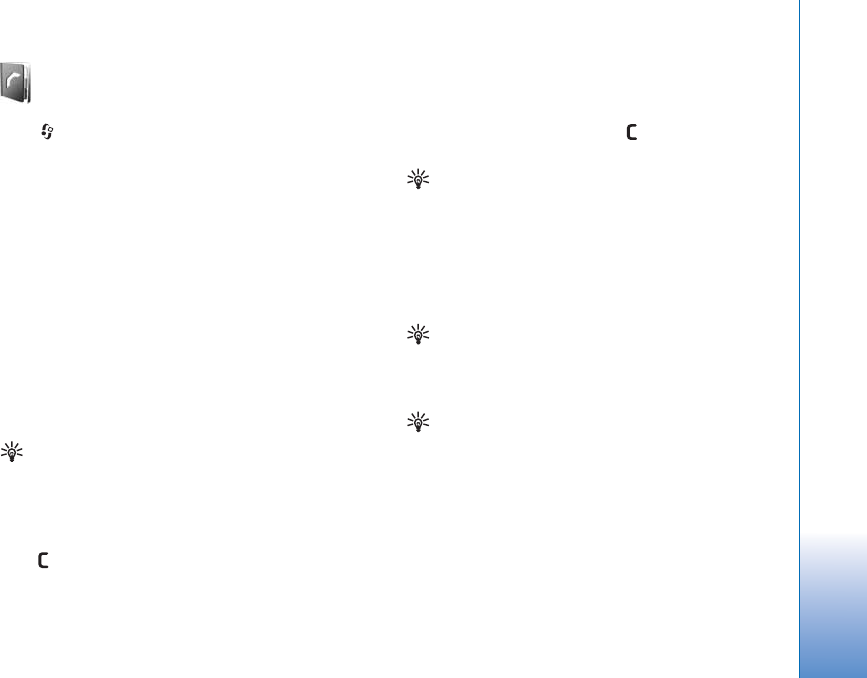
Contacts (phonebook)
55
Copyright © 2006 Nokia. All rights reserved.
Contacts (phonebook)
Press , and select Contacts. In Contacts you can add a
personal ringing tone or a thumbnail image to a contact
card. You can also create contact groups, which allow you
to send text messages or e-mail to many recipients at the
same time. You can add received contact information
(business cards) to contacts. See ‘Data and settings’, p. 47.
Contact information can only be sent to or received from
compatible devices.
Save names and numbers
1Select Options > New contact.
2Fill in the fields that you want, and select Done.
To edit contact cards in Contacts, scroll to the contact
card you want to edit, and select Options > Edit.
Tip! To print contact cards on a compatible Basic Print
Profile (BPP) equipped printer with Bluetooth
connectivity (such as HP Deskjet 450 Mobile Printer or
HP Photosmart 8150), select Options > Print.
To delete a contact card in Contacts, select a card, and
press . To delete several contact cards at the same time,
select Options > Mark/Unmark > Mark all to mark all the
contacts, then Mark/Unmark > Unmark to unmark the
contacts you want to keep. Press to delete the marked
contacts.
Tip! To add and edit contact cards, use Nokia
Contacts Editor available in Nokia PC Suite, provided
on the CD- ROM supplied with your device.
To attach a small thumbnail image to a contact card, open
the contact card, and select Options > Edit > Options >
Add thumbnail. The thumbnail image is shown when the
contact calls.
Tip! Speed dialing is a quick way to call frequently
used numbers. You can assign speed dialing keys to
eight phone numbers. See ‘Speed dial a phone number’,
p. 59.
Tip! To send contact information, select the card you
want to send. Select Options > Send > Via text
message, Via multimedia, Via e-mail (shown only if
you have set up a mailbox), Via Bluetooth, or Via
infrared. See ‘Messaging’, p. 42 and ‘Send data using
Bluetooth connectivity’, p. 83.
To add a contact to a group, select Options > Add to
group: (shown only if you have created a group). See
‘Create contact groups’, p. 57.

Contacts (phonebook)
56 Copyright © 2006 Nokia. All rights reserved.
To view the amount of contacts, groups, and the available
memory in Contacts, select Options > Contacts info.
Default numbers and addresses
You can assign default numbers or addresses to a contact
card. In this way if a contact has several numbers or
addresses, you can easily call or send a message to the
contact to a certain number or address. The default
number is also used in voice dialing.
1In the address book, select a contact, and press .
2Select Options > Defaults.
3Select a default to which you want to add a number or
an address, and select Assign.
4Select a number or an address you want to set as a
default.
The default number or address is underlined in the contact
card.
Copy contacts
To copy names and numbers from a SIM card to your
device, press , and select Contacts > Options > SIM
contacts > SIM directory. Select the names you want to
copy and Options > Copy to Contacts.
To copy contacts to your SIM card, press , and select
Contacts. Select the names you want to copy and
Options > Copy to SIM direct., or Options > Copy > To
SIM directory. Only the contact card fields supported by
your SIM card are copied.
To copy contacts to and from a compatible memory card,
select the names you want to copy and Options > Copy >
To memory card or From memory card.
Tip! You can synchronize your contacts to a
compatible PC with Nokia PC Suite, provided on the
CD-ROM supplied with your device.
SIM directory and other SIM services
For availability and information on using SIM card services,
contact your SIM card vendor. This may be the service
provider, network operator, or other vendor.
Press , and select Contacts > Options > SIM
contacts > SIM directory to see the names and numbers
stored on the SIM card. In the SIM directory you can add,
edit, or copy numbers to contacts, and you can make calls.
To view the list of fixed dialing numbers, select Options >
SIM contacts > Fixed dialling contacts. This setting is
only shown if supported by your SIM card.
To restrict calls from your device to selected phone
numbers, select Options > Activ. fixed dialling. To add
new numbers to the fixed dialing list, select Options >
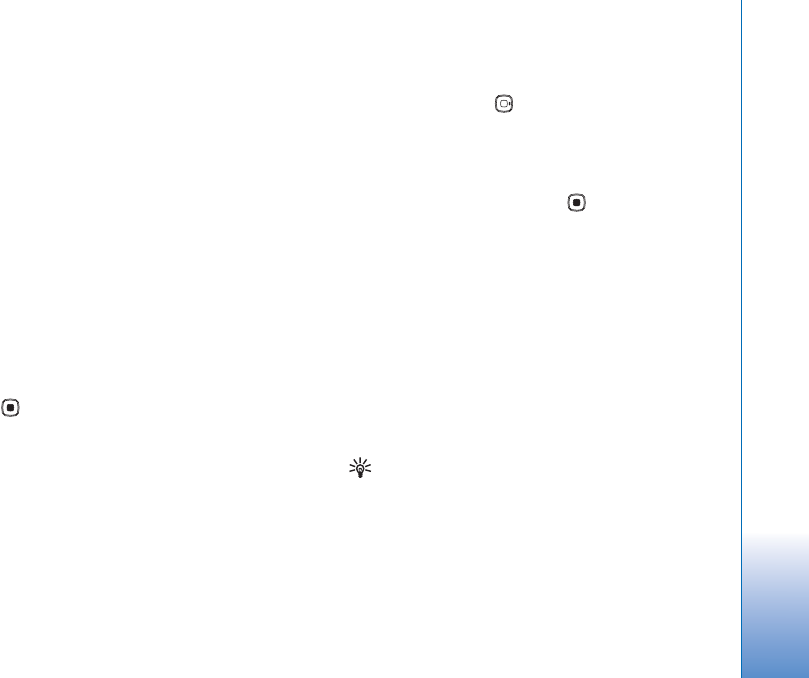
Contacts (phonebook)
57
Copyright © 2006 Nokia. All rights reserved.
New SIM contact. You need the PIN2 code for these
functions.
When you use Fixed dialling, packet data connections are
not possible, except when sending text messages over a
packet data connection. In this case, the message center
number and the recipient’s phone number must be
included on the fixed dialing list.
When fixed dialing is activated, calls may be possible to
the official emergency number programmed into your
device.
Add ringing tones for contacts
When a contact or group member calls you, the device
plays the chosen ringing tone (if the caller’s telephone
number is sent with the call and your device recognizes it).
1Press to open a contact card or go to the groups list,
and select a contact group.
2Select Options > Ringing tone. A list of ringing tones
opens.
3Select the ringing tone you want to use for the
individual contact or the selected group.
To remove the ringing tone, select Default tone from the
list of ringing tones.
Create contact groups
1In Contacts, press to open the groups list.
2Select Options > New group.
3Write a name for the group or use the default name
Group, and select OK.
4Open the group, and select Options > Add members.
5Scroll to a contact, and press to mark it. To add
multiple members at a time, repeat this action on all
the contacts you want to add.
6Select OK to add the contacts to the group.
To rename a group, select Options > Rename, enter the
new name, and select OK.
Remove members from a group
1In the groups list, open the group you want to modify.
2Scroll to the contact, and select Options > Remove
from group.
3Select Yes to remove the contact from the group.
Tip! To check to which groups a contact belongs,
scroll to the contact, and select Options > Belongs to
groups.

Make calls
58 Copyright © 2006 Nokia. All rights reserved.
Make calls
Voice calls
Tip! To increase or decrease the volume during a
call, press the volume key on the side of the device.
1In the standby mode, enter the phone number,
including the area code. To remove a number, press
.
For international calls, press twice for the +
character (replaces the international access code), and
enter the country code, area code (omit the leading
zero if necessary), and phone number.
2Press to call the number.
3Press to end the call (or to cancel the call
attempt).
Pressing always ends a call, even if another
application is active.
To make a call from Contacts, press , and select
Contacts. Scroll to the desired name, or enter the first
letters of the name to the search field. Matching contacts
are listed. To call, press . Select the call type Voice
call.
You must copy the contacts from your SIM card to
Contacts before you can make a call this way. See ‘Copy
contacts’, p. 56.
To call your voice mailbox (network service), press and hold
in the standby mode. See also ‘Call divert’, p. 114.
Tip! To change the phone number of your voice
mailbox, press , and select Tools > Voic. mail >
Options > Change number. Enter the number
(obtained from your service provider), and select OK.
To call a recently dialed number in the standby mode, press
. Scroll to the number, and press .
Make a conference call
1Make a call to the first participant.
2To make a call to another participant, select Options >
New call. The first call is automatically put on hold.
3When the new call is answered, to join the first
participant in the conference call, select Options >
Conference.
To add a new person to the call, repeat step 2, and
select Options > Conference > Add to conference.
Your device supports conference calls between a
maximum of six participants, including yourself.

Make calls
59
Copyright © 2006 Nokia. All rights reserved.
To have a private conversation with one of the
participants, select Options > Conference > Private.
Scroll to a participant and Private. The conference call
is put on hold on your device. The other participants
can still continue the conference call. After you finish
the private conversation, select
Options >Conference > Add to conference to return
to the conference call.
To drop a participant, select Options > Conference >
Drop participant, scroll to the participant, and select
Drop.
4To end the active conference call, press .
Speed dial a phone number
To activate speed dialing, press , and select Tools >
Settings > Call > Speed dialling> On.
To assign a phone number to one of the speed dialing keys
( — ), press , and select Tools > Spd. dial. Scroll to
the key to which you want to assign the phone number,
and select Options > Assign. is reserved for the voice
mailbox.
To call in the standby mode, press the speed dial key and
.
Voice dialing
Your device supports enhanced voice commands.
Enhanced voice commands are not dependent on the
speaker’s voice, so the user does not record voice tags in
advance. Instead, the device creates a voice tag for the
entries in contacts, and compares the spoken voice tag to
it. The voice recognition in the device adapts to the main
user’s voice to recognize the voice commands better.
The voice tag for a contact is the name or nickname that
is saved on the contact card. To listen to the synthesized
voice tag, open a contact card, and select Options > Play
voice tag.
Make a call with a voice tag
Note: Using voice tags may be difficult in a noisy
environment or during an emergency, so you should
not rely solely upon voice dialing in all circumstances.
When you use voice dialing, the loudspeaker is in use. Hold
the device at a short distance away when you say the
voice tag.
1To start voice dialing, in the standby mode, press and
hold the right selection key. If you are using a
compatible headset with the headset key, press and
hold the headset key to start voice dialing.
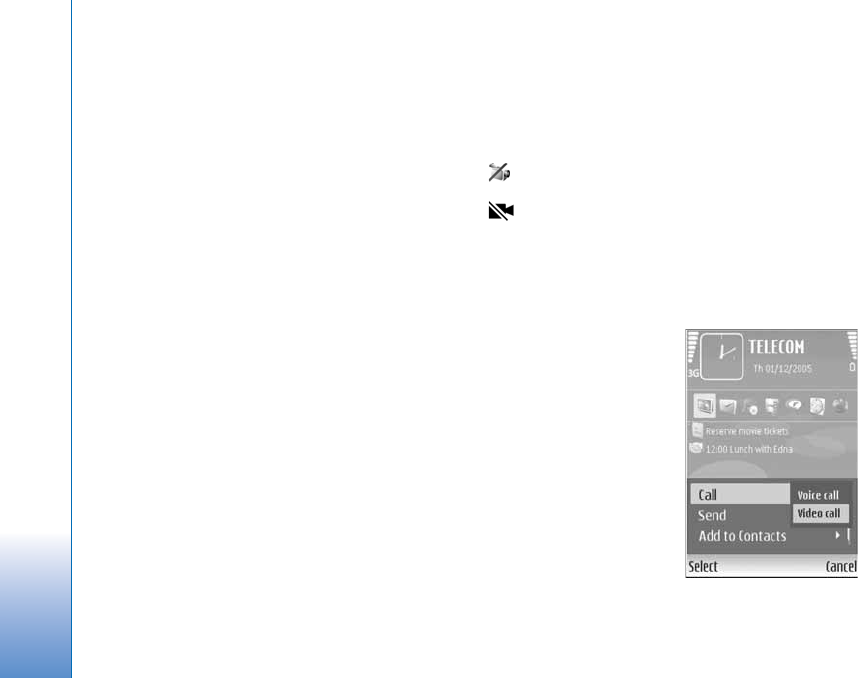
Make calls
60 Copyright © 2006 Nokia. All rights reserved.
2A short tone is played, and Speak now is displayed. Say
clearly the name or nickname that is saved on the
contact card.
3The device plays a synthesized voice tag for the
recognized contact in the selected device language,
and displays the name and number. After a time-out
of 2.5 seconds, the device dials the number.
If the recognized contact was not correct, select Next
to view a list of other matches, or Quit to cancel voice
dialing.
If several numbers are saved under the name, the device
selects the default number, if it has been set. Otherwise
the device selects the first available number of the
following: Mobile, Mobile (home), Mobile (business),
Telephone, Tel. (home), and Tel. (business).
Video calls
When you make a video call (network service), you can see
a real-time, two-way video between you and the recipient
of the call. The live video image, or video image captured
by the camera in your device is shown to the video call
recipient.
To be able to make a video call, you must have a USIM
card and be in the coverage of a UMTS network. For
availability of and subscription to video call services,
contact your network operator or service provider.
A video call can only be made between two parties. The
video call can be made to a compatible mobile device or an
ISDN client. Video calls cannot be made while another
voice, video, or data call is active.
Icons:
You are not receiving video (the recipient is not
sending video or the network is not transmitting it).
You have denied video sending from your device. To
send a still image instead, see ‘Call’, p. 107.
Even if you denied video sending during a video call, the
call is still charged as a video call. Check the pricing with
your network operator or service provider.
1To start a video call,
enter the phone
number in the standby
mode, or select
Contacts and a
contact.
2Select Options >
Call > Video call.
Starting a video call may
take a while. Waiting for
video image is shown. If
the call is not successful
(for example, video calls
are not supported by the
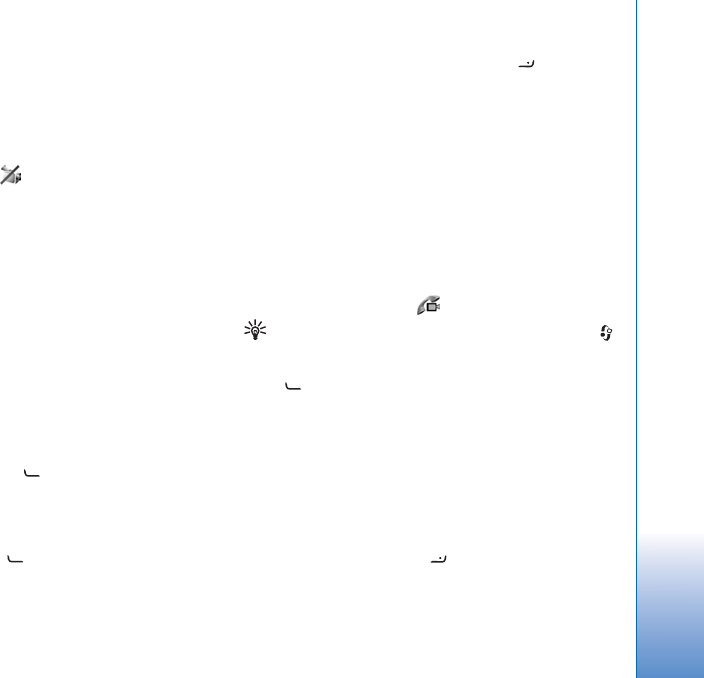
Make calls
61
Copyright © 2006 Nokia. All rights reserved.
network, or the receiving device is not compatible) you are
asked if you want to try a normal call or send a text
message instead.
The video call is active when you see two video images and
hear the sound through the loudspeaker. The call recipient
may deny video sending ( ), in which case you only hear
the sound and may see a still image or a grey background
graphic.
To change between showing video or hearing only sound,
select Options > Enable/Disable > Sending video,
Sending audio or Sending audio & video.
To change the camera in use, select Options > Use main
camera or Use secondary camera.
To zoom your own image, select Options> Zoom in or
Zoom out. The zoom indicator is shown on the top of the
display.
To switch the places of the sent video images on the
display, select Options >Change image order.
To end the video call, press .
Answer or decline a call
To answer the call, press .
To mute the ringing tone when a call comes in, select
Silence.
If you do not want to answer a call, press . If you have
activated the Call divert > If busy function to divert calls,
declining an incoming call also diverts the call. See ‘Call
divert’, p. 114.
When you decline an incoming call, you can send a text
message to the caller informing why you cannot answer
the call. Select Options > Send text message. You can
edit the text before sending it. To set up this option and
write a standard text message, see ‘Call’, p. 107.
Answer or reject a video call
When a video call arrives, is displayed.
Tip! To assign a ringing tone for video calls, press ,
and select Tools >Profiles.
Press to answer the video call. Allow video image to
be sent to caller? appears on the display. To start sending
a live video image, select Yes.
If you do not activate the video call, video sending is not
activated, and you only hear the sound of the caller. A grey
screen is shown in place of the video image. To replace the
grey screen with a still image captured by the camera in
your device, see ‘Call’, Image in video call, p. 107.
To end the video call, press .
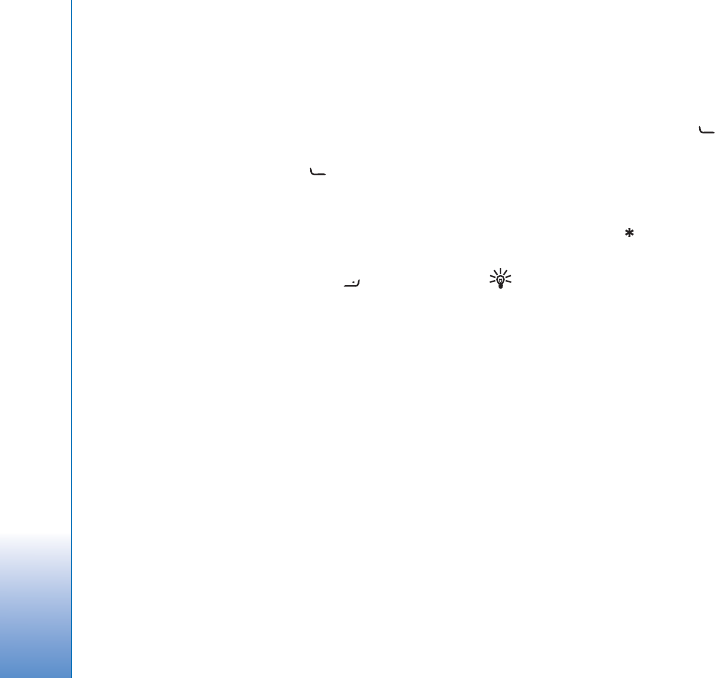
Make calls
62 Copyright © 2006 Nokia. All rights reserved.
Call waiting
You can answer a call while you have another call in
progress if you have activated Call waiting (network
service) in Tools > Settings > Call.
To answer the waiting call, press . The first call is put
on hold.
To switch between the two calls, select Swap. To connect
an incoming call or a call on hold with an active call and
to disconnect yourself from the calls, select Options >
Transfer. To end the active call, press . To end both
calls, select Options > End all calls.
Options during a voice call
Many of the options that you can use during a voice call
are network services. Select Options during a call for
some of the following options: Mute or Unmute, Answer,
Reject, Swap, Hold or Unhold, Activate handset,
Activate loudsp., or Activate handsfree (if a compatible
headset with Bluetooth connectivity is attached), End
active call or End all calls, New call, Conference,
Transfer, and Open active standby. Select from the
following:
Replace—to end an active call and replace it by answering
the waiting call.
Send MMS (in UMTS networks only)—to send an image or
a video in a multimedia message to the other participant
of the call. You can edit the message and change the
recipient before sending. Press to send the file to a
compatible device (network service).
Send DTMF—to send DTMF tone strings, for example, a
password. Enter the DTMF string or search for it in
Contacts. To enter a wait character (w) or a pause
character (p), press repeatedly. Select OK to send the
tone.
Tip! You can add DTMF tones to the Phone number
or DTMF fields in a contact card.
Options during a video call
Select Options during a video call for the following
options: Enable or Disable (video, audio, or both), Activate
handset (if a compatible headset with Bluetooth
connectivity is attached) or Activate handsfree (when a
compatible headset with Bluetooth connectivity is
attached), Activate loudsp., End active call, Open active
standby, Use main camera/Use secondary camera,
Change image order, Zoom in/Zoom out, and Help.
The available options may vary.

Make calls
63
Copyright © 2006 Nokia. All rights reserved.
Log
To monitor the phone numbers of missed, received, and
dialed voice calls, press , and select My own > Log>
Recent calls. The device registers missed and received calls
only if the network supports these functions, the device is
switched on, and within the network service area.
To clear all recent call lists, select Options > Clear recent
calls in the recent calls main view. To clear one of the call
registers, open the register you want to erase, and select
Options > Clear list. To clear an individual event, open a
register, scroll to the event, and press .
Call duration
To monitor the approximate duration of your incoming and
outgoing calls, press , and select My own > Log > Call
duration.
To set the display of the call timers while a call is active,
select My own > Log> Options > Settings > Show call
duration > Yes or No.
Note: The actual time invoiced for calls by your
service provider may vary, depending on network
features, rounding off for billing, and so forth.
To clear call duration timers, select Options > Clear
timers. For this you need the lock code. See ‘Phone and
SIM’, p. 112.
Packet data
To check the amount of data sent and received during
packet data connections, press , and select My own >
Log > Packet data. For example, you may be charged for
your packet data connections by the amount of data sent
and received.
Monitor all communication events
Icons in Log:
Incoming
Outgoing
Missed communication
events
To monitor all voice calls, text
messages, or data and wireless
LAN connections registered by
the device, press , select My
own> Log, and scroll right to
open the general log. For each
communication event, you can
see the sender or recipient
name, phone number, name of the service provider, or
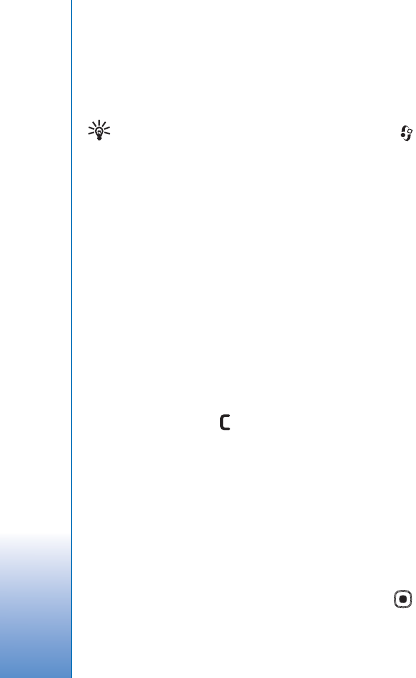
Make calls
64 Copyright © 2006 Nokia. All rights reserved.
access point. You can filter the general log to view just
one type of event, and create new contact cards based on
the log information.
Tip! To view a list of sent messages, press , and
select Messaging > Sent.
Subevents, such as a text message sent in more than one
part and packet data connections, are logged as one
communication event. Connections to your mailbox,
multimedia messaging center, or Web pages are shown as
packet data connections.
To add an unknown phone number from Log to your
contacts, select Options > Add to contacts.
To filter the log, select Options > Filter and a filter.
To erase the contents of the log, recent calls register, and
messaging delivery reports permanently, select Options >
Clear log. Select Yes to confirm. To remove a single event
from the log, press .
To set the Log duration, select Options > Settings > Log
duration. The log events remain in the device memory for
a set number of days after which they are automatically
erased to free memory. If you select No log, all the log
contents, recent calls register, and messaging delivery
reports are permanently deleted.
To view the details of a communication event, in the
general log view, scroll to an event, and press .
Packet data counter and connection timer: To view how
much data, measured in kilobytes, is transferred and how
long a certain packet data connection lasts, scroll to an
incoming or outgoing event indicated by Pack., and select
Options > View details.

Services
65
Copyright © 2006 Nokia. All rights reserved.
Services
Press , and select Services (network service).
Various service providers maintain pages specifically
designed for mobile devices. These pages use the wireless
markup language (WML), extensible hypertext markup
language (XHTML), or hypertext markup language (HTML).
Check the availability of services, pricing, and fees with
your network operator or service provider. Service
providers will also give you instructions on how to use their
services.
Shortcut: To start a connection, press and hold
in the standby mode.
Access point
To access pages, you need Web service settings for the
page that you want to use. You may receive the settings in
a special text message from the network operator or
service provider that offers the Web page. See ‘Data and
settings’, p. 47. For more information, contact your
network operator or service provider.
Tip! Settings may be available on the Web site of a
network operator or service provider.
Enter settings manually
1Press , select Tools > Settings > Connection >
Access points, and define the settings for an access
point. Follow the instructions given to you by your
service provider. See ‘Connection’, p. 108.
2Press , and select Services > Options > Bookmark
manager > Add bookmark. Write a name for the
bookmark and the address of the page defined for the
current access point.
3To set the created access point as the default access
point, select Options > Settings > Access point.
Bookmarks view
The bookmarks view opens when you open Services.
Your device may have some bookmarks loaded for sites not
affiliated with Nokia. Nokia does not warrant or endorse
these sites. If you choose to access them, you should take
the same precautions, for security or content, as you
would with any Internet site.
indicates the starting page defined for the default
access point.
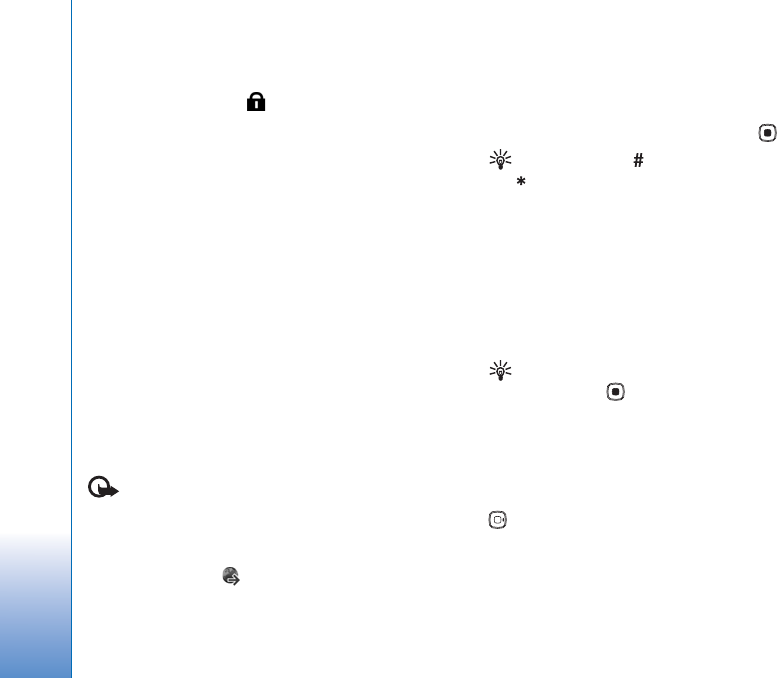
Services
66 Copyright © 2006 Nokia. All rights reserved.
Connection security
If the security indicator is displayed during a
connection, the data transmission between the device and
the Internet gateway or server is encrypted.
The security icon does not indicate that the data
transmission between the gateway and the content server
(or place where the requested resource is stored) is secure.
The service provider secures the data transmission
between the gateway and the content server.
Select Options > Details > Security to view details about
the connection, encryption status, and information about
server and user authentication.
Security certificates may be required for some services,
such as banking services. For more information, contact
your service provider. See also ‘Certificate management’,
p. 113.
Browse
Important: Use only services that you trust and that
offer adequate security and protection against harmful
software.
To download a page, select a bookmark, or enter the
address in the field ( ).
On a browser page, new links appear underlined in blue
and previously visited links in purple. Images that act as
links have a blue border around them.
To open links and make selections, press .
Shortcut: Press to jump to the end of a page and
to the beginning of a page.
To go to the previous page while browsing, select Back. If
Back is not available, select Options > Navigation
options > History to view a chronological list of the pages
you visited during a browsing session.
To retrieve the latest content from the server, select
Options > Navigation options > Reload.
To save a bookmark, select Options > .Save
Tip! To access the bookmarks view while browsing,
press and hold . To return to the browser view, select
Options > Back to page.
To save a page while browsing, select Options > Advanced
options > Save page. You can save pages to the device
memory or compatible memory card (if inserted), and
browse them when offline. To access the pages later, press
in the bookmarks view to open the Saved pages view.
To enter a new URL address, select Options > Navigation
options > Go to web address.

Services
67
Copyright © 2006 Nokia. All rights reserved.
To open a sublist of commands or actions specific for the
currently open page, select Options > Service options, if
available
You can download files that cannot be shown on the
browser page, such as ringing tones, images, operator
logos, themes, and video clips. To download an item, scroll
to the link, and press .
When you start a download, a list of ongoing, paused, and
completed downloads from the current browsing session is
displayed. You can also view the list by selecting Options >
Tools > Downloads. In the list, scroll to an item, and select
Options to pause, resume, or cancel ongoing downloads, or
open, save, or delete completed downloads.
Download and purchase items
You can download items such as ringing tones, images,
operator logos, themes, and video clips. These items can be
provided free, or you can purchase them. Downloaded
items are handled by the respective applications in your
device, for example, a downloaded photo can be saved in
Gallery.
Important: Only install and use applications and
other software from sources that offer adequate security
and protection against harmful software.
1To download the item, scroll to the link, and press .
2Select the appropriate option to purchase the item.
3Carefully read all the information provided.
To continue the download, select Accept. To cancel the
download, select Cancel.
End a connection
To end the connection and view the browser page offline,
select Options > Advanced options > Disconnect, or to
end the connection and close the browser, select
Options > Exit.
Empty the cache
The information or services you have accessed are stored
in the cache memory of the device.
A cache is a memory location that is used to store data
temporarily. If you have tried to access or have accessed
confidential information requiring passwords, empty the
cache after each use. The information or services you have
accessed are stored in the cache. To empty the cache,
select Options > Advanced options > Clear cache.
Settings
Select Options > Settings and from the following:

Services
68 Copyright © 2006 Nokia. All rights reserved.
Access point—Change the default access point. See
‘Connection’, p. 108. Some or all access points may be
preset for your device by your service provider or network
operator, and you may not be able to change, create, edit,
or remove them.
Homepage—Define the home page.
Load imgs. & sounds—Select whether you want to load
images while browsing. If you select No, to load images
later during browsing, select Options > Show images.
Font size—Select the text size.
Default encoding—If text characters are not shown
correctly, you can select another encoding according to
language.
Auto. bookmarks—Enable or disable automatic bookmark
collecting. If you want to continue collecting automatic
bookmarks but hide the folder from the bookmarks view,
select Hide folder.
Screen size—Select what is shown when you are
browsing: Select. keys only or Full screen.
Search page—Define a Web page that is downloaded
when you select Navigation options > Open search page
in the bookmarks view, or when browsing.
Rendering—If you want the page layout shown as
accurately as possible when in Small screen mode, select
By quality. If you do not want external cascading style
sheets to be downloaded, select By speed.
Cookies—Enable or disable the receiving and sending of
cookies.
Java/ECMA script—Enable or disable the use of scripts.
Security warnings—Hide or show security notifications.
Conf. DTMF sending—Select whether you want to confirm
before the device sends DTMF tones during a voice call. See
also ‘Options during a voice call’, p. 62.

Calendar
69
Copyright © 2006 Nokia. All rights reserved.
Calendar
Use Calendar to remind you of meetings and anniversaries,
and to keep track of your tasks and other notes.
Create calendar entries
Shortcut: In the day, week, or month calendar view,
press any number key. An appointment entry opens, and
the characters you enter are added to the Subject field.
In the to-do view, a to-do note entry opens.
1Press , and select
Calendar > Options >
New entry and one of the
following:
Meeting—to remind you
of an appointment that
has a specific date and
time
Memo—to write a general
entry for a day
Anniversary—to remind
you of birthdays or special
dates (entries are
repeated every year)
To-do—to remind you of a task that needs doing by a
specific date
2Fill in the fields. To set an alarm, select Alarm > On,
and enter the Alarm time and Alarm date.
To add a description for an appointment or a meeting,
select Options > Add description.
3To save the entry, select Done.
When the calendar alarms for a note, select Silence to
turn off the calendar alarm tone. The reminder text stays
on the screen. To end the calendar alarm, select Stop. To
set the alarm to snooze, select Snooze.
Tip! You can synchronize your calendar with a
compatible PC using Nokia PC Suite supplied with your
device. When creating a calendar entry, set the desired
Synchronisation option.
Calendar views
Tip! Select Options > Settings to change the starting
day of the week or the view that is shown when you
open the calendar.
In the month view, dates that have calendar entries are
marked with a small triangle in the bottom rightcorner. In

Calendar
70 Copyright © 2006 Nokia. All rights reserved.
the week view, memos and anniversaries are placed
before 8 a.m. To switch between the month view, week
view, day view, and to-do view, press .
To go to a certain date, select Options > Go to date. To
jump to today, press .
To send a calendar note to a compatible device, select
Options > Send.
To print calendar entries on a compatible Basic Print
Profile (BPP) equipped printer with Bluetooth connectivity
(such as HP Deskjet 450 Mobile Printer or HP Photosmart
8150), select Options > Print.
Manage your calendar entries
Deleting past entries in Calendar saves space in your
device memory.
To delete more than one event at a time, go to the month
view, and select Options > Delete entry > Before date or
All entries.
To mark a task as completed, scroll to it in the to-do view,
and select Options > Mark as done.
Calendar settings
To modify the Calendar alarm tone, Default view, Week
starts on, and Week view title, select Options > Settings.

My own
71
Copyright © 2006 Nokia. All rights reserved.
My own
Go to—add shortcuts
Press , and select My own > Go to.
Default shortcuts are the following: opens Calendar,
opens Inbox, and opens Notes.
IM—instant messaging
Press , and select My own > IM.
Instant messaging (network service) allows you to
converse with other people using instant messages and
join discussion forums (IM groups) with specific topics.
Various service providers maintain IM servers that you can
log in to after you register to an IM service. Service
providers may differ in their support of features.
Select Conversations to start or continue a conversation
with an IM user; IM contacts to create, edit, or view the
online status of your IM contacts; IM groups to start or
continue a group conversation with multiple IM users; or
Record. chats to view a previous instant messaging
session that you saved.
Receive IM settings
You must save the settings to access the service that you
want to use. You may receive the settings in a special text
message from the network operator or service provider
that offers the IM service. See ‘Data and settings’, p. 47.
You can also enter the settings manually. See ‘Chat server
settings’, p. 73.
Connect to an IM server
1To connect to the IM server in use, open IM, and select
Options > Login. To change the IM server in use and
save new IM servers, see ‘Chat server settings’, p. 73.
2Enter your user ID and password, and press to log
in. You obtain the user ID and password for the IM
server from your service provider.
3To log out, select Options > Logout.
Modify your IM settings
Select Options > Settings > IM settings and from the
following:
Use screen name (shown only if IM groups are supported
by the server)—To enter a nickname, select Yes.

My own
72 Copyright © 2006 Nokia. All rights reserved.
IM presence—To allow others to see if you are online,
select Active for all.
Allow messages from—To allow messages from all, select
All.
Allow invitations from—To allow invitations only from
your IM contacts, select IM contacts only. IM invitations
are sent by IM contacts who want you to join their groups.
Msg. scrolling speed—Select the speed at which new
messages are displayed.
Sort IM contacts—Select how your IM contacts are
sorted: Alphabetically or By online status.
Availabil. reloading—To select how to update
information about whether your IM contacts are online or
offline, select Automatic or Manual.
Offline contacts—Select whether IM contacts with an
offline status are shown in the IM contacts list.
Own message colour—Select the color of the instant
messages you send.
Received msg colour—Select the color of the instant
messages you receive.
IM alert tone—Change the tone played when you receive
a new instant message.
Search for IM groups and users
To search for groups, in the IM groups view, select
Options > Search. You can search by Group name, Topic,
and Members (user ID).
To search for users, in the IM contacts view, select
Options > New IM contact > Search from server. You
can search by User's name, User ID, Phone number, and
E-mail address.
Join IM groups
The IM groups view shows a list of the IM groups that you
have saved or are currently joined to.
To join a saved IM group, press .
To join an IM group that is not on the list, but for which
you know the group ID, select Options > Join new group.
To leave the IM group, select Options > Leave IM group.
Chat
After you join an IM group, you can view the messages that
are exchanged there, and send your own messages.
To send a message, write the message in the message
editor field, and press .

My own
73
Copyright © 2006 Nokia. All rights reserved.
To send a private message to a participant, select
Options > Send private msg..
To reply to a private message sent to you, select the
message and Options > Reply.
To invite IM contacts who are online to join the IM group,
select Options > Send invitation.
To prevent receiving messages from certain participants,
select Options > Blocking options.
Record chats
To record the messages that are exchanged during a
conversation or while you are joined in a IM group, select
Options > Record chat. To stop recording, select
Options > Stop recording. To view the recorded chats, in
the main view, select Record. chats.
View and start conversations
The Conversations view shows a list of the individual
conversation participants that you have an ongoing
conversation with. Ongoing conversations are
automatically closed when you exit IM.
To view a conversation, scroll to a participant, and press
.
To continue the conversation, write your message, and
press .
To return to the conversations list without closing the
conversation, select Back. To close the conversation,
select Options > End conversation.
To start a new conversation, select Options > New
conversation.
To save a conversation participant to your IM contacts,
select Options > Add to IM contacts.
To send automatic replies to incoming messages, select
Options > Set auto reply on. You can still receive
messages.
IM contacts
In the IM contacts view, you can retrieve chat contact
lists from the server, or add a new chat contact to a
contact list. When you log in to the server, the previously
used chat contact list is retrieved from the server
automatically.
Chat server settings
Select Options > Settings > Server settings. You may
receive the settings in a special text message from the
network operator or service provider that offers the chat
service. You obtain the user ID and password from your
service provider when you register to the service. If you do

My own
74 Copyright © 2006 Nokia. All rights reserved.
not know your user ID or password, contact your service
provider.
Servers—View a list of all defined IM servers.
Default server—Change the IM server to which you want
to connect.
IM login type—To log in automatically when you start IM,
select On app. start-up.
To add a new server to your list of IM servers, select
Servers > Options > New server. Enter the following
settings:
Server name—the name for the chat server
Access point in use—the access point you want to use for
the server
Web address—the URL address of the IM server
User ID—your user ID
Password—your login password
Positioning
Press , and select My own > Position.. With
Positioning, you can enable one or more positioning
methods to allow compatible applications to receive the
position information of the current location of your
device. When you enable a positioning method you can, for
example, save the position information of your current
location in Landmarks and Navigator.
Positioning methods may be network based (network
service) or they may require that you use a compatible GPS
receiver. To enable a positioning method, scroll the
method, and select Options > Enable.
To start using a compatible GPS receiver with Bluetooth
connectivity for positioning, scroll to Bluetooth GPS, and
select Options > Enable. If asked, select your GPS receiver
from the found devices with Bluetooth connectivity, and
pair the devices. See “Pair devices”, p. 83.
The Global Positioning System
The Global Positioning System (GPS) is operated by the
United States government, which is solely responsible for
accuracy and maintenance of the system. The accuracy of
location data can be affected by adjustments to GPS
satellites made by the United States government and is
subject to change with the United States Department of
Defense civil GPS policy and the Federal Radionavigation
Plan. Accuracy can also be affected by poor satellite
geometry. Availability and quality of GPS signals may be
affected by your location, buildings and natural obstacles
as well as weather conditions. The GPS receiver should only
be used outdoors to allow reception of GPS signals. GPS
should only be used as a navigation aid. It should not be
used for precise location measurement and you should

My own
75
Copyright © 2006 Nokia. All rights reserved.
never rely solely on location data from the GPS receiver for
positioning or navigation.
You may receive a request from a network service to
receive your position information. Service providers may
offer information about local topics, such as weather or
traffic conditions, based upon the location of your device.
When you receive a position request, a message is
displayed showing the service that is making the request.
Select Accept to allow your position information to be
sent, or select Reject to deny the request.
Landmarks
Press , and select My own > Landmarks. With
Landmarks, you can save the position information of
specific locations in your device. You can sort the saved
locations into different categories, such as business, and
add other information, such as addresses, to them. You can
use your saved landmarks in compatible navigation
applications, such as Navigator in your Nokia N92.
To create a new landmark, select Options > New
landmark. If your device is connected to a compatible GPS
receiver, you can make a positioning request for the
coordinates of your current location. Select Current
position to retrieve the position information. To enter the
position information manually, select Enter manually.
To edit or add information to a saved landmark, for
example, a street address, scroll to a landmark, and press
. Scroll to the desired field and enter the information.
You can sort your landmarks into the preset categories,
and create new categories. To edit and create new
landmark categories, scroll right in Landmarks, and select
Options > Edit categories.
To add a landmark to a category, scroll to the landmark,
and select Options > Add to category. Scroll to each
category to which you want to add the landmark, and
press the scroll key to select it.
To send one or several landmark to a compatible device,
select Options > Send. Your received landmarks are
placed in the Inbox folder in Messaging.
Navigator
Press , and select My own > Navigator. Navigator is
designed to provide route guidance information to a
selected destination, position information about your
current location, and traveling information, such as the
approximate distance to the destination and approximate
duration of travel.

My own
76 Copyright © 2006 Nokia. All rights reserved.
To use Navigator as a navigation aid, your device must be
connected to a compatible GPS receiver. The GPS receiver
must receive position information from at least three
satellites to calculate the coordinates of your location.
Route guidance
To use route guidance, scroll to Navigation, and press .
Start the route guidance outdoors. If started indoors, the
GPS receiver may not receive the necessary information
from the satellites.
Route guidance uses a rotating compass on the device
display. A red ball shows the direction to the destination,
and the approximate distance to it is shown inside the
compass ring.
Route guidance is designed to show the straightest route
and the shortest distance to the destination, measured in
a straight line. Any obstacles on the route, such as
buildings and natural obstacles, are ignored. Differences
in altitude are not taken into account when calculating
the distance. Route guidance is active only when you
move.
To set your trip destination, select Options > Set
destination, and select a landmark or waypoint as the
destination, or enter the latitude and longitude
coordinates. Select Stop navigation to clear the
destination set for your trip.
Retrieve position information
To view the position information of your current location,
connect your device to a compatible GPS receiver, scroll to
Position, and press . The GPS receiver can calculate its
location to the accuracy of meters. An estimate of the
accuracy of the location is shown on the display.
To save your current location as a waypoint or landmark,
select Options > Save position. Waypoints are locations
that you can save and use in Navigator only. Landmarks
are saved locations with more information, and they can
be used in other compatible applications and transferred
between compatible devices.
Trip meter
Scroll to Trip distance, and press . Select Options >
Start to activate trip distance calculation, and Stop to
deactivate it. The calculated values remain on the display.
Select Reset to set the trip distance and time, and average
and maximum speeds to zero, and to start a new
calculation. Select Restart to also set the odometer and
total time to zero.
Trip meter has limited accuracy, and rounding errors may
occur. Accuracy can also be affected by availability and
quality of GPS signals.

My own
77
Copyright © 2006 Nokia. All rights reserved.
3-D tones
Press , and select My own > 3-D tones. With 3-D
tones you can enable three-dimensional sound effects for
ringing tones. Not all ringing tones support 3-D effects.
To enable the 3-D effects, select 3-D ringing tone
effects > On. To change the ringing tone, select Ringing
tone and the desired tones.
To change the 3–D effect that is applied to the ringing
tone, select Sound trajectory and the desired effect. To
modify the effect, select from the following settings:
Trajectory speed—Scroll left or right to adjust the speed at
which sound moves from one direction to another. This
setting is not available for all ringing tones.
Doppler effect—Select On to have the ringing tone sound
higher when you are closer to your device, and lower when
you are farther away. When you get closer to the device,
the ringing tone appears to become higher, and lower
when you move away from it. This setting is not available
for all ringing tones.
Reverberation—Select the type of echo.
To listen to the ringing tone with the 3–D effect, select
Options > Play tone
If you enable the 3-D tones but do not select any 3-D
effect, stereo widening is applied to the ringing tone.
To adjust the ringing tone volume, select Tools >
Profiles > Options > Personalise > Ringing volume.
Nokia Lifeblog
Nokia Lifeblog multimedia diary is a combination of
software for the mobile phone and PC that keeps a
multimedia diary of the items that you collect with your
device. Nokia Lifeblog multimedia diary automatically
organizes your photos, videos, sounds, text messages,
multimedia messages, and weblog posts into a chronology
that you can browse, search, share, publish, and back up.
Both Lifeblog PC and Lifeblog mobile let you send or blog
your items for others to see.
Lifeblog mobile automatically keeps track of your
multimedia items. Use Lifeblog mobile on your device to
browse your items, send them to others, or publish them
on the Web. Connect your device to a compatible PC using
a USB data cable or Bluetooth connectivity to transfer and
synchronize the items on the device with your compatible
PC.
Lifeblog PC provides easy browsing and searching of the
items that you collected with your device. With

My own
78 Copyright © 2006 Nokia. All rights reserved.
one-button transfer using a USB data cable or Bluetooth
connectivity, your favorite photos, videos, text, and
multimedia messages are transferred back to your device.
For safekeeping, you can back up your Lifeblog database
using your hard disk, CDs, DVDs, removable drive, or
network drive. Additionally, you can post items to your
weblog (blog).
This application is only available in a limited number of
languages.
To start Lifeblog mobile on your device, press , and
select
My own > Lifeblog > Options > Open.
Installation on your PC
Before you install Lifeblog PC on a compatible PC, you
need the following:
• 1 GHz Intel Pentium or equivalent, 128 MB RAM
• 400 MB of available hard disk space (if Microsoft
DirectX and Nokia PC Suite must be installed)
• Graphics capability of 1024x768 and 24-bit color
• 32 MB graphics card
• Microsoft Windows 2000 or Windows XP
To install Nokia Lifeblog on your PC:
1Insert the CD-ROM.
2Install Nokia PC Suite (includes Nokia Connectivity
Cable Drivers for USB connection).
3Install Nokia Lifeblog for PC.
If Microsoft DirectX 9.0 is not already installed on your PC,
it is installed at the same time with Lifeblog PC.
Connect your device and your PC
To connect your device and a compatible PC using the USB
data cable supplied with your device:
1Ensure that you have installed Nokia PC Suite.
2Connect the USB data cable to the device and the PC.
When you connect your device to the PC for the first
time after you have installed Nokia PC Suite, the PC
installs the specific driver for your device. This may take
a while.
3Start the Lifeblog PC application.
To connect your device and a compatible PC using
Bluetooth wireless technology:
1Ensure that you have installed Nokia PC Suite on your
PC.
2Ensure that you have paired your device and the PC
through Bluetooth wireless technology with Get
Connected in Nokia PC Suite. See Nokia PC Suite user
guide and “Bluetooth connectivity”, p. 81.
3Activate Bluetooth connectivity on your device and on
your PC.

My own
79
Copyright © 2006 Nokia. All rights reserved.
Copy items
When you have connected your device to a compatible PC
using a USB data cable or Bluetooth connectivity, you can
copy your items between your device and your PC.
To copy new or edited items from your device to your PC,
and copy the selected items from your PC to your device:
1Start the Lifeblog PC application.
2In the Nokia Lifeblog PC application, select File > Copy
from phone and to Phone.
The new items from your device are copied to your PC. The
items in the To phone view on your PC are copied to your
device.
Post to the Web
To share your best Nokia Lifeblog items, send them to your
weblog on the Internet for others to see.
You must first create an account with a weblog service,
create one or more weblogs that you use as the destination
of your posts, and add the weblog account to Nokia
Lifeblog multimedia diary. The recommended weblog
service for Nokia Lifeblog is TypePad from Six Apart,
www.typepad.com.
On your device, add the weblog account in Lifeblog mobile
in the weblog settings. On your PC, edit accounts in the
Edit log accounts window.
To post items to the Web from your device:
1In Timeline or Favourites, select the items that you
want to post to the Web.
2Select Options > Post to Web.
3If you use the feature for the first time, Lifeblog mobile
retrieves a weblog list from the weblog server.
4The weblog post dialog opens. Select the weblog you
want to use from the Post to: list. If you have created
new weblogs, to update the weblog list, select
Options > Refresh blog list.
5Enter a title and a caption for the post. You can also
write a longer story or description in the body text
field.
6When everything is ready, select Options > Send.
To post items to the Web from your PC:
1In Timeline or Favourites, select the items (a
maximum of 50) that you want to post to the Web.
2Select File > Post to the Web.... The Post to the Web
window opens.
3Enter a title and a caption for the post. You can also
write a longer story or description in the body text
field.
4Select the weblog that you want to use from the Post
to: list.
5When everything is ready, click the Send button.

My own
80 Copyright © 2006 Nokia. All rights reserved.
Import items from other sources
In addition to the .jpeg images of your imaging device, you
can also import .jpeg images and .3gp and .mp4 video
clips, .arm sound files, and .txt text files from other
sources (such as a CD, DVD, or folders on your hard disk)
into Nokia Lifeblog multimedia diary.
To import images or videos from a compatible PC to
Lifeblog PC:
1In Timeline or Favourites, select File > Import from
PC.... The Import window opens.
2Browse the list to find the image or video file, or sound
or text file from the list, or navigate to other folders to
find the file that you want to import. Use the Look in
list to browse other drives or appliances.
3Select a folder, file, or several files. You can view their
content in the Preview: pane.
4Click Open to import the folder (including subfolders)
or selected files.
Browse timeline and favourites
When you start Lifeblog PC, you have several ways to
move around in the Timeline and Favourites views. The
fastest way is to grab the slider handle and move it
forward or backward, fast or slow. Alternatively, click the
time bar to select a date, use the Go to date... feature, or
use the arrow keys.
More information
For more information on weblog services and their
compatibility with Nokia Lifeblog multimedia diary, visit
www.nokia.com/lifeblog, or press F1 in Lifeblog PC to
open Nokia Lifeblog Help.
Games
Press , and select My own and a game. For instructions
on how to play, select Options > Help.

Connectivity
81
Copyright © 2006 Nokia. All rights reserved.
Connectivity
Bluetooth connectivity
You can connect wirelessly to other compatible devices
with wireless Bluetooth technology. Compatible devices
may include mobile phones, computers, and enhancements
such as headsets and car kits. You can use Bluetooth
connectivity to send images, video clips, music and sound
clips, and notes; connect wirelessly to your compatible PC
(for example, to transfer files); and connect to a
compatible printer to print images with Image print in
Gallery. See ‘Image print’, p. 32.
Since devices with Bluetooth technology communicate
using radio waves, your device and the other device do not
need to be in direct line-of-sight. The two devices only
need to be within 10 meters (33 feet) of each other, but the
connection may be subject to interference from
obstructions such as walls or from other electronic devices.
This device is compliant with Bluetooth Specification 2.0
supporting the following profiles: Generic Access Profile,
Serial Port Profile, Generic Object Exchange Profile,
Synchronization profile,Dial-up Networking Profile, Object
Push Profile, File Transfer Profile, Headset Profile,
Handsfree Profile, Basic Imaging Profile, Basic Printing
Profile, Human Interface Device Profile, and Remote SIM
Access Profile. To ensure interoperability between other
devices supporting Bluetooth technology, use Nokia
approved enhancements for this model. Check with the
manufacturers of other devices to determine their
compatibility with this device.
Glossary: A profile corresponds to a service or a
function, and defines how different devices connect.
For example, the Handsfree Profile is used between the
handsfree device and the phone. For devices to be
compatible, they must support the same profiles.
There may be restrictions on using Bluetooth technology
in some locations. Check with your local authorities or
service provider.
Features using Bluetooth technology, or allowing such
features to run in the background while using other
features, increase the demand on battery power and
reduce the battery life.
When the device is locked, you cannot use Bluetooth
connectivity. See ‘Security’, p. 112 for more information
on locking the device.
You can use Bluetooth connectivity in the Offline profile.
If Bluetooth connectivity is activated before entering the
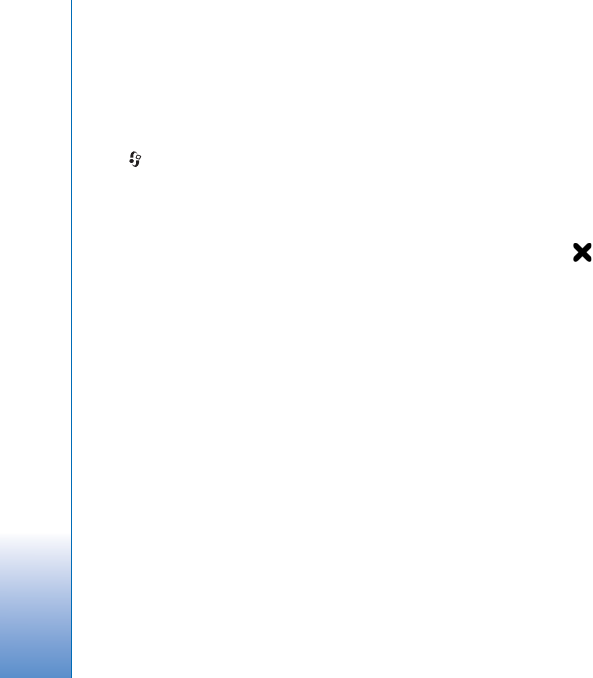
Connectivity
82 Copyright © 2006 Nokia. All rights reserved.
Offline profile, it will be deactivated. To use Bluetooth
connectivity in the Offline profile, you must reactivate it.
Settings
Press , and select Connect. > Bluetooth. When you
open the application for the first time, you are asked to
define a name for your device. After you set Bluetooth
connectivity on and change My phone's visibility to
Shown to all, your device and this name can be seen by
other users with devices using Bluetooth technology.
Select from the following:
Bluetooth—Select On or Off. To connect wirelessly to
another compatible device, first set Bluetooth
connectivity On, then establish a connection.
My phone's visibility—To allow your device to be found
by other devices with Bluetooth technology, select Shown
to all. To hide it from other devices, select Hidden.
My phone's name—Edit the name of your device.
Remote SIM mode—To enable another device, such as a
compatible car kit enhancement, to use the SIM card in
your device to connect to the network, select On.
Remote SIM mode
To use the remote SIM mode with a compatible car kit
enhancement, set Bluetooth connectivity on, and enable
the use of the remote SIM mode with your device. Before
the mode can be activated, the two devices must be paired
and the pairing initiated from the other device. When
pairing, use a 16-digit passcode, and set the other device
as authorized. See ‘Pair devices’, p. 83. Activate the remote
SIM mode from the other device.
When the remote SIM mode is on in your Nokia N92,
Remote SIM is displayed in the standby mode. The
connection to the wireless network is turned off, as
indicated by in the signal strength indicator area, and
you cannot use SIM card services or features requiring
cellular network coverage. However, a wireless LAN
connection remains active during the remote SIM mode.
When the wireless device is in the remote SIM mode, you
can only use a compatible connected enhancement, such
as a car kit, to make or receive calls. Your wireless device
will not make any calls, except to the emergency numbers
programmed into your device, while in this mode. To make
calls from your device, you must first leave the remote SIM
mode. If the device has been locked, enter the code to
unlock it first.
To leave the remote SIM mode, press the power key, and
select Exit rem. SIM mode.
Security tips
When you are not using Bluetooth connectivity, select
Bluetooth > Off or My phone's visibility > Hidden.

Connectivity
83
Copyright © 2006 Nokia. All rights reserved.
Do not pair with an unknown device.
Send data using Bluetooth connectivity
Several Bluetooth connections can be active at a time. For
example, if you are connected to a compatible headset,
you can also transfer files to another compatible device at
the same time.
Bluetooth connectivity indicators
• When is shown in the standby mode, Bluetooth
connectivity is on.
• When is blinking, your device is trying to connect
with another device.
• When is shown continuously, data is being
transmitted using Bluetooth connectivity.
Tip! To send text using Bluetooth connectivity, open
Notes, write the text, and select Options > Send > Via
Bluetooth.
1Open the application where the item you want to send
is stored. For example, to send an image to another
compatible device, open Gallery.
2Select the item and Options > Send > Via Bluetooth.
Devices with Bluetooth technology within range start
to appear on the display.
Device icons are computer, phone, audio or
video device, and other device.
To interrupt the search, select Stop.
3Select the device with which you want to connect.
4If the other device requires pairing before data can be
transmitted, a tone sounds, and you are asked to enter
a passcode. See ‘Pair devices’, p. 83.
5When the connection has been established, Sending
data is shown.
The Sent folder in Messag. does not store messages sent
using Bluetooth connectivity.
Tip! When searching for devices, some devices may
show only the unique address (device address). To find
the unique address of your device, enter the code
*#2820# in the standby mode.
Pair devices
To open the paired devices view ( ), in the Bluetooth
application main view, press .
During pairing, a passcode is needed. Before pairing, agree
with the owner of the other device on the passcode (1-16
digits), and use the same code on both devices. Devices
that do not have a user interface have a factory-set
passcode. The passcode is used only once.
To pair with a device, select Options > New paired
device. Devices with wireless Bluetooth technology within
range start to appear on the display. Select the device, and
enter the passcode. The same passcode must be entered
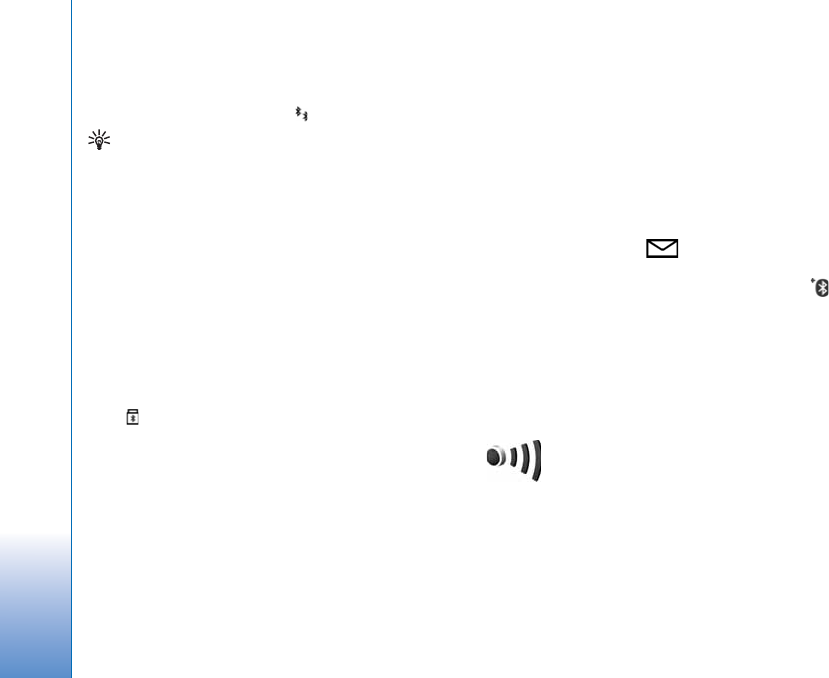
Connectivity
84 Copyright © 2006 Nokia. All rights reserved.
on the other device as well. After pairing, the device is
saved to the paired devices view.
Paired devices are indicated by in the device search.
Tip! To define a short name (nickname or alias) for a
paired device, scroll to the device, and select
Options > Assign short name in the paired devices
view. This name helps you to recognize a certain device
during device search or when a device requests a
connection.
To set a device as authorized or unauthorized, scroll to a
device, and select from the following options:
Set as authorised—Connections between your device and
this device can be made without your knowledge. No
separate acceptance or authorization is needed. Use this
status for your own devices, such as your compatible
headset or PC, or devices that belong to someone you
trust. indicates authorized devices in the paired
devices view.
Set as unauthorised—Connection requests from this
device must be accepted separately every time.
To cancel a pairing, scroll to the device, and select
Options > Delete. To cancel all pairings, select Options >
Delete all.
If you are currently connected to a device and delete the
pairing with that device, pairing is removed immediately,
and the connection is switched off.
Receive data using Bluetooth
connectivity
When you receive data through Bluetooth connectivity, a
tone sounds, and you are asked if you want to accept the
message. If you accept, is shown, and the item is
placed in the Inbox folder in Messag.. Messages received
through Bluetooth connectivity are indicated by . See
‘Inbox—receive messages’, p. 46.
Switch off Bluetooth connectivity
To switch off Bluetooth connectivity, select Bluetooth >
Off.
Infrared connection
With infrared, you can transfer data such as business
cards, calendar notes, and media files with a compatible
device.
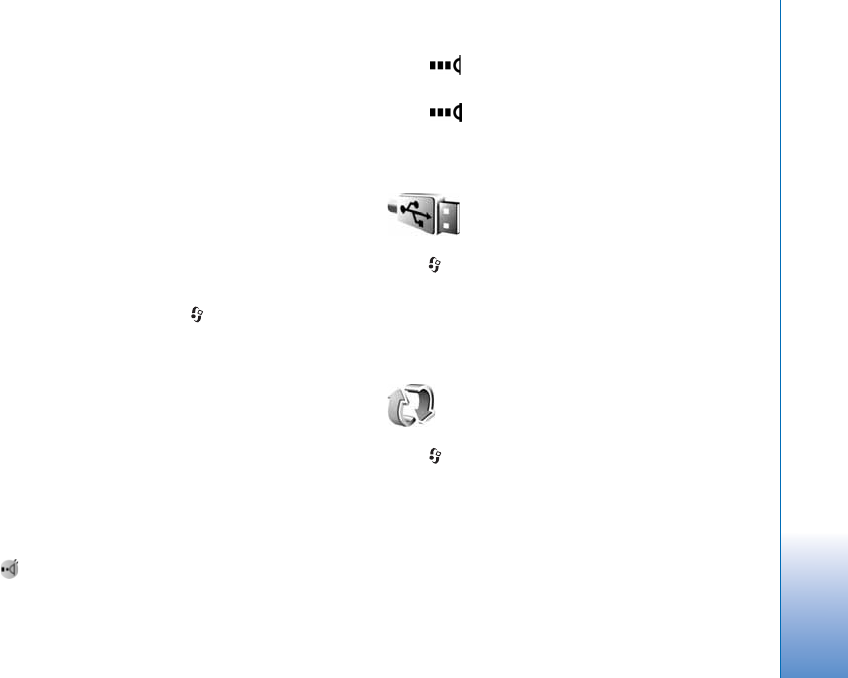
Connectivity
85
Copyright © 2006 Nokia. All rights reserved.
Do not point the infrared (IR) beam at anyone's eye or
allow it to interfere with other IR devices. This device is a
Class 1 laser product.
Send and receive data using infrared
1Ensure that the infrared ports of the sending and
receiving devices are pointing at each other, and that
there are no obstructions between the devices. The
preferable distance between the two devices is up to 1
meter (3 feet).
2The user of the receiving device activates the infrared
port.
To activate the infrared port of your device to receive
data through infrared, press , and select Connect. >
Infrared.
3The user of the sending device selects the desired
infrared function to start the data transfer.
To send data through infrared, locate the desired file in
an application or the file manager, and select
Options > Send > Via infrared.
If data transfer is not started within 1 minute after the
activation of the infrared port, the connection is canceled
and must be started again.
All items received through infrared are placed in the Inbox
folder in Messaging. New infrared messages are indicated
by .
When blinks, the devices are trying to connect, or a
connection has been lost.
When is shown continuously, the infrared
connection is active, and your device is ready to send and
receive data using its infrared port.
Data cable
Press , and select Connect. > Data cbl.. In Data cable
mode, select what the USB data cable connection is used
for: PC Suite, Data transfer, or PictBridge printer. To
have the device ask the purpose of the connection each
time the cable is connected, select Ask on connection.
Synchronization
Press , and select Connect. > Sync. Sync enables you
to synchronize your contact, calendar, or notes with
various compatible calendar and address book
applications on a compatible PC or on the Internet. You
can also create or edit synchronization settings.
The synchronization application uses SyncML technology
for synchronization. For information on SyncML

Connectivity
86 Copyright © 2006 Nokia. All rights reserved.
compatibility, contact the supplier of the application with
which you want to synchronize your device data.
You may receive synchronization settings in a special text
message. See ‘Data and settings’, p. 47.
Synchronize data
In the Sync main view, you can see the different
synchronization profiles.
1Select a synchronization profile and Options >
Synchronise. The status of the synchronization is
shown on the display.
To cancel synchronization before it finishes, select
Cancel.
2You are notified when the synchronization is
complete. Select Yes to view the log file showing the
synchronization status and how many entries have
been added, updated, deleted, or discarded (not
synchronized) in your device or on the server.
Create a new synchronization profile
To create a new profile in addition to existing ones, select
Options > New sync profile. Choose whether you want to
use the default setting values or copy the values from an
existing profile.
Define the following:
Sync profile name—Enter a name for the profile.
Applications—Select the applications to synchronize with
this profile, for example, Contacts and Calendar. Scroll to
each application, and press the scroll key to define its
synchronization settings:
•Include in sync—Select Yes if you want to synchronize
the application.
•Remote database—Enter a correct path to the remote
calendar, address book, or database on the server.
•Synchronisation type—Select Normal (two-way
synchronization), To server only, or To phone only.
Connection settings—Define the following. Contact your
service provider or system administrator for the correct
values.
•Server version—Select the synchronization protocol
version to use with the server.
•Server ID—Enter the server ID (shown only if Server
version is set to 1.2).
•Data bearer—Select the connection type: Internet or
Bluetooth.
•Access point (shown only if Data bearer is set to
Internet)—Select an access point to use for the data
connection.
•Host address—Enter the IP address of the remote
database server.
•Port—Enter the server port number (shown only if Data
bearer is set to Internet).

Connectivity
87
Copyright © 2006 Nokia. All rights reserved.
•User name—Enter your user ID for the synchronization
server.
•Password—Enter your password for the
synchronization server.
•Allow sync requests—Select Yes if you want to allow
the server to start a synchronization.
•Accept all sync reqs.—Select No if you want your
device to ask you before the server starts a
synchronization.
•Network authentic. (shown only if Data bearer is set
to Internet)—Select Yes to enter a network user name
and password. Scroll down to view the user name and
password fields.
Select Back to save the settings and return to the main
view.
Wireless LAN
Your device supports wireless local area network (wireless
LAN). With wireless LAN, you can connect your device to
the Internet and compatible devices that have wireless
LAN. For information about using your device in a home
network, see ‘Home network’, p. 90.
Some places, like France, have restrictions on the use of
wireless LAN. Check with your local authorities for more
information.
Features using wireless LAN, or allowing such features to
run in the background while using other features, increase
the demand on battery power and reduce the battery life.
Your device supports the following wireless LAN features:
• IEEE 802.11b/g standard
• Operation at a frequency of 2.4 GHz
• Wired equivalent privacy (WEP) with keys up to 128
bits, Wi-Fi protected access (WPA), and 802.1x
encryption methods. These functions can be used only
if they are supported by the network.
You can create an Internet access point (IAP) in a wireless
LAN, and use it for applications that need to connect to
the Internet.
Important: Always enable one of the available
encryption methods to increase the security of your
wireless LAN connection. Using encryption reduces the
risk of unauthorized access to your data.
Create an Internet access point
1Press , and select Connect. > Conn. mgr. >
Availab. WLAN.
2The device searches for wireless LANs within range.
Scroll to the network in which you want to create an
Internet access point, and select Options >Define
access point.
3The device creates an Internet access point with
default settings. To view or change these settings, see
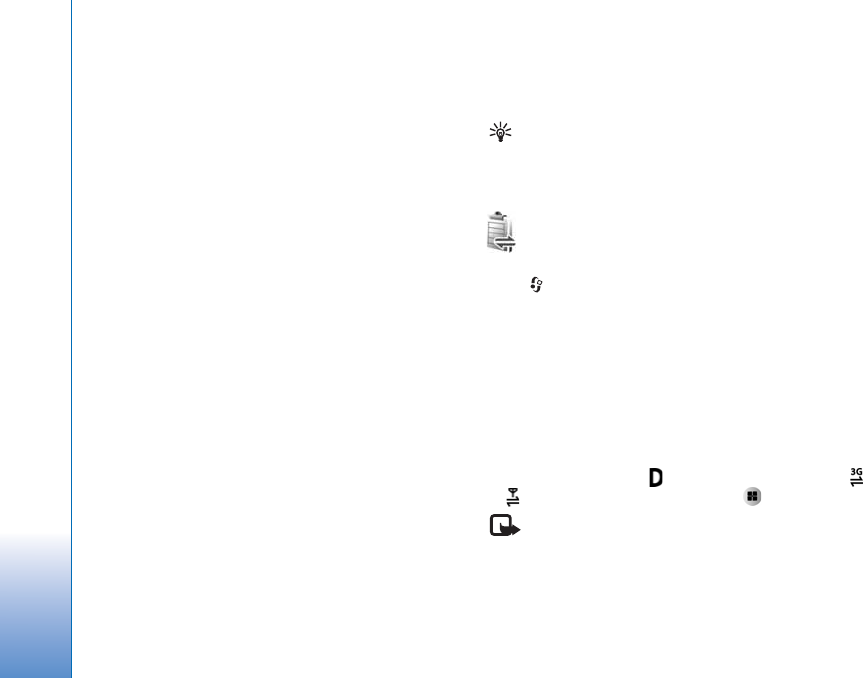
Connectivity
88 Copyright © 2006 Nokia. All rights reserved.
‘Access points’, p. 108. If you have selected a secured
WLAN network, you must define the access point
yourself in the connection setrtings.
When an application asks you to select an access point,
select the created access point.
A wireless LAN connection is established when you create
a data connection using a wireless LAN Internet access
point. The active wireless LAN connection ends when you
end the data connection. To end the connection, see
‘Connection manager’, p. 88.
You can use wireless LAN during a voice call or when
packet data is active. You can only be connected to one
wireless LAN access point device at a time, but several
applications can use the same wireless LAN connection.
When you activate the Offline profile, you can still use
wireless LAN (if available). Remember to comply with any
applicable safety requirements when establishing and
using a wireless LAN connection.
There are two operating modes in wireless LAN:
infrastructure and ad hoc.
The infrastructure operating mode allows two kinds of
communication: wireless devices are connected to each
other through a wireless LAN access point device, or
wireless devices are connected to a wired LAN through a
wireless LAN access point device.
In the ad hoc operating mode, devices can send and receive
data directly with each other. To create an Internet access
point for the ad hoc network, see ‘Access points’, p. 108.
Tip! To check the unique media access control (MAC)
address that identifies your device, enter
*#62209526# in the standby mode.
Connection manager
Press , and select Connect. > Conn. mgr.. To view the
status of data connections or end connections in GSM and
UMTS network and wireless LAN, select Act. data conn..
To search for wireless LANs available within range, select
Availab. WLAN. To refresh the list of available networks,
select Options > Reload.
Data connections
In the active connections view, you can see the open data
connections: data calls ( ), packet data connections (
or ), and wireless LAN connections ( ).
Note: The actual time invoiced for calls by your
service provider may vary, depending on network
features, rounding off for billing, and so forth.

Connectivity
89
Copyright © 2006 Nokia. All rights reserved.
To end a connection, select Options > Disconnect. To close
all open connections, select Options > Disconnect all.
To view the details of a connection, select Options >
Details. The details shown depend on the connection type.
Wireless LAN
The available wireless LAN view shows a list of wireless
LANs within range, their network mode (Infrastructure or
Ad-hoc), and signal strength indicator. is shown for
networks with encryption, and if your device has an
active connection in the network.
To view the details of a network, select Options > Details.
To create an Internet access point in a network, select
Options > Define access point.
Device manager
Press , and select Connect. > Dev. mgr.. You may
receive server profiles and different configuration settings
from your network operator, service provider, or company
information management department. These configuration
settings may include access point settings for data
connections and other settings used by different
applications in your device.
To connect to a server and receive configuration settings
for your device, scroll to a profile, and select Options >
Start configuration.
To create a new server profile, select Options > New
server profile. To edit a server profile, select Options >
Edit profile.
Server profile settings
Contact your service provider for the correct settings.
Server name—Enter a name for the configuration server.
Server ID—Enter the unique ID to identify the
configuration server.
Server password—Enter a password to identify your
device to the server.
Access point—Select an access point to be used when
connecting to the server.
Host address—Enter the URL address of the server.
Port—Enter the port number of the server.
User name and Password—Enter your user name and
password.
Allow configuration—To receive configuration settings
from the server, select Yes.

Connectivity
90 Copyright © 2006 Nokia. All rights reserved.
Auto-accept all reqs.—If you want your device to ask for
confirmation before accepting a configuration from the
server, select No.
Network authentic.—Select whether network
authentication is used.
Home network
Your device is compatible with Universal Plug and Play
architecture (UPnP). Using a wireless LAN access point
device or a wireless LAN router, you can create a home
network and connect compatible UPnP devices that
support wireless LAN to the network, such as your Nokia
N92, a compatible PC, a compatible printer, and a
compatible sound system or TV, or a sound system or TV
equipped with a compatible wireless multimedia receiver.
Using the wireless LAN function of the Nokia N92 in a
home network requires a working wireless LAN home
connection setup and the other target home devices to be
UPnP enabled and to be connected to the same home
network.
The home network uses the security settings of the
wireless LAN connection. Use the home network feature
in a wireless LAN infrastructure network with a wireless
LAN access point device and encryption enabled.
You can share media files saved in Gallery with other
compatible UPnP devices using the home network. To
manage your Home network settings, press , and
select Connect. > Home network. You can also use the
home network to view, play, copy, or print compatible
media files from Gallery. See ‘View and share media files’,
p. 92.
Copyright protections may prevent some images, music
(including ringing tones), and other content from being
copied, modified, transferred or forwarded.
Important: Always enable one of the available
encryption methods to increase the security of your
wireless LAN connection. Using encryption reduces the risk
of unauthorized access to your data.
Your device is connected to the home network only if you
accept a connection request from another compatible
device, or in Gallery, select the option to view, play, print,
or copy media files on your Nokia N92 or search for other
devices in the Home network folder.
Important security information
When you configure your wireless LAN home network,
enable an encryption method, first on your access point
device, then on the other devices you intend to connect to
your home network. Refer to the documentation of the

Connectivity
91
Copyright © 2006 Nokia. All rights reserved.
devices. Keep any passcodes secret and in a safe place
separate from the devices.
To view or change the settings of the wireless LAN Internet
access point in your Nokia N92, see ‘Access points’, p. 108.
If you use the ad hoc operating mode to create a home
network with a compatible device, enable one of the
encryption methods in WLAN security mode when you
configure the Internet access point. This step reduces the
risk of an unwanted party joining the ad hoc network.
Your device notifies you if another device attempts to
connect to it and the home network. Do not accept
connection requests from an unknown device.
If you use wireless LAN in a network that does not have
encryption, switch off sharing Nokia N92 files with other
devices, or do not share any private media files. To change
sharing settings, see ‘Home network settings’, p. 91.
Home network settings
To share media files saved in Gallery with other compatible
UPnP devices through wireless LAN, you must first create
and configure your wireless LAN home Internet access
point, then configure the Home network application. See
‘Wireless LAN’, p. 87 and the wireless LAN settings in
‘Access points’, p. 108.
To connect a compatible PC to the home network, on the
PC, you must install the related software from the
CD-ROM supplied with your Nokia N92.
The options related to Home network are not available in
Gallery before the Home network settings have been
configured.
Configure settings
To configure the Home network application, select
Connect. > Home network > Settings and from the
following:
Home access point—Select Always ask if you want the
device to ask for the home access point every time you
connect to the home network, User defined to select your
home Internet access point that is used automatically
when you use Home network, or None. If your home
network does not have wireless LAN security settings
enabled, you get a security warning. You can continue,
and switch the wireless LAN security on later; or cancel
defining the access point, and first switch on the wireless
LAN security. See Wireless LAN in ‘Access points’, p. 108.
My device name— Enter a name for your device that is
shown to the other compatible devices in the home
network.
Set sharing on and define content
Select Connect. > Home network > Share content.

Connectivity
92 Copyright © 2006 Nokia. All rights reserved.
Content sharing—Allow or deny sharing media files with
compatible devices. Do not set Content sharing on before
you have configured all the other settings. If you set
Content sharing on, the other UPnP compatible devices in
the home network can view and copy your files you have
selected for sharing in the Images & video and Music
folders.
To select media files for sharing with other devices from
the Images & video and Music folders, or to view the
sharing status of Images & video or Music, select Share
content.
View and share media files
If Content sharing is on in your device, the other UPnP
compatible devices in the home network can view and
copy the media files you have selected to share in Share
content. If you do not want the other devices to access
your files, set Content sharing off. Even if Content
sharing is off in your device, you can still view and copy
the media files stored in another home network device if
it is allowed by the other device.
Show media files stored in your device
To select images, videos, and sound clips stored in your
device, and show them in another home network device,
such as a compatible TV, do the following:
1In Gallery, select an image, a video clip, or a sound clip.
2Select Options > Show via home net..
3Select a compatible device in which the media file is
shown. The images are shown both in the other home
network device and your device, and the video clips and
sound clips are played only in the other device.
Show media files stored in the other device
To select media files that are stored on another home
network device, and show them in your device (or in a
compatible TV, for example), do the following:
1In Gallery, select Home network. Your device starts the
search of other compatible devices. Device names start
to appear on the display.
2Select a device from the list.
3Select the type of media you want to view from the
other device. The available file types depend on the
features of the other device.
4Select the image, video clip, or music clip you want to
view, and select Options > Show via home net.
(images and video) or Play via home network (music).
5Select the device in which the file is shown.
To stop sharing the media file, select Options > Stop
showing.
To print images saved in Gallery through Home network
with a UPnP compatible printer, select the print option in

Connectivity
93
Copyright © 2006 Nokia. All rights reserved.
Gallery. See ‘Image print’, p. 32. Content sharing does not
have to be switched on.
To search files with different criteria, select Options >
Find. To sort the found files, select Options > Sort by.
Copy media files
To copy or transfer media files from your device to another
compatible device, such as a UPnP compatible PC, select a
file in Gallery, and Options > Organise > Copy to home
network or Move to home network. Content sharing
does not have to be switched on.
To copy or transfer files from the other device to your
device, select a file in the other device, and Options >
Copy to phone or Copy to memory card (the name of the
memory card if the memory card is available). Content
sharing does not have to be switched on.
PC connections
You can use your device with a variety of PC connectivity
and data communications applications. With Nokia PC
Suite you can, for example, transfer images between your
device and a compatible PC.
Always create the connection from the PC to synchronize
with your device.
Your device as a modem
You can use your device as a modem to send and receive
e-mail, or to connect to the Internet with a compatible PC
by using Bluetooth connectivity, infrared, or a USB data
cable (network service). Detailed installation instructions
can be found in the user guide for Nokia PC Suite.
Tip! When using Nokia PC Suite for the first time, to
connect your device to a compatible PC and to use
Nokia PC Suite, use the Get Connected wizard available
in Nokia PC Suite.
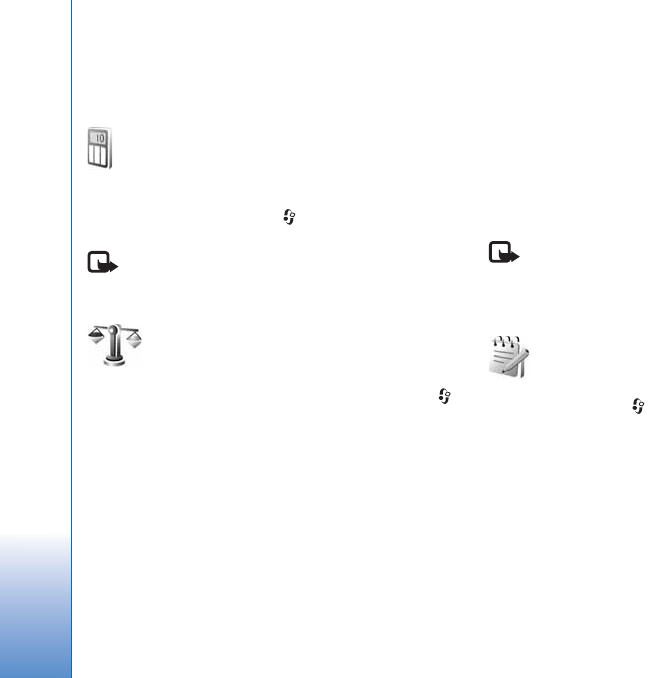
Office
94 Copyright © 2006 Nokia. All rights reserved.
Office
Calculator
To add, subtract, multiply, divide, and calculate square
roots and percentages, press , and select Office >
Calculator.
Note: This calculator has limited accuracy and is
designed for simple calculations.
Converter
To convert measures from one unit to another, press ,
and select Office > Converter.
Converter has limited accuracy, and rounding errors may
occur.
1In the Type field, select the measure you want to use.
2In first Unit field, select the unit from which you want
to convert. In the next Unit field, select the unit to
which you want to convert.
3In the first Amount field, enter the value you want to
convert. The other Amount field changes
automatically to show the converted value.
Set base currency and exchange rates
Select Type > Currency > Options > Currency rates.
Before you can make currency conversions, you must select
a base currency and add exchange rates. The rate of the
base currency is always 1.
Note: When you change base currency, you must
enter new exchange rates because all previously set
exchange rates are cleared.
Notes
To write notes, press , and select Office > Notes. You
can send notes to compatible devices, and save plain text
files (.txt format) that you receive to Notes.
To print a note on a compatible Basic Print Profile (BPP)
equipped printer with Bluetooth connectivity (such as HP
Deskjet 450 Mobile Printer or HP Photosmart 8150), select
Options > Print.
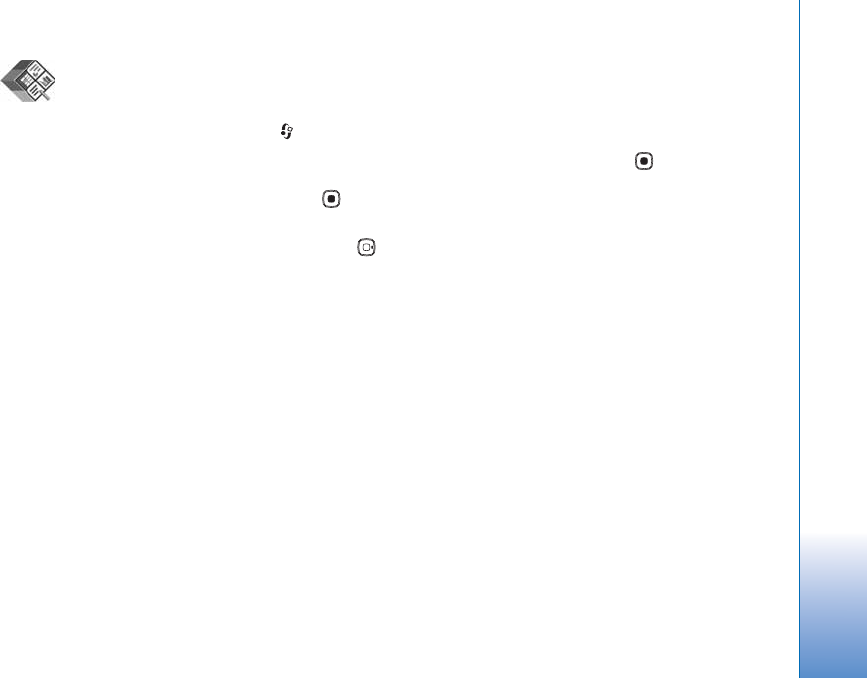
Office
95
Copyright © 2006 Nokia. All rights reserved.
Quickoffice
To use the Quickoffice applications, press , and select
Office > Quickoffice. A list of files in the .doc, .xls, .ppt,
and .txt file formats saved in the device opens.
To open a file in its respective application, press . To
sort files, select Options > Sort files.
To open Quickword, Quicksheet, or Quickpoint, press
to reach the desired view.
Quickword
With Quickword, you can view native Microsoft Word
documents on the display of your device. Quickword
supports colors, bold, italics, and underline.
Quickword supports the viewing of documents saved in
.doc format in Microsoft Word 97, 2000, and XP, and Palm
eBooks in .doc format. Not all variations or features of the
mentioned file formats are supported.
View Word documents
To move in the document, use the scroll key.
To search the document for text, select Options > Search.
You can also select Options and from the following:
Go to—to move to the start, end, or selected position
within the document
Zoom—to zoom in or out
Start Autoscroll—to start automatic scrolling through the
document. To stop scrolling, press .
Quicksheet
With Quicksheet, you can read Microsoft Excel files on
the display of your device.
Quicksheet supports the viewing of spreadsheet files
saved in .xls format in Microsoft Excel 97, 2000, 2003, and
XP. Not all variations or features of the mentioned file
formats are supported.
See also ‘More information’, p. 96.
View spreadsheets
To move around in the spreadsheet, use the scroll key.
To switch between worksheets, select Options > Pan.
To search the speadsheet for a text within a value or
formula, select Options > Find.
To change how the spreadsheet is displayed, select
Options and from the following:
Zoom—to zoom in or out

Office
96 Copyright © 2006 Nokia. All rights reserved.
Freeze panes—to keep the highlighted row, column, or
both visible while you move in the spreadsheet
Resize—to adjust the size of columns or rows
Quickpoint
With Quickpoint, you can view Microsoft PowerPoint
presentations on the display of your device.
Quickpoint supports the viewing of presentations created
in .ppt format in Microsoft PowerPoint 97, 2000, and XP.
Not all variations or features of the mentioned file
formats are supported.
View presentations
To move between the slide, outline, and the notes view,
press or .
To move to the next or previous slide in the presentation,
press or .
To view the presentation in full screen, select Options >
Full screen.
To expand items in the presentation outline in the outline
view, select Options > Outline > Expand entry.
More information
If you experience problems with Quickword, Quicksheet,
or Quickpoint, visit www.quickoffice.com for more
information. Support is also available by sending an e-mail
to supportS60@quickoffice.com.
Adobe Reader
With Adobe Reader you can read PDF documents on the
display of your device.
Note: This application has been optimised for PDF
document content on handsets and other mobile
devices, and provides only a limited set of features
compared with PC versions.
Note: This application is only available in a limited
number of languages.
Access and open documents in the following ways:
• Press , and select Office > Adobe PDF. Select
Options > Browse for file to browse and open
documents stored in the device memory and on the
memory card.
• Open an e-mail attachment from received e-mail
messages (network service).
• Send a document using Bluetooth connectivity to your
Inbox in Messag..
•Use File mgr. to browse and open documents stored in
the device memory and on the memory card.

Office
97
Copyright © 2006 Nokia. All rights reserved.
• Browse Web pages. Ensure your device is set up with an
Internet access point before browsing.
Manage PDF files
To browse and manage PDF files, press , and select
Office > Adobe PDF. Your recent files are listed in the file
view. To open a document, scroll to it, and press .
You can also select Options and from the following:
Browse for file—To browse for PDF files in the device
memory or on a memory card.
Settings—To modify default zoom level and viewing mode
of PDF documents.
View PDF files
When a PDF file is open, select Options and one of the
following:
Zoom—To zoom in, out, or to a selected percentage. You
can also resize the document to the screen width, or fit the
whole PDF page to the screen.
Find—To search the document for a text.
View—To view the document in a full screen mode. You can
also rotate the PDF document by 90 degrees in either
direction.
Go to—To move to a selected page, next page, previous
page, first page, or last page.
Save—To save the file to device memory or memory card.
Settings—To modify default zoom level and default
viewing mode.
Details—To display the properties of the PDF document.
More information
For more information, visit www.adobe.com.
To share questions, suggestions, and information about
the application, visit the Adobe Reader for Symbian OS
user forum at http://adobe.com/support/forums/
main.html.
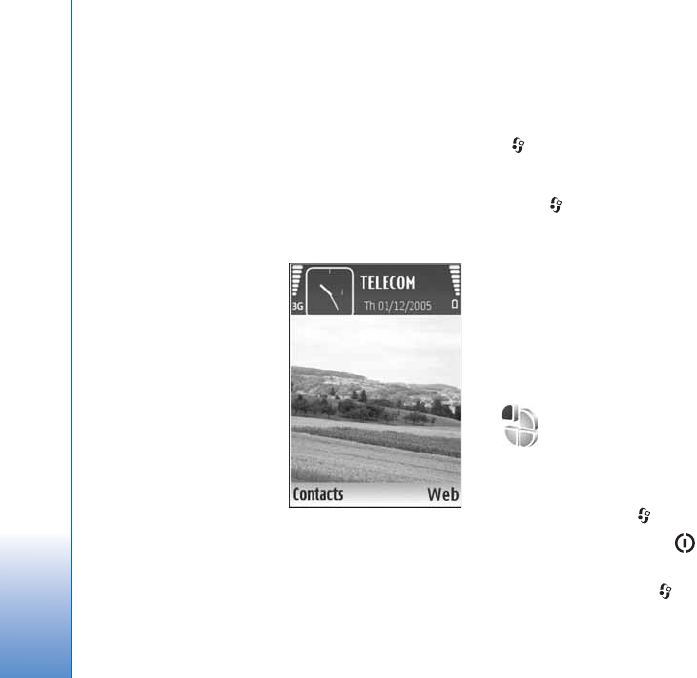
Personalize your device
98 Copyright © 2006 Nokia. All rights reserved.
Personalize your device
Your service provider may have requested that certain
features be disabled or not activated in your device. If so,
they will not appear on your device menu. Your device
may also have been specially configured. This
configuration may include changes in menu names, menu
order, and icons. Contact your service provider for more
information.
• To change the standby
mode background image
or what is shown in the
screen saver, see ‘Change
the look of your device’,
p. 99.
• To customize the ringing
tones, see ‘Profiles—set
tones’, p. 98 and ‘Add
ringing tones for
contacts’, p. 57.
• To change the shortcuts
assigned for the different
presses of the scroll key
and left and right selection keys in the standby mode,
see ‘Standby mode’, p. 106.
• To change the clock shown in the standby mode, press
, and select Clock > Options > Settings > Clock
type > Analogue or Digital.
• To change the welcome note to an image or animation,
press , and select Tools > Settings > Phone >
General > Welcome note / logo.
• To change the main menu view, in the main menu,
select Options > Change view > Grid or List.
• To rearrange the main menu, in the main menu, select
Options > Move, Move to folder, or New folder. You
can move less used applications into folders, and place
applications that you use more often into the main
menu.
Profiles—set tones
To set and customize the ringing tones, message alert
tones, and other tones for different events, environments,
or caller groups, press , and select Tools > Profiles.
To change the profile, press in the standby mode.
Scroll to the profile you want to activate, and select OK.
To modify a profile, press , and select Tools > Profiles.
Scroll to the profile, and select Options > Personalise.

Personalize your device
99
Copyright © 2006 Nokia. All rights reserved.
Scroll to the setting you want to change, and press to
open the choices. Tones stored on the memory card are
indicated with . You can scroll through the tone list
and listen to each one before you make your selection. To
stop the sound, press any key.
When you choose a tone, Tone downloads (network
service) opens a list of bookmarks. You can select a
bookmark and connect to a Web page to download tones.
If you want the caller’s name to be said when your device
rings, select Options > Personalise, and set Say caller's
name to On. The caller’s name must be saved in Contacts.
To create a new profile, select Options > Create new.
Offline profile
The Offline profile lets you use the device without
connecting to the wireless network. When you activate the
Offline profile, the connection to the wireless network is
turned off, as indicated by in the signal strength
indicator area. All wireless RF signals to and from the
device are prevented. If you try to send messages, they are
placed in the outbox to be sent later.
Warning: In the offline profile you cannot make (or
receive) any calls, except make calls to certain
emergency numbers, or use other features that require
network coverage. To make calls, you must first activate
the phone function by changing profiles. If the device
has been locked, enter the lock code.
When you have activated the Offline profile, you can still
use the wireless LAN (if available), for example, to read
your e-mail or browse the Internet. Remember to comply
with any applicable safety requirements when
establishing and using a wireless LAN connection. See
‘Wireless LAN’, p. 87.
To leave the Offline profile, press the power key, and
select another profile. The device re-enables wireless
transmissions (providing there is sufficient signal
strength). If Bluetooth connectivity is activated before
entering the Offline profile, it will be deactivated. To use
Bluetooth connectivity in the Offline profile, reactivate it.
Bluetooth connectivity is automatically reactivated after
leaving the Offline profile. See ‘Settings’, p. 82.
Change the look of your
device
To change the look of the display, such as the wallpaper
and icons, press , and select Tools > Themes. The active
theme is indicated by . In Themes you can group
together elements from other themes or select images
from the Gallery to personalize themes further. The
themes on the memory card (if inserted) are indicated by
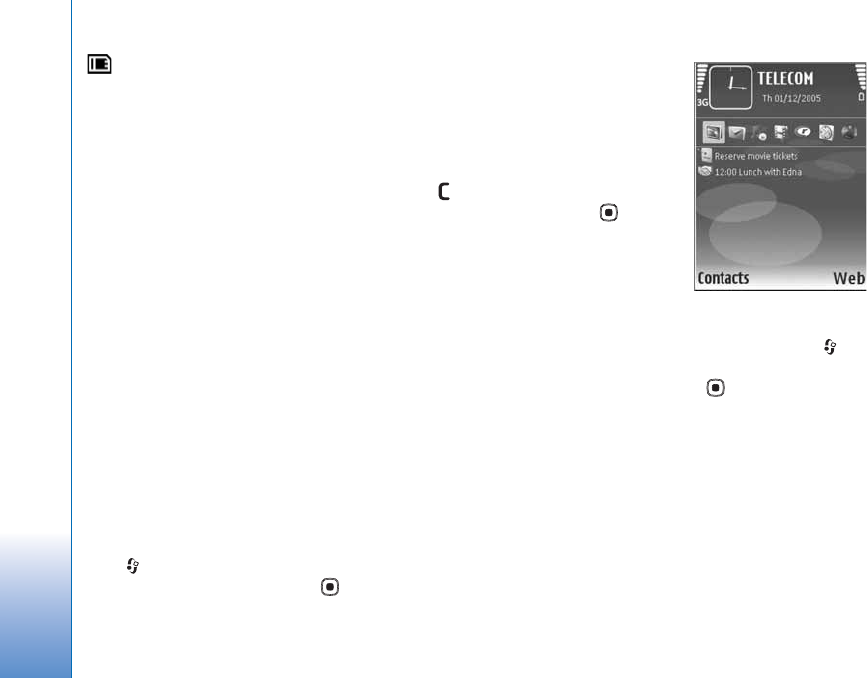
Personalize your device
100 Copyright © 2006 Nokia. All rights reserved.
. The themes on the memory card are not available if
the memory card is not inserted in the device. If you want
to use the themes saved in the memory card without the
memory card, save the themes in the device memory first.
To open a browser connection and download more
themes, select Theme downloads. To delete a theme that
you have downloaded, scroll to the theme, and press .
You cannot delete pre-installed themes or the theme
currently in use.
To activate a theme, scroll to it, and select Options >
Apply. To preview a theme before activating it, select
Options > Preview.
To edit themes, scroll to a theme, and select Options >
Edit to change the Wallpaper and Power saver settings.
To restore the selected theme to its original settings,
select Options > Restore orig. theme when you edit a
theme.
Active standby mode
Use your standby display for fast access to your most
frequently used applications. By default, the active
standby mode is on.
Press , select Tools > Settings > Phone > Standby
mode > Active standby, and press to switch the
active standby on or off.
The active standby display is
shown with default
applications across the top of
the screen, and calendar,
to-do, and player events
listed below.
Scroll to an application or
event, and press .
The standard scroll key
shortcuts available in the
standby mode cannot be used
when the active standby
mode is on.
To change the default application shortcuts, press ,
select Tools > Settings > Phone > Standby mode >
Active standby apps., and press .
Some shortcuts may be fixed, and you cannot change
them.
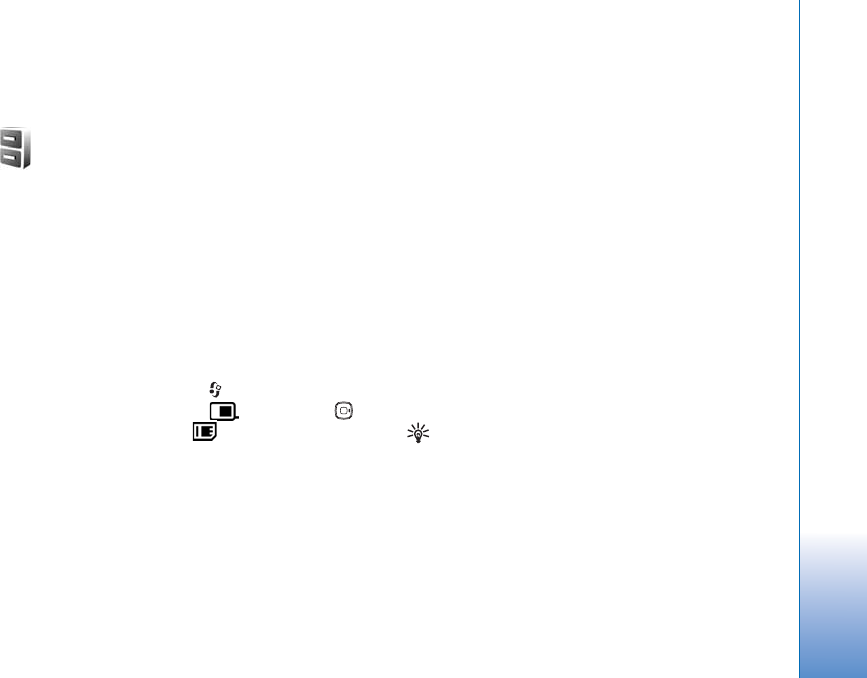
Tools
101
Copyright © 2006 Nokia. All rights reserved.
Tools
File manager
Many features of the device, such as contacts, messages,
images, videos, ringing tones, calendar notes, documents,
and downloaded applications, use memory to store data.
The free memory available depends on how much data is
already saved in the device memory.
You can use a compatible memory card as extra storage
space. Memory cards are rewritable, so you can delete old
information and save new data on a memory card.
To browse files and folders in the device memory or on a
memory card (if inserted), press , and select Tools > File
mgr.. The device memory view ( ) opens. Press to
open the memory card view ( ), if available.
To move or copy the selected file to a folder, select
Options > Move to folder or Copy to folder.
To find a file, select Options > Find and the memory from
which to search, and enter a search text that matches the
file name.
View memory consumption
To view what types of data you have in the device and how
much memory the different data types consume, select
Options > Memory details. The amount of available free
memory is shown in Free memory.
Memory low—free memory
The device notifies you if the device or the memory card
memory is low.
To free device memory, transfer data to a compatible
memory card, if you have one. Mark files to be moved, and
select Options> Move to folder > Memory card and a
folder.
Tip! Use Nokia Phone Browser available in Nokia PC
Suite, supplied with your device, to view the different
memories in your device and transfer data.
To remove data to free memory, use File mgr. or the
respective application. For example, you can remove the
following:
• Messages from the Inbox, Drafts, and Sent folders in
Messag.
• Retrieved e-mail messages from the device memory
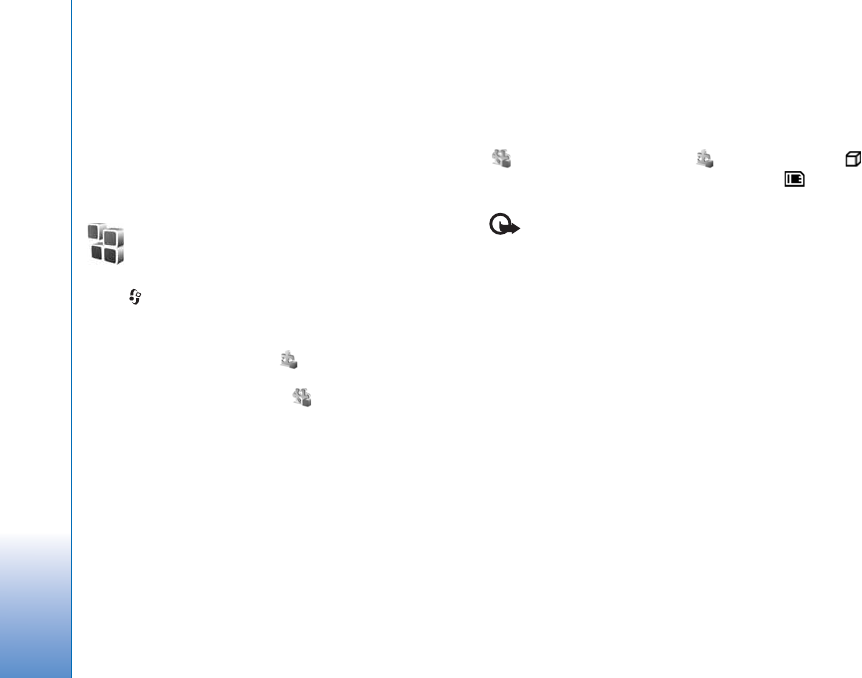
Tools
102 Copyright © 2006 Nokia. All rights reserved.
• Saved Web pages
• Saved images, videos, or sound files
• Contact information
•Calendar notes
• Downloaded applications. See also ‘Application
manager’, p. 102.
• Any other data that you no longer need
Application manager
Press , and select Tools > App. mgr.. You can install
two types of applications and software to your device:
•J2ME
TM applications based on Java technology with
the extension .jad or .jar ( ).
• Other applications and software suitable for the
Symbian operating system ( ). The installation files
have the .sis extension. Only install software
specifically designed for your Nokia N92. Software
providers will often refer to the official model number
of this product: the Nokia N92-1.
Installation files may be transferred to your device from a
compatible computer, downloaded during browsing, or
sent to you in a multimedia message, as an e-mail
attachment, or using Bluetooth connectivity or infrared.
You can use Nokia Application Installer in Nokia PC Suite
to install an application to your device. If you use
Microsoft Windows Explorer to transfer a file, save the file
to a compatible memory card (local disk).
Install applications and software
indicates a .sis application, a Java application,
that the application is not fully installed, and that the
application is installed on the memory card.
Important: Only install and use applications and
other software from sources that offer adequate security
and protection against harmful software.
Before installation, note the following:
• To view the application type, version number, and the
supplier or manufacturer of the application, select
Options > View details.
• To display the security certificate details of the
application, select Options > View certificate. See
‘Certificate management’, p. 113.
• If you install a file that contains an update or repair to
an existing application, you can only restore the
original application if you have the original installation
file or a full back-up copy of the removed software
package. To restore the original application, remove the
application, and install the application again from the
original installation file or the back-up copy.
• The .jar file is required for installing Java applications.
If it is missing, the device may ask you to download it.
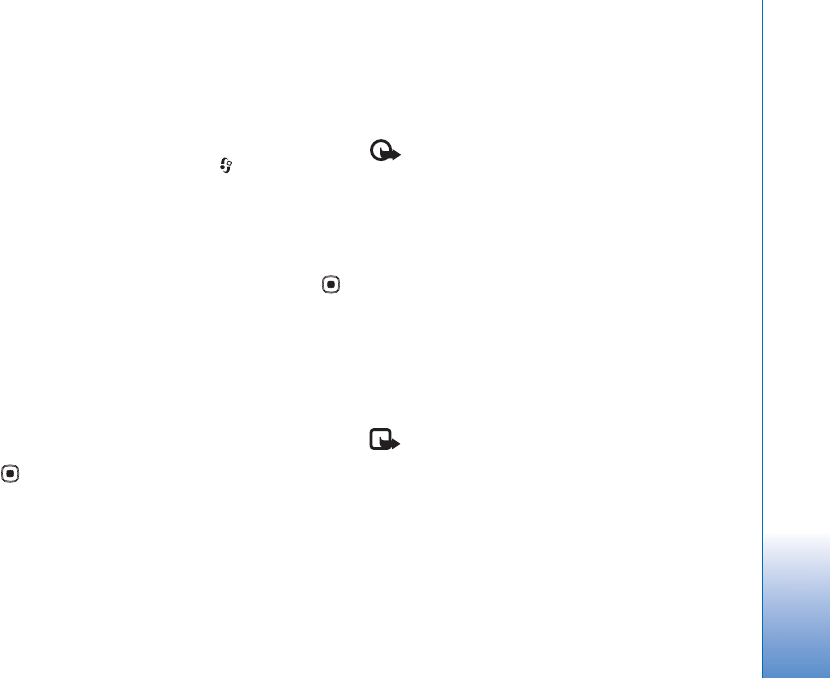
Tools
103
Copyright © 2006 Nokia. All rights reserved.
If there is no access point defined for the application,
you are asked to select one. When you are downloading
the .jar file, you may need to enter a user name and
password to access the server. You obtain these from
the supplier or manufacturer of the application.
1To locate an installation file, press , and select
Tools > App. mgr.. Alternatively, search the device
memory or a compatible memory card (if inserted) in
File mgr., or open a message in Messag. > Inbox that
contains an installation file.
2In App. mgr., select Options > Install. In other
applications, scroll to the installation file, and press
to start the installation.
During installation, the device shows information
about the progress of the installation. If you are
installing an application without a digital signature or
certification, the device displays a warning. Continue
installation only if you are sure of the origin and
contents of the application.
To start an installed application, locate it in the menu, and
press .
To start a network connection and to view extra
information about the application, select Options > Go to
web address, if available.
To see what software packages are installed or removed
and when, select Options > View log.
To send your installation log to a help desk so that they
can see what is installed or removed, select Options >
Send log > Via text message or Via e-mail (available
only if the correct e-mail settings are in place).
Important: Your device can only support one
antivirus application. Having more than one application
with antivirus functionality could affect performance and
operation or cause the device to stop functioning.
Remove applications and software
Scroll to a software package, and select Options >
Remove. Select Yes to confirm.
If you remove software, you can only reinstall it if you
have the original software package or a full backup of the
removed software package. If you remove a software
package, you may no longer be able to open documents
created with that software.
Note: If another software package depends on the
software package that you removed, the other
software package may stop working. Refer to the
documentation of the installed software package for
details.
Settings
Select Options > Settings and from the following:

Tools
104 Copyright © 2006 Nokia. All rights reserved.
Software installation—Select Signed only to only install
applications with verified digital signatures.
Online certif. check—Select to check the online
certificates before installing an application.
Default web address—Set the default address used when
checking online certificates.
Some Java applications may require a phone call, a
message to be sent, or a network connection to a specific
access point for downloading extra data or components.
In the App. mgr. main view, scroll to an application, and
select Options > Suite settings to change settings
related to that specific application.
Settings wizard
Settings wizard configures your device for operator
(MMS, GPRS, mobile Internet, and streaming), e-mail, and
push to talk (network service) settings based on your
network operator information.
To use these services, you may have to contact your
network operator or service provider to activate a data
connection or other services.
Press , and select Tools > Sett. wizard.
Select the item from the menu that you want to configure
your device for, and press .
E-mail
1When you choose to configure your e-mail settings,
Settings wizard detects your available network
operator, and asks you to confirm it. Select OK, or scroll
to another network operator, and select OK.
2Select your e-mail service provider from the list.
3Select the outgoing mail server. Use the default server
if you are not sure.
4Settings wizard prompts you to enter the details of
your e-mail address, user name, and password. Select
each in turn, and select Options > Change. Enter the
details, and select OK.
5Select Options > OK when you are finished.
6Select OK to confirm that you want to set up the
mailbox for the specified operator.
7Select OK.
Push to talk
This option is available only if you have the application
installed in your device, and you have subscribed to the
service.
1When you choose to configure your push-to-talk
(network service) settings, Settings wizard detects

Tools
105
Copyright © 2006 Nokia. All rights reserved.
your available network operator, and asks you to
confirm it. Select OK, or scroll to another network
operator, and select OK.
2Some operators require a user name, password, and
nickname. Select each in turn, and select Options >
Change. Enter the details, and select OK.
3Select Options > OK when you are finished.
4Select OK to confirm that you want to set up Push to
talk for the specified operator.
Operator
1When you choose to configure your operator settings,
Settings wizard detects your available network
operator and asks you to confirm it. Select OK, or scroll
to another network operator, and select OK.
2Select OK to confirm that you want to set up your
device for the specified operator.
More information
If you experience any problems with Settings wizard, visit
the Nokia phone settings Web site at
www.nokia.com/phonesettings.
Settings
To change settings, press , and select Tools > Settings.
To open a settings group, press . Scroll to a setting you
want to change, and press .
Some settings may be preset for the device by your
network operator or service provider, and you may not be
able to change them.
Phone
General
Phone language—Changing the language of the display
texts in your device also affects the format used for date
and time and the separators used, for example, in
calculations. Automatic selects the language according to
the information on your SIM card. After you change the
display text language, the device restarts.
Changing the settings for Phone language or Writing
language affects every application in your device, and the
change remains effective until you change these settings
again.
Writing language—Changing the language affects the
characters and special characters available when writing
text and the predictive text dictionary used.

Tools
106 Copyright © 2006 Nokia. All rights reserved.
Predictive text—Set the predictive text input On or Off
for all editors in the device. The predictive text dictionary
is not available for all languages.
Welcome note / logo—The welcome note or logo is
displayed briefly each time you switch on the device.
Select Default to use the default image, Text to write a
welcome note, or Image to select an image from Gallery.
Orig. phone settings—You can reset some of the settings
to their original values. To do this, you need the lock code.
See ‘Security’, ‘Phone and SIM’, p. 113. After resetting, the
device may take a longer time to power on. Documents
and files are unaffected.
Cover display
Personalisation:
Wallpaper—Select the background image displayed on
the cover display in the standby mode. If you select User
defined in the wallpaper settings, a cropping frame is
shown on top of the image you selected. The cropping
frame is the size of the cover display, and you can zoom,
rotate, and crop the area of the image. You cannot use a
copyright-protected image as wallpaper.
Closing animation—Select a short animation to play
when you close the cover.
Closing tone—Select a short tune to play when you close
the cover.
Opening tone—Select a short tune to play when you open
the cover and the device is in the standby mode.
Calls:
Answer if fold opened—Select Answer if fold opened >
Yes or No.
If fold closed—Select End call to end calls by closing the
cover, or Activate loudspeaker to activate the loudspeaker
when you close the cover.
Standby mode
Active standby—Use shortcuts to applications in the
standby mode. See ‘Active standby mode’, p. 100.
Left selection key—Assign a shortcut to the left selection
key ( ) in the standby mode.
Right selection key—Assign a shortcut to the right
selection key ( ) in the standby mode.
Active standby apps.—Select the application shortcuts
you want to appear in the active standby. This setting is
only available if Active standby is on.
You can also assign keypad shortcuts for the different
presses of the scroll key. The scroll key shortcuts are not
available if the active standby is on.
Operator logo—This setting is only available if you have
received and saved an operator logo. Select Off if you do
not want the logo to be shown.

Tools
107
Copyright © 2006 Nokia. All rights reserved.
Display
Brightness—Adjust the basic brightness level of the display
to lighter or darker. However, in extreme light conditions,
the brightness of the display is automatically adjusted.
Power saver time-out—Select the time-out period after
which the power saver is activated.
Light time-out—Select a time-out after which the
backlight of the display is switched off.
Call
Send my caller ID—You can set your phone number to be
displayed to (Yes) or hidden from (No) the person to whom
you are calling, or the value may be set by your network
operator or service provider when you make a subscription
(Set by network) (network service).
Call waiting—If you have activated call waiting (network
service), the network notifies you of a new incoming call
while you have a call in progress. Set the function on
(Activate) or off (Cancel), or check whether the function
is activated (Check status).
Reject call with SMS—Select Yes to send a text message
to a caller informing why you could not answer the call.
See ‘Answer or decline a call’, p. 61.
Message text—Write a text to be sent in a text message
when you reject a call.
Image in video call—If video is not sent during a video
call, you can select a still image to be displayed instead.
Automatic redial—Select On, and your device makes a
maximum of 10 attempts to connect the call after an
unsuccessful call attempt. To stop automatic redialing,
press .
Summary after call—Activate this setting if you want the
device to briefly display the approximate duration of the
last call.
Speed dialling—Select On, and the numbers assigned to
the speed dialing keys ( - ) can be dialed by
pressing and holding the key. See also ‘Speed dial a phone
number’, p. 59.
Anykey answer—Select On, and you can answer an
incoming call by briefly pressing any keypad key, except
, , , and .
Line in use—This setting (network service) is shown only
if the SIM card supports two subscriber numbers, that is,
two phone lines. Select which phone line you want to use
for making calls and sending text messages. Calls on both
lines can be answered irrespective of the selected line. If
you select Line 2 and have not subscribed to this network
service, you will not be able to make calls. When line 2 is
selected, is shown in the standby mode.
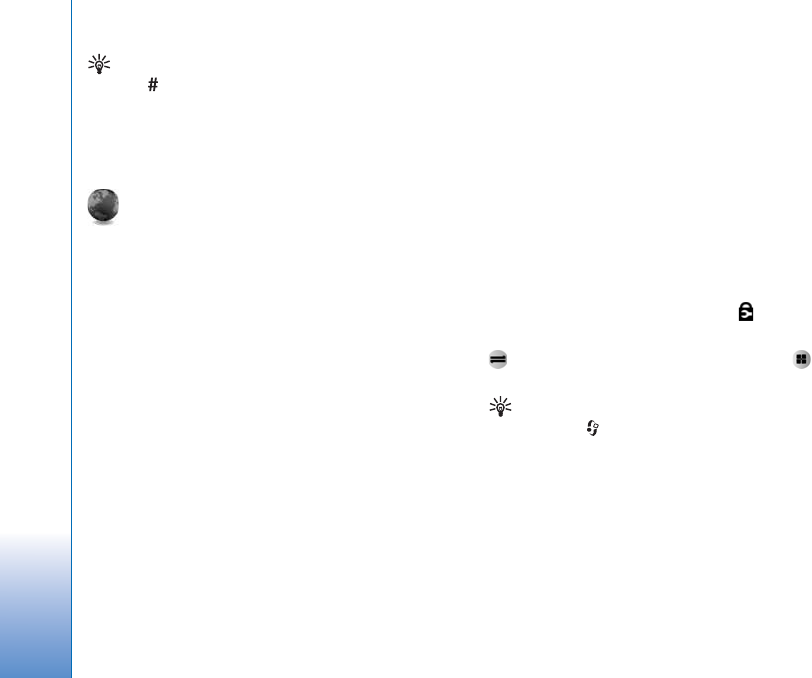
Tools
108 Copyright © 2006 Nokia. All rights reserved.
Tip! To switch between the phone lines, press and
hold in the standby mode.
Line change—To prevent line selection (network service),
select Disable if supported by your SIM card. To change
this setting, you need the PIN2 code.
Connection
Data connections and access points
Your device supports packet data connections (network
service), such as GPRS in the GSM network. When you use
your device in GSM and UMTS networks, multiple data
connections can be active at the same time, and access
points can share a data connection. In the UMTS network,
data connections remain active during voice calls.
You can also use a wireless LAN data connection. See
‘Wireless LAN’, p. 89. Only one connection in one wireless
LAN can be active at a time.
To establish a data connection, an access point is required.
You can define different kinds of access points, such as:
• MMS access point to send and receive multimedia
messages
• Access point for the Web application to view WML or
XHTML pages
• Internet access point (IAP) to send and receive e-mail
and connect to the Internet
Check the type of access point you need with your service
provider for the service you want to access. For availability
and subscription to packet data connection services,
contact your network operator or service provider.
Access points
You may receive access point settings in a message from a
service provider. See ‘Data and settings’, p. 47. Some or all
access points may be preset for your device by your service
provider or network operator, and you may not be able to
change, create, edit, or remove them. indicates a
protected access point.
indicates a packet data access point, and a
wireless LAN access point.
Tip! To create an Internet access point in a wireless
LAN, press , and select Connect. > Conn. mgr. >
Availab. WLAN > Options > Define access point.
To create a new access point, select Options > New access
point. Select Use default settings to use the default
access point settings, or Use existing settings to select an
existing access point as the basis for the new access point..
To edit the settings of an access point, select Options >
Edit. Follow the instructions from your service provider

Tools
109
Copyright © 2006 Nokia. All rights reserved.
Connection name—Enter a descriptive name for the
connection.
Data bearer—Select the data connection type.
Depending on the data connection you select, only certain
setting fields are available. Fill in all fields marked with
Must be defined or with a red asterisk. Other fields can be
left empty, unless you have been instructed otherwise by
your service provider.
To be able to use a data connection, the network service
provider must support this feature, and if necessary,
activate it for your SIM card.
Packet data
Follow the instructions from your service provider.
Access point name—You obtain the access point name
from your network operator or service provider.
User name—The user name may be needed to make a data
connection, and is usually provided by the service provider.
Prompt password—If you must enter the password every
time you log in to a server, or if you do not want to save
your password in the device, select Yes.
Password—A password may be needed to make a data
connection, and is usually provided by the service provider.
Authentication—Select Normal or Secure.
Homepage—Depending on the access point you are
setting up, enter the Web address or the address of the
multimedia messaging center.
Select Options > Advanced settings to change the
following settings:
Network type—Select the Internet protocol type to use:
IPv4 or IPv6. The other settings depend on the selected
network type.
Phone IP address (for IPv4 only)—Enter the IP address of
your device.
DNS address—In Primary DNS address, enter the IP
address of the primary DNS server. In Secondary DNS
addr., enter the IP address of the secondary DNS server.
Contact your Internet service provider to obtain these
addresses.
Proxy serv. address—Define the address for the proxy
server.
Proxy port number—Enter the proxy port number.
Wireless LAN
Follow the instructions from your service provider.
WLAN netw. name—Select Enter manually or Search for
netw.. If you select an existing network, WLAN netw.
mode and WLAN security mode are determined by the
settings of its access point device.

Tools
110 Copyright © 2006 Nokia. All rights reserved.
WLAN netw. mode—Select Ad-hoc to create an ad hoc
network and to allow devices to send and receive data
directly; a wireless LAN access point device is not needed.
WLAN security mode—Select the encryption used: WEP,
802.1x (not for ad hoc networks), or WPA/WPA2. If you
select Open network, no encryption is used. The WEP,
802.1x, and WPA functions can be used only if the
network supports them.
WLAN security sett.—Enter the settings for the selected
security mode:
Security settings for WEP:
Wep key in use—Select the WEP key number. You can
create up to four WEP keys. The same settings must be
entered on the wireless LAN access point device.
Authentication type—Select Open or Shared for the
authentication type between your device and the wireless
LAN access point device.
WEP key settings—Enter WEP encryption (length of the
key), WEP key format (ASCII or Hexadecimal), and WEP
key (the WEP key data in the selected format).
Security settings for 802.1x and WPA/WPA2:
WPA mode—Select the means of authentication: EAP to
use an extensible authentication protocol (EAP) plug-in,
or Pre-shared key to use a password. Complete the
appropriate settings:
EAP plug-in settings (only for EAP)—Enter the settings as
your service provider instructs.
Pre-shared key (only for Pre-shared key)—Enter a
password. The same password must be entered on the
wireless LAN access point device.
TKIP encryption—Select whether Temporal Key Integrity
Protocol (TKIP) is used.
Homepage—Define a home page.
Select Options > Advanced settings and from the
following:
IPv4 settings: Phone IP address (the IP address of your
device), Subnet mask (the subnet IP address), Default
gateway (the gateway), and DNS address—Enter the IP
addresses of the primary and secondary DNS server.
Contact your Internet service provider for these addresses.
IPv6 settings > DNS address—Select Automatic, Well-
known, or User defined.
Ad-hoc channel (only for Ad-hoc)—To enter a channel
number (1-11) manually, select User defined.
Proxy serv. address—Enter the address for the proxy
server.
Proxy port number—Enter the proxy port number.

Tools
111
Copyright © 2006 Nokia. All rights reserved.
Packet data
The packet data settings affect all access points using a
packet data connection.
Packet data conn.—If you select When available and you
are in a network that supports packet data, the device
registers to the packet data network. Starting an active
packet data connection (for example, to send and receive
e-mail) is quicker. If there is no packet data coverage, the
device periodically tries to establish a packet data
connection. If you select When needed, the device uses a
packet data connection only if you start an application or
action that needs it.
Access point—The access point name is needed to use your
device as a packet data modem to your computer.
SIP settings
SIP (Session Initiation Protocol) settings are needed for
certain network services using SIP. You may receive the
settings in a special text message from your network
operator or service provider. You can view, delete, or create
these setting profiles in SIP settings.
Data call
The data call settings affect all access points using a GSM
data call connection.
Online time—Set the data calls to disconnect
automatically after a time-out if there is no activity. To
enter a time-out, select User defined, and enter the time
in minutes. if you select Unlimited, data calls are not
disconnected automatically.
Wireless LAN
Show availability—Select whether is displayed when
a wireless LAN is available.
Scan for networks—If you set Show availability to Yes,
select how often the device searches for available wireless
LANs and updates the indicator.
To view advanced settings, select Options > Advanced
settings. Changing wireless LAN advanced settings is not
recommended.
Configurations
You may receive trusted server settings from your network
operator or service provider in a configuration message, or
the settings may be stored on your (U)SIM card. You can
save these settings to your device, view, or delete them in
Configurations.
Date and time
See ‘Clock settings’, p. 15 and language settings in
‘General’, p. 105.

Tools
112 Copyright © 2006 Nokia. All rights reserved.
Security
Phone and SIM
PIN code request—When active, the code is requested
each time the device is switched on. Deactivating the
personal identification number (PIN) code request may
not be allowed by some SIM cards. See ‘Glossary of PIN
and lock codes’, p. 112.
PIN code, PIN2 code, and Lock code—You can change the
lock code, PIN code, and PIN2 code. These codes can only
include the numbers from 0 to 9. If you forget any of
these codes, contact your service provider. See ‘Glossary
of PIN and lock codes’, p. 112.
Avoid using access codes similar to the emergency
numbers to prevent accidental dialing of the emergency
number.
Autolock period—You can set an autolock period, a
time-out after which the device automatically locks. To
turn off the autolock period, select None.
To unlock the device, enter the lock code.
When the device is locked, calls still may be possible to
the official emergency number programmed into your
device.
Tip! To lock the device manually, press . A list of
commands opens. Select Lock phone.
Lock if SIM changed—You can set the device to ask for
the lock code when an unknown SIM card is inserted into
your device. The device maintains a list of SIM cards that
are recognized as the owner’s cards.
Closed user group—You can specify a group of people to
whom you can call and who can call you (network service).
When calls are limited to closed user groups, calls may be
possible to the official emergency number programmed
into your device.
Confirm SIM services—You can set the device to display
confirmation messages when you are using a SIM card
service (network service).
Glossary of PIN and lock codes
If you forget any of these codes, contact your service
provider.
Personal identification number (PIN) code—This code
protects your SIM card against unauthorized use. The PIN
code (4 to 8 digits) is usually supplied with the SIM card.
After three consecutive incorrect PIN code entries, the
code is blocked, and you need the PUK code to unblock it.
UPIN code—This code may be supplied with the USIM card.
The USIM card is an enhanced version of the SIM card and
is supported by UMTS mobile phones.

Tools
113
Copyright © 2006 Nokia. All rights reserved.
PIN2 code—This code (4 to 8 digits) is supplied with some
SIM cards, and is required to access some functions in your
device.
Lock code (also known as security code)—This code (5
digits) can be used to lock the device to avoid unauthorized
use. The factory setting for the lock code is 12345. To
avoid unauthorized use of your device, change the lock
code. Keep the new code secret and in a safe place
separate from your device. If you forget the code, contact
your service provider.
Personal unblocking key (PUK) code and PUK2 code—These
codes (8 digits) are required to change a blocked PIN code
or PIN2 code, respectively. If the codes are not supplied
with the SIM card, contact the operator whose SIM card is
in your device.
UPUK code—This code (8 digits) is required to change a
blocked UPIN code. If the code is not supplied with the
USIM card, contact the operator whose USIM card is in
your device.
Certificate management
Digital certificates do not guarantee safety; they are used
to verify the origin of software.
In the certificate management main view, you can see a
list of authority certificates that are stored in your device.
Press to see a list of personal certificates, if available.
Digital certificates should be used if you want to connect
to an online bank or another site or remote server for
actions that involve transferring confidential information.
They should also be used if you want to reduce the risk of
viruses or other malicious software and be sure of the
authenticity of software when downloading and installing
software.
Important: Even if the use of certificates makes the
risks involved in remote connections and software
installation considerably smaller, they must be used
correctly in order to benefit from increased security. The
existence of a certificate does not offer any protection by
itself; the certificate manager must contain correct,
authentic, or trusted certificates for increased security to
be available. Certificates have a restricted lifetime. If
Expired certificate or Certificate not valid yet is shown
even if the certificate should be valid, check that the
current date and time in your device are correct.
View certificate details—check authenticity
You can only be sure of the correct identity of a server
when the signature and the period of validity of a server
certificate have been checked.
You are notified if the identity of the server is not
authentic or if you do not have the correct security
certificate in your device.
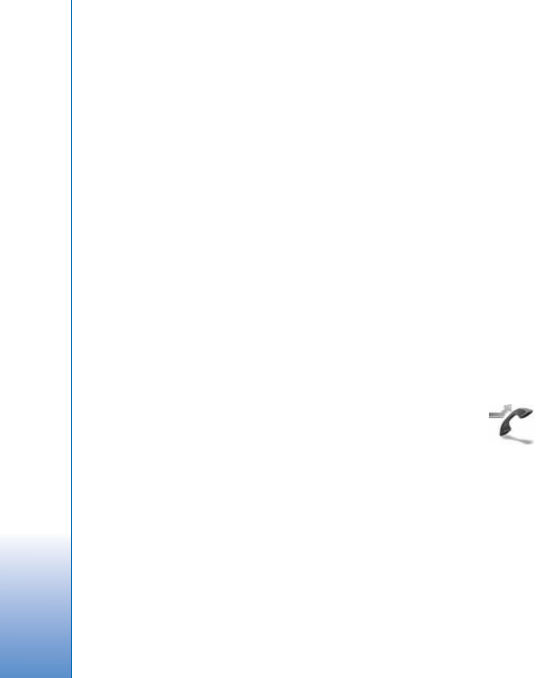
Tools
114 Copyright © 2006 Nokia. All rights reserved.
To check certificate details, scroll to a certificate, and
select Options > Certificate details. When you open
certificate details, the validity of the certificate is
checked, and one of the following notes may be displayed:
•Certificate not trusted—You have not set any
application to use the certificate. See ‘Change the
trust settings’, p. 114.
•Expired certificate—The period of validity has ended
for the selected certificate.
•Certificate not valid yet—The period of validity has
not yet begun for the selected certificate.
•Certificate corrupted—The certificate cannot be used.
Contact the certificate issuer.
Change the trust settings
Before changing any certificate settings, you must make
sure that you really trust the owner of the certificate and
that the certificate really belongs to the listed owner.
Scroll to an authority certificate, and select Options >
Trust settings. Depending on the certificate, a list of the
applications that can use the selected certificate is
shown. For example:
•Symbian installation: Yes—The certificate is able to
certify the origin of a new Symbian operating system
application.
•Internet: Yes—The certificate is able to certify servers.
•App. installation: Yes—The certificate is able to certify
the origin of a new Java application.
Select Options > Edit trust setting to change the value.
Track protected object
Some copyright-protected music files may include a
transaction identifier. Select whether you allow the
identifier to be sent with the music file if you send or
forward the file. The provider of the music file can use the
identifier to track the distribution of the files.
Security module
To view or edit a security module (if available) in Security
module, scroll to it, and press the scroll key. To view
detailed information about a security module, scroll to it,
and select Options > Security details.
Call divert
Call divert allows you to divert your incoming calls to your
voice mailbox or another phone number. For details,
contact your service provider.
Select which calls you want to divert and the desired
diverting option. To divert voice calls when your number is
busy or when you reject incoming calls, select If busy. Set
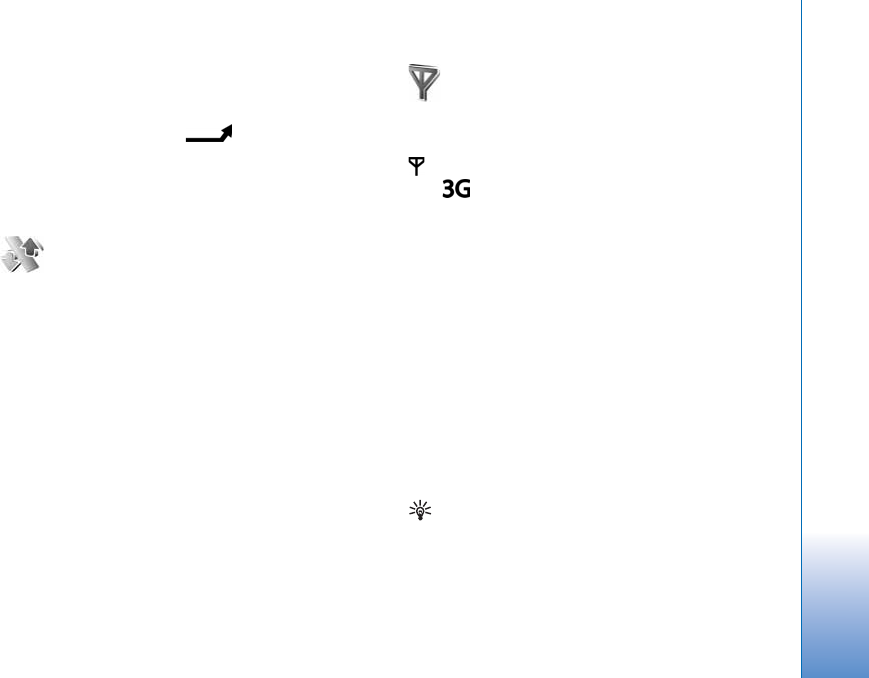
Tools
115
Copyright © 2006 Nokia. All rights reserved.
the option on (Activate) or off (Cancel), or check whether
the option is activated (Check status).
Several diverting options can be active at the same time.
When all calls are diverted, is shown in the
standby mode.
Call barring and call diverting cannot be active at the same
time.
Call barring
Call barring (network service) allows you to restrict the
calls that you make or receive with the device. To change
the settings, you need the barring password from your
service provider.
Select the desired barring option, and set it on (Activate)
or off (Cancel), or check whether the option is active
(Check status). Call barring affects all calls, including
data calls.
Call barring and call diverting cannot be active at the same
time.
When calls are barred, calls may be possible to the official
emergency number programmed into your device.
Network
Your device can automatically switch between the GSM
and UMTS networks. The GSM network is indicated with
in the standby mode. The UMTS network is indicated
with .
Network mode (shown only if supported by the network
operator)—Select which network to use. If you select Dual
mode, the device uses the GSM or UMTS network
automatically, according to the network parameters and
the roaming agreements between the network operators.
Contact your network operator for more details.
Operator selection—Select Automatic to set the device
to search for and select one of the available networks, or
Manual to manually select the network from a list of
networks. If the connection to the manually selected
network is lost, the device sounds an error tone and asks
you to reselect a network. The selected network must have
a roaming agreement with your home network, that is, the
operator whose SIM card is in your device.
Glossary: A roaming agreement is an agreement
between two or more network service providers to
enable the users of one service provider to use the
services of other service providers.

Tools
116 Copyright © 2006 Nokia. All rights reserved.
Cell info display—Select On to set the device to indicate
when it is used in a cellular network based on
microcellular network (MCN) technology and to activate
cell info reception.
Enhancement settings.
In the standby mode, indicates a compatible headset
is connected, and that the headset is unavailable, or
Bluetooth connectivity to a headset is lost. indicates
a compatible loopset is connected.
Select Headset, Loopset, or Bluetooth handsfree and
from the following:
Default profile—Set the profile that you want activated
each time you connect a certain enhancement to your
device. See ‘Profiles—set tones’, p. 98.
Automatic answer—Set whether you want the device to
answer an incoming call automatically after 5 seconds. If
the ringing type is set to Beep once or Silent, automatic
answer is disabled.
Lights (for car kit only)—Set whether lights remain on, or
are switched off after the time-out.
Voice commands
You can use voice commands to control your device. For
more information about the enhanced voice commands
supported by your device, see ‘Voice dialing’, p. 59.
To activate enhanced voice commands for starting
applications and profiles, you must open the Voice cm.
application and its Profiles folder. Press , and select
Tools > Voice cm. > Profiles; the device creates voice tags
for the applications and profiles. To use enhanced voice
commands, press and hold in the standby mode, and
say a voice command. The voice command is the name of
the application or profile displayed in the list.
To add more applications to the list, select Options > New
application. To add a second voice command that can be
used to start the application, select Options > Change
command, and enter the new voice command as text.
Avoid very short names, abbreviations, and acronyms.
To listen to the synthesized voice tag, select Options >
Playback.
To change voice command settings, select Options >
Settings. To switch off the synthesizer that plays
recognized voice tags and commands in the selected
device language, select Synthesiser > Off. To reset voice

Tools
117
Copyright © 2006 Nokia. All rights reserved.
recognition learning, for example, when the main user of
the device has changed, select Reset voice adapts..
Digital Rights Management
Content owners may use different types of digital rights
management technologies (DRM) to protect their
intellectual property including copyrights. This device uses
various types of DRM software to access DRM protected
content. With this device you can access content protected
with OMA 1.0 and OMA 2.0. If certain DRM software fails
to protect the content, content owners may ask the
software's ability to access the new content protected by
such DRM to be revoked. Revocation does not affect the
use of content that is already in your device.
To view activation keys for DRM protected content stored
in your device, press , and select Tools > Actv. keys and
from the following:
Valid keys—View keys that are connected to one or more
media files and keys whose validity period has not started
yet.
Invalid keys—View keys that are not valid; the time period
for using the media file is exceeded or there is a protected
media file in the device but no connected activation key.
Not in use—View keys that have no media files connected
to them in the device.
To buy more usage time or extend the usage period for a
media file, select an invalid activation key and Options >
Get activation key. Activation keys cannot be updated if
Web service message reception is disabled. See ‘Web
service messages’, p. 53.
To view detailed information, such as the validity status
and ability to send the file, scroll to an activation key, and
press the scroll key.
Memory card tool
Press , and select Tools > Memory. You can use a
compatible miniSD memory card as extra storage space
and for backing up the information in the device memory.
To back up information from the device memory to a
memory card, select Options > Backup phone mem.
To restore information from the memory card to the device
memory, select Options > Restore from card.
Format a memory card
When a memory card is reformatted, all data on the card
is permanently lost.

Tools
118 Copyright © 2006 Nokia. All rights reserved.
Some memory cards are supplied preformatted and
others require formatting. Consult your retailer to find
out if you must format the memory card before you can
use it.
To format a memory card, select Options > Format
mem. card. Select Yes to confirm.

Troubleshooting: Q&A
119
Copyright © 2006 Nokia. All rights reserved.
Troubleshooting: Q&A
Mobile TV
Q: Why can’t the device find any program guides?
A: Select Options > Settings to view System status. If there
is no signal strength or it is low, change location. Close and
reopen the Settings dialog to see if the signal is better.
Q: Why can’t I open a channel or program?
A: Select Options > Settings to view System status. If there
is no signal strength or it is low, change location. Close and
reopen the Settings dialog to see if the signal is better. If this
does not help, contact the service provider. Note also that the
service may not be available in your current location.
Q: Why are there are problems with picture quality?
A: In environments with a low quality AC supply voltage, the
picture may be degraded. To fix this, remove the charger from
the AC outlet. If that does not help, switch the device off and
on again, or remove and insert the battery.
Q: I tried to record a program but it failed. What went wrong?
A: Possible reasons:
• You maybe outside or on the limit of the Mobile TV
network coverage
• Other functions of the device have interrupted or
interfered the recoding.
Q: Why is the program guide showing wrong starting times
for programs?
A: The home city setting of your device is probably incorrect.
Open Clock, and press . Scroll to a city in your current time
zone, and select Options > My current city. The city is
displayed in the clock main view, and the time in your device
is changed according to the city selected. Check that the time
is correct and matches your time zone.
Access codes
Q: What is my password for the lock, PIN, or PUK codes?
A: The default lock code is 12345. If you forget or lose the
lock code, contact your device dealer.
If you forget or lose a PIN or PUK code, or if you have not
received such a code, contact your network operator.
For information about passwords, contact your access
point provider, for example, a commercial Internet service
provider (ISP), service provider, or network operator.
Application not responding
Q: How do I close an application that is not responding?
A: To open the application switching window, press and hold
. Scroll to the application, and press to close the
application.
Bluetooth connectivity

Troubleshooting: Q&A
120 Copyright © 2006 Nokia. All rights reserved.
Q: Why can’t I find my friend’s device?
A: Check that both devices have activated Bluetooth
connectivity.
Check that the distance between the two devices is not
over 10 meters (33 feet) and that there are no walls or
other obstructions between the devices.
Check that the other device is not in hidden mode.
Check that both devices are compatible.
Q: Why can’t I end a Bluetooth connection?
A: If another device is connected to your device, you can
either end the connection using the other device or by
deactivating Bluetooth connectivity. Select Connect. >
Bluetooth > Off.
Browser services
Q: What do I do if the following message is displayed: No
valid access point defined. Define one in Services
settings.?
A: Insert the correct browser settings. Contact your service
provider for instructions.
Camera
Q: Why do images look smudgy?
A: Remove the protective plastic film covering the display and
camera. Ensure that the camera lens protection window is
clean.
Display
Q: Why do missing, discolored, or bright dots appear on the
screen every time I turn on my device?
A: This is a characteristic of this type of display. Some displays
may contain pixels or dots that remain on or off. This is
normal, not a fault.
Home network (UPnP)
Q: Why can’t the other device see the files stored on my
device?
A: Ensure that you have configured the home network
settings, Content sharing is turned on in your device, and
the other device is UPnP compatible.
Log
Q: Why does the log appear empty?
A: You may have activated a filter, and no communication
events fitting that filter have been logged. To see all events,
select My own > Log. Scroll right to open the general log
and select Options > Filter > All communication.
Memory low
Q: What can I do if my device memory is low?
A: You can delete the following items regularly to avoid
memory getting low:
• Messages from Inbox, Drafts, and Sent folders
in Messag.
• Retrieved e-mail messages from the device
memory

Troubleshooting: Q&A
121
Copyright © 2006 Nokia. All rights reserved.
• Saved browser pages
• Images and photos in Gallery
To delete contact information, calendar notes, call timers,
call cost timers, game scores, or any other data, go to the
respective application to remove the data. If you are
deleting multiple items and one of the following notes are
shown: Not enough memory to perform operation.
Delete some data first. or Memory low. Delete some
data., try deleting items one by one (starting from the
smallest item).
Q: How can I save my data before deleting it?
A: Save your data using one of the following methods:
• Use Nokia PC Suite to make a back-up copy of all
data to a compatible computer.
• Send images to your e-mail address, then save
the images to your computer.
• Send data using Bluetooth connectivity to a
compatible device.
• Store data on a compatible memory card.
Messaging
Q: Why can’t I select a contact?
A: The contact card does not have a phone number or an
e-mail address. Add the missing information to the contact
card in Contacts.
Multimedia messaging
Q: What should I do when the device cannot receive a
multimedia message because memory is full?
A: The amount of memory needed is indicated in the error
message: Not enough memory to retrieve message.
Delete some data first. To view what kind of data you
have and how much memory the different data groups
consume, press , and select File manager > Options >
Memory details.
Q: The note Retrieving message is shown briefly. What is
happening?
A: The device is trying to retrieve a multimedia message from
the multimedia messaging center.
Check that the settings for multimedia messaging are
defined correctly and that there are no mistakes in phone
numbers or addresses. Select Messaging > Options >
Settings > Multim. msg..
Q: How can I end the data connection when the device starts
a data connection again and again?
A: To stop the device from making a data connection, select
Messaging > Settings > Multimedia retrieval and one of
the following:
Manual—to have the multimedia messaging center save
messages to be retrieved later. You receive a notification
when there is a new multimedia message that you can
retrieve in the multimedia message center.
Off—to ignore all incoming multimedia messages. After

Troubleshooting: Q&A
122 Copyright © 2006 Nokia. All rights reserved.
this change, the device does not make any network
connections related to multimedia messaging.
PC connectivity
Q: Why do I have problems in connecting the device to my
PC?
A: Ensure that Nokia PC Suite is installed and running on your
compatible PC. See the user guide for Nokia PC Suite on
the CD-ROM. For further information on how to use Nokia
PC Suite, see the help function on Nokia PC Suite or visit
the support pages at www.nokia.com.
Q: Can I use my device as a fax modem with a compatible PC?
A: You cannot use your device as a fax modem. However, with
call diverting (network service), you can divert incoming
fax calls to another phone number.
Wireless LAN
Q: Why can't I see a wireless LAN (WLAN) access point even
though I know I'm within its range?
A: The WLAN access point may use a hidden service set
identifier (SSID). You can only access networks that use a
hidden SSID if you know the correct SSID and have created
a WLAN Internet access point for the network on your
Nokia device.
Q: How do I switch WLAN off on my Nokia device?
A: You cannot switch off WLAN on your Nokia device. To
reduce battery consumption, you can specify that your
Nokia device does not scan for available networks.
To turn off the background scan:
1Press , and select Tools > Settings >
Connection > Wireless LAN.
2Select Scan for networks > Never.
3To save your changes, select Back.
When Scan for networks is set to Never, your Nokia
device still listens to available networks, and you can use
available WLAN networks as usual.

Battery information
123
Copyright © 2006 Nokia. All rights reserved.
Battery information
Charging and discharging
Your device is powered by a rechargeable battery. The full
performance of a new battery is achieved only after two or
three complete charge and discharge cycles. The battery can
be charged and discharged hundreds of times but it will
eventually wear out. When the talk and standby times are
noticeably shorter than normal, replace the battery. Use only
Nokia approved batteries, and recharge your battery only with
Nokia approved chargers designated for this device.
If a replacement battery is being used for the first time or if
the battery has not been used for a prolonged period, it may
be necessary to connect the charger then disconnect and
reconnect it to begin charging the battery.
Unplug the charger from the electrical plug and the device
when not in use. Do not leave fully charged battery connected
to a charger, since overcharging may shorten its lifetime. If left
unused, a fully charged battery will lose its charge over time.
If the battery is completely discharged, it may take a few
minutes before the charging indicator appears on the display
or before any calls can be made.
Use the battery only for its intended purpose. Never use any
charger or battery that is damaged.
Do not short-circuit the battery. Accidental short-circuiting
can occur when a metallic object such as a coin, clip, or pen
causes direct connection of the positive (+) and negative (-)
terminals of the battery. (These look like metal strips on the
battery.) This might happen, for example, when you carry a
spare battery in your pocket or purse. Short-circuiting the
terminals may damage the battery or the connecting object.
Leaving the battery in hot or cold places, such as in a closed
car in summer or winter conditions, will reduce the capacity
and lifetime of the battery. Always try to keep the battery
between 15°C and 25°C (59°F and 77°F). A device with a hot
or cold battery may not work temporarily, even when the
battery is fully charged. Battery performance is particularly
limited in temperatures well below freezing.
Do not dispose of batteries in a fire as they may explode.
Batteries may also explode if damaged. Dispose of batteries
according to local regulations. Please recycle when possible.
Do not dispose as household waste.
Nokia battery authentication
guidelines
Always use original Nokia batteries for your safety. To check
that you are getting an original Nokia battery, purchase it
from an authorized Nokia dealer, look for the Nokia Original
Enhancements logo on the packaging and inspect the
hologram label using the following steps:
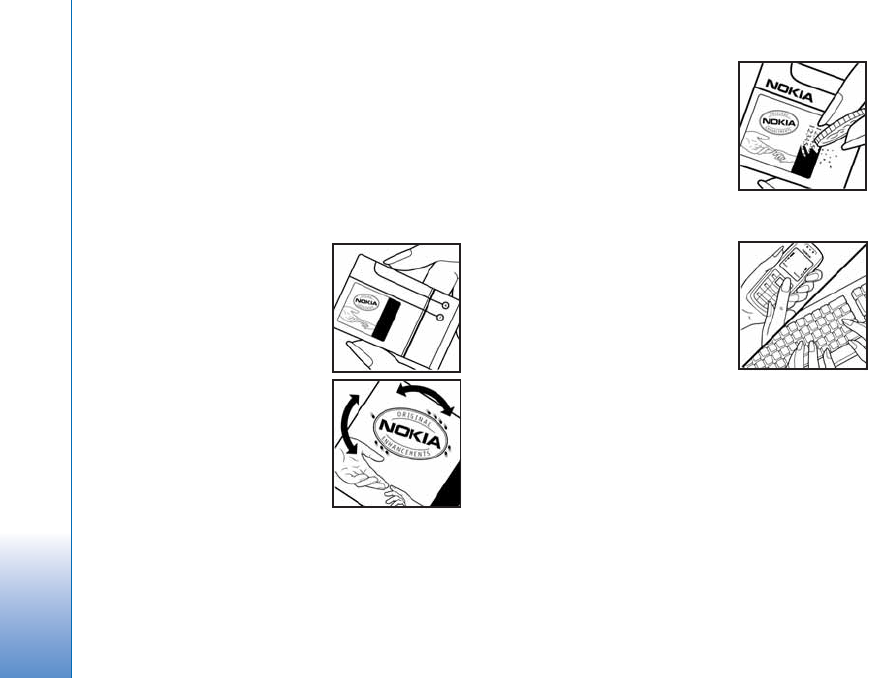
Battery information
124 Copyright © 2006 Nokia. All rights reserved.
Successful completion of the four steps is not a total
assurance of the authenticity of the battery. If you have any
reason to believe that your battery is not an authentic original
Nokia battery, you should refrain from using it, and take it to
the nearest authorized Nokia service point or dealer for
assistance. Your authorized Nokia service point or dealer will
inspect the battery for authenticity. If authenticity cannot be
verified, return the battery to the place of purchase.
Authenticate hologram
1When looking at the hologram on
the label, you should see the
Nokia connecting hands symbol
from one angle and the Nokia
Original Enhancements logo
when looking from another angle.
2When you angle the hologram
left, right, down, and up, you
should see 1, 2, 3, and 4 dots on
each side respectively.
3Scratch the side of the label to
reveal a 20-digit code, for example
12345678919876543210. Turn
the battery so that the numbers
are facing upwards. The 20-digit
code reads starting from the
number at the top row followed by
the bottom row.
4Confirm that the 20-digit code is
valid by following the instructions
at www.nokia.com/batterycheck.
To create a text message enter the
20-digit code, for example,
12345678919876543210, and send to
+44 7786 200276.
National and international operator charges will apply.
You should receive a message indicating whether the code can
be authenticated.
What if your battery is not authentic?
If you cannot confirm that your Nokia battery with the
hologram on the label is an authentic Nokia battery, please do
not use the battery. Take it to the nearest authorized Nokia
service point or dealer for assistance. The use of a battery that
is not approved by the manufacturer may be dangerous and
may result in poor performance and damage to your device

Battery information
125
Copyright © 2006 Nokia. All rights reserved.
and its enhancements. It may also invalidate any approval or
warranty applying to the device.
To find out more about original Nokia batteries, visit
www.nokia.com/battery.

Care and maintenance
126 Copyright © 2006 Nokia. All rights reserved.
Care and maintenance
Your device is a product of superior design and craftsmanship
and should be treated with care. The suggestions below will
help you protect your warranty coverage.
• Keep the device dry. Precipitation, humidity, and all types
of liquids or moisture can contain minerals that will
corrode electronic circuits. If your device does get wet,
remove the battery, and allow the device to dry
completely before replacing it.
• Do not use or store the device in dusty, dirty areas. Its
moving parts and electronic components can be damaged.
• Do not store the device in hot areas. High temperatures
can shorten the life of electronic devices, damage
batteries, and warp or melt certain plastics.
• Do not store the device in cold areas. When the device
returns to its normal temperature, moisture can form
inside the device and damage electronic circuit boards.
• Do not attempt to open the device other than as
instructed in this guide.
• Do not drop, knock, or shake the device. Rough handling
can break internal circuit boards and fine mechanics.
• Do not use harsh chemicals, cleaning solvents, or strong
detergents to clean the device.
• Do not paint the device. Paint can clog the moving parts
and prevent proper operation.
• Use a soft, clean, dry cloth to clean any lenses, such as
camera, proximity sensor, and light sensor lenses.
• Use only the supplied or an approved replacement
antenna. Unauthorized antennas, modifications, or
attachments could damage the device and may violate
regulations governing radio devices.
• Use chargers indoors.
• Always create a backup of data you want to keep (such as
contacts and calendar notes) before sending your device to
a service facility.
• To reset the device from time to time for optimum
performance, power off the device, and remove the
battery. Make back-up copies of all important data.
All of the above suggestions apply equally to your device,
battery, charger, or any enhancement. If any device is not
working properly, take it to the nearest authorized service
facility for service.

Additional safety information
127
Copyright © 2006 Nokia. All rights reserved.
Additional safety information
Your device and its enhancements may contain small parts.
Keep them out of the reach of small children.
Operating environment
Remember to follow any special regulations in force in any
area, and always switch off your device when its use is
prohibited or when it may cause interference or danger. Use
the device only in its normal operating positions. This device
meets RF exposure guidelines when used either in the normal
use position against the ear or when positioned at least 1.5
centimeters (5/8 inches) from the body. When a carry case,
belt clip, or holder is used for body-worn operation, it should
not contain metal and should position the device the above-
stated distance from your body.
To transmit data files or messages, this device requires a
quality connection to the network. In some cases, transmission
of data files or messages may be delayed until such a
connection is available. Ensure that the above separation
distance instructions are followed until the transmission is
completed.
Parts of the device are magnetic. Metallic materials may be
attracted to the device. Do not place credit cards or other
magnetic storage media near the device, because information
stored on them may be erased.
Medical devices
Operation of any radio transmitting equipment, including
wireless phones, may interfere with the functionality of
inadequately protected medical devices. Consult a physician
or the manufacturer of the medical device to determine if
they are adequately shielded from external RF energy or if you
have any questions. Switch off your device in health care
facilities when any regulations posted in these areas instruct
you to do so. Hospitals or health care facilities may be using
equipment that could be sensitive to external RF energy.
Pacemakers Pacemaker manufacturers recommend that a
minimum separation of 15.3 centimeters (6 inches) be
maintained between a wireless phone and a pacemaker to
avoid potential interference with the pacemaker. These
recommendations are consistent with the independent
research by and recommendations of Wireless Technology
Research. Persons with pacemakers should do the following:
• Always keep the device more than 15.3 centimeters (6
inches) from their pacemaker
• Not carry the device in a breast pocket
• Hold the device to the ear opposite the pacemaker to
minimize the potential for interference.
If you suspect interference, switch off your device, and move
the device away.

Additional safety information
128 Copyright © 2006 Nokia. All rights reserved.
Hearing aids Some digital wireless devices may interfere
with some hearing aids. If interference occurs, consult your
service provider.
Vehicles
RF signals may affect improperly installed or inadequately
shielded electronic systems in motor vehicles such as
electronic fuel injection systems, electronic antiskid (antilock)
braking systems, electronic speed control systems, and air bag
systems. For more information, check with the manufacturer,
or its representative, of your vehicle or any equipment that
has been added.
Only qualified personnel should service the device, or install
the device in a vehicle. Faulty installation or service may be
dangerous and may invalidate any warranty that may apply to
the device. Check regularly that all wireless device equipment
in your vehicle is mounted and operating properly. Do not
store or carry flammable liquids, gases, or explosive materials
in the same compartment as the device, its parts, or
enhancements. For vehicles equipped with an air bag,
remember that air bags inflate with great force. Do not place
objects, including installed or portable wireless equipment in
the area over the air bag or in the air bag deployment area. If
in-vehicle wireless equipment is improperly installed, and the
air bag inflates, serious injury could result.
Using your device while flying in aircraft is prohibited. Switch
off your device before boarding an aircraft. The use of wireless
teledevices in an aircraft may be dangerous to the operation
of the aircraft, disrupt the wireless telephone network, and
may be illegal.
Potentially explosive environments
Switch off your device when in any area with a potentially
explosive atmosphere, and obey all signs and instructions.
Potentially explosive atmospheres include areas where you
would normally be advised to turn off your vehicle engine.
Sparks in such areas could cause an explosion or fire resulting
in bodily injury or even death. Switch off the device at
refueling points such as near gas pumps at service stations.
Observe restrictions on the use of radio equipment in fuel
depots, storage, and distribution areas; chemical plants; or
where blasting operations are in progress. Areas with a
potentially explosive atmosphere are often, but not always,
clearly marked. They include below deck on boats, chemical
transfer or storage facilities, vehicles using liquefied
petroleum gas (such as propane or butane), and areas where
the air contains chemicals or particles such as grain, dust or
metal powders.
Emergency calls
Important: Wireless phones, including this device,
operate using radio signals, wireless networks, landline
networks, and user-programmed functions. Because of this,
connections in all conditions cannot be guaranteed. You
should never rely solely on any wireless device for essential
communications like medical emergencies.

Additional safety information
129
Copyright © 2006 Nokia. All rights reserved.
To make an emergency call:
1If the device is not on, switch it on. Check for adequate
signal strength.
Some networks may require that a valid SIM card is
properly inserted in the device.
2Press the end key as many times as needed to clear the
display and ready the device for calls.
3Enter the official emergency number for your present
location. Emergency numbers vary by location.
4Press the call key.
If certain features are in use, you may first need to turn those
features off before you can make an emergency call. Consult
this guide or your service provider for more information.
When making an emergency call, give all the necessary
information as accurately as possible. Your wireless device
may be the only means of communication at the scene of an
accident. Do not end the call until given permission to do so.
Certification information (SAR)
This mobile device meets guidelines for exposure to radio
waves.
Your mobile device is a radio transmitter and receiver. It is
designed not to exceed the limits for exposure to radio waves
recommended by international guidelines. These guidelines
were developed by the independent scientific organization
ICNIRP and include safety margins designed to assure the
protection of all persons, regardless of age and health.
The exposure guidelines for mobile devices employ a unit of
measurement known as the Specific Absorption Rate or SAR.
The SAR limit stated in the ICNIRP guidelines is 2.0 watts/
kilogram (W/kg) averaged over 10 grams of tissue. Tests for
SAR are conducted using standard operating positions with
the device transmitting at its highest certified power level in
all tested frequency bands. The actual SAR level of an
operating device can be below the maximum value because
the device is designed to use only the power required to reach
the network. That amount changes depending on a number of
factors such as how close you are to a network base station.
The highest SAR value under the ICNIRP guidelines for use of
the device at the ear is 0.92 W/kg.
Your mobile device is also designed to meet the requirements
for exposure to radio waves established by the Federal
Communications Commission (USA) and Industry Canada.
These requirements set a SAR limit of 1.60 W/kg averaged
over 1 gram of tissue. The highest SAR value reported under
this standard during product certification for use at the ear is
0.24 W/kg and when properly worn on the body is 0.60 W/kg.
Information about this device model can be found at http://
www.fcc.gov/oet/fccid by searching the equipment
authorization system using FCC ID: LJPRM-100.
Use of device accessories and enhancements may result in
different SAR values. SAR values may vary depending on
national reporting and testing requirements and the network
band. Additional SAR information may be provided under
product information at www.nokia.com.

130 Copyright © 2006 Nokia. All rights reserved.
Index
A
access points 108
activation keys 117
active standby mode 100
alarms 20
alarm clock 15
B
backing up 117
Bluetooth 81
device address 83
headset 116
pairing 83
security 82
sending data 83
switching off 84
bookmarks 65
C
cache, clearing 67
calendar
creating entries 69
synchronizing PC Suite 69
call log
See log
calls
barring 115
dialed calls
diverting 114
duration 63
international 58
missed calls
received calls
settings 107
transferring 62
camera
adjusting lighting and color 24,26
flash 26
image setup settings 26
imaging mode 10
saving video clips 28
self-timer 26
sending images 25
sequence mode 26
still image camera settings 27
video recorder settings 29
video setup settings 26
certificates 113
channel packages
subscribing 21
channels
subscribing 21
chat
See instant messaging
clear screen
See standby mode
clock
alarm 15
settings 15
codes
lock code 113
PIN code 112
PIN2 code 113
security code 113
computer connections 93
conference call 58
connection settings 108
contact cards
adding 55
inserting pictures 55
sending 55
storing DTMF tones 62
copying contacts 56
copyright protection
see activation keys

131
Copyright © 2006 Nokia. All rights reserved.
D
data connections
details 88
ending 89
indicators 13
date 15
device manager 89
digital rights management, DRM
see activation keys
E
e-mail
automatic retrieving 49
opening 49
remote mailbox 48
retrieving from mailbox 48
sending 44
settings 52
viewing attachments 49
F
file formats
.jad 102
.jar 102
.sis 102
RealPlayer 36
file manager 101
fixed dialing 56
FM radio 38
full screen 19
G
gallery 30
ordering files in albums 33
presentations 32
guides
programme guides 19,20
guides, programme guides 21
H
handsfree
see loudspeaker
headset settings 116
help application 17
I
icons 23
indicators 13
installing applications 102
instant messaging
blocking 73
connecting to a server 71
recording messages 73
sending instant messages 72
Internet
See Web
Internet access points (IAP)
See access points
J
Java
See applications
Java applications 102
L
lock code 113
log
call duration 63
recent calls
log duration 64
loopset settings 116
loudspeaker 15
M
mailbox 48
mailbox, automatic retrieving 49
media files
fast forward 36
file formats 36
mute sound 36
rewind 36
memory
clearing memory 63,101
viewing memory consumption 101
memory card 117
menu, rearranging 98
messaging
e-mail 45

132 Copyright © 2006 Nokia. All rights reserved.
multimedia messages 45
text messages 45
Mobile TV
indicators 23
program guide 19
recording 20
searching programs 21
services 19
settings 22
starting 18
subscribing to programs 21
viewing 18
watching recordings 21
modes
fold closed 9
fold open 10
imaging 10
view mode 10
multimedia messages 45
music player 34
mute sound 36
O
office applications 95
P
packet data settings 111
PC connections 93
PC Suite
calendar data 69
synchronization 93
transferring music files to your
memory card 34
viewing device memory data 101
personalization 99
phonebook
See contact cards
PIN code 112
profiles 98
programme guides 19,20,21
programmes
alarms 20
details 20
viewing 18
Q
Quickoffice 95
R
radio 38
reminders 20
remote mailbox 48
remote SIM mode 82
ringing tones
personal 57
personal ringing tone 57
receiving in a text message 47
S
security code
See lock code 113
sending
contact cards, business cards 55
images 25
service commands 43
Services
See Web
services 19
settings
access codes 112
access points 108
age limit 22
Bluetooth connectivity 82
calendar 70
call barring 115
call diverting 114
certificates 113
data connections 108
date and time 111
display 107
IM 71,73
language 105
lock code 113
original 106
personalizing the phone 98
PIN code 112

133
Copyright © 2006 Nokia. All rights reserved.
screen saver 107
UPIN code 112
UPUK code 113
shortcuts 11
SIM card
copying names and numbers to
phone 56
messages 50
names and numbers 56
sis file 102
snooze 15
software, transferring a file to your
device 102
sound clips 30
sounds
muting a ringing tone 61
recording sounds 41
speed dialing 59
standby mode 98
status indicators 23
subscribing
channel packages 21
channels 21
svg files 32
synchronization 85
T
text messages 45
themes 99
time 15
To 28
transferring content from another
device 12
U
Universal Plug and Play 90
UPIN code 112
UPUK code 113
USSD commands 43
V
video call
answering 61
making 60
rejecting 61
video clips 30
video player
See RealPlayer
viewing
programmes 18
services 19
Visual Radio
viewing content 39
visual service ID 39
voice commands 116
voice dialing 59
voice mailbox 58
changing the phone number 58
diverting calls to voice mailbox
114
voice messages 58
voice tags 59,116
volume 19
volume control 15
W
Web
access points, see access points
browser 65
wireless LAN 87
access point settings 109
creatong IAP 87
security 90
see also Universal Plug and Play
Z
zooming 19